Posts Tagged: cooking
Samgyetang
What is samgyetang?
Samgyetang is ginseng chicken soup. “Sam” for insam (인삼), the Korean word for ginseng; “gye” refers to chicken; “tang”(탕) is a soup. It is a hearty and delicious soup that tastes great during chilly months. It is also surprisingly popular during the hottest days of the year in Korea where eating steaming hot food is believed to have a cooling effect on the body.
My first time…
The first time I ate this soup was on a chilly afternoon in Seogwipo City on Jeju Island. Hungry and cold, I was wandering around an area known for restaurants. It was the off-season so many restaurants were closed and most others were serving Jeju black pig samgyeopsal, something that is difficult to eat on your own. Feeling defeated, I decided to go to a nearby convenience store to at least buy some kimbap. On my way I spotted a small house with a sign that simply said “삼계탕” (samgyetang) but this little house didn’t look like a restaurant at all.
When I cracked the door open to peek inside, I was surprised to see an older woman sitting on the floor in front of her sofa, watching TV. I quickly apologized and tried to leave, but she got up and gestured for me to come inside. Hardly knowing any Korean, I simply said “samgyetang”? She nodded and gestured for me to sit on the sofa. She unfolded a small square table in front of me and then disappeared. I sat alone in this room, watching TV and silently wondering if I had made some kind of a mistake. But, a few minutes later, she came back smiling and put 2 or 3 dishes of simple banchan on the table in front of me. And, a little after that, she came back with a steaming black earthenware bowl containing a single small chicken in a bubbling broth.
I ate this delicious steaming meal as fast as I could without burning my mouth. The woman seemed pleased when she saw all the empty plates. I gestured to pay, she accepted my money with a nod and a smile and I was on my way.
That meal seems like a mystery to me to this day. Was it really a restaurant? Was it a dream? It seemed like some kind of a magical chapter in a book. Someday I will return to investigate. These are the best kinds of travel experiences. There is something deeply lonely about traveling by yourself, but I think that it also opens many doors that may not have otherwise materialized at all. Like the door to this little house where I first ate samgyetang on a chilly afternoon on Jeju Island, perched on the edge of a sofa watching TV.
Ingredients
I made this recipe in a single large pot with a small whole chicken to eat family style. If you prefer, you can also make 2 separate portions out of this using the same amount of ingredients and 2 Cornish hens instead. It looks prettier when you serve each person their own whole bird and it is a lot less messy. Chickens are quite a bit less expensive and easier to find than Cornish hens so this is what I usually use.
- 1 small to medium chicken (or 2 cornish hens)
- 15-20 whole cloves of garlic
- 2 fresh ginseng roots
- 4 dried red dates (jujubes/daechu)
- 1 cup short grain rice (you can substitute with glutinous rice/chapssal)
- 2 green onions
- salt and pepper
I am always able to find fresh ginseng at Asian grocers. Same goes for red dates: you may see these called Chinese red dates, jujubes or daechu (대추).
***At the end of the soup recipe there is a recipe for dipping sauce to go with it. Scroll to the bottom for that one. You can make it while your chicken is cooking.
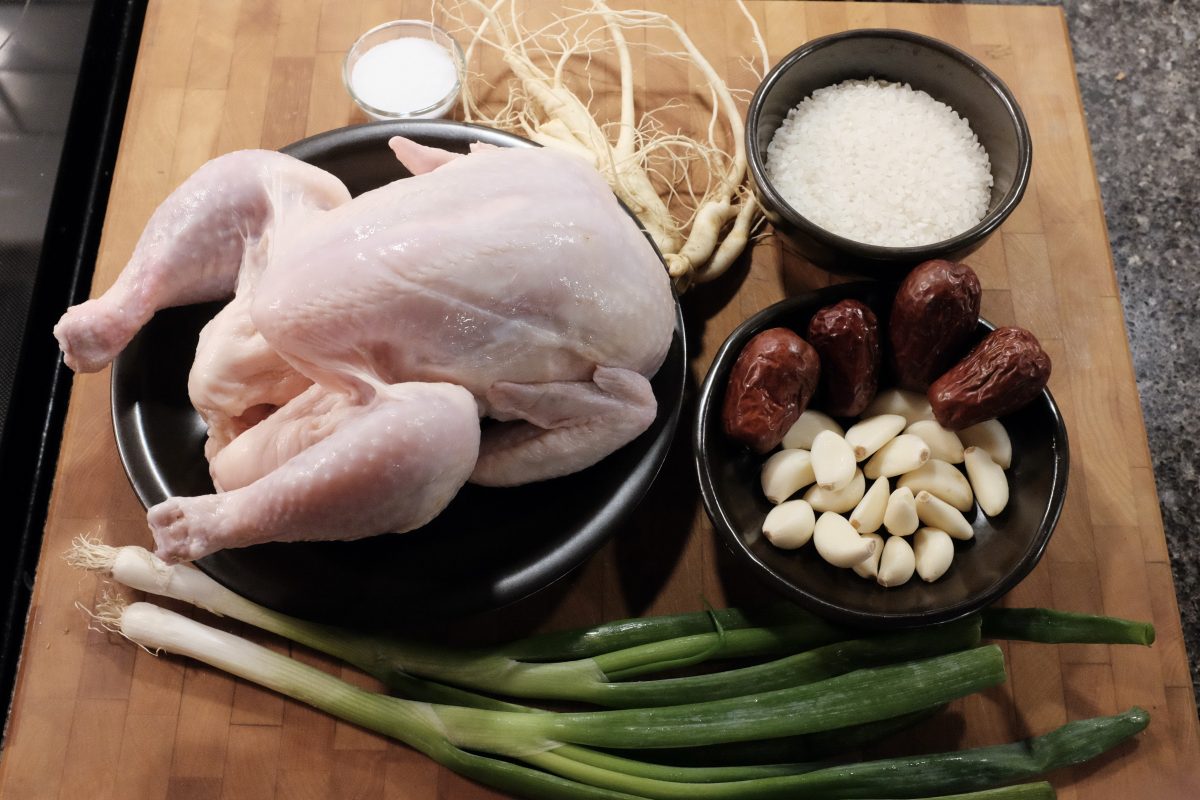
Process
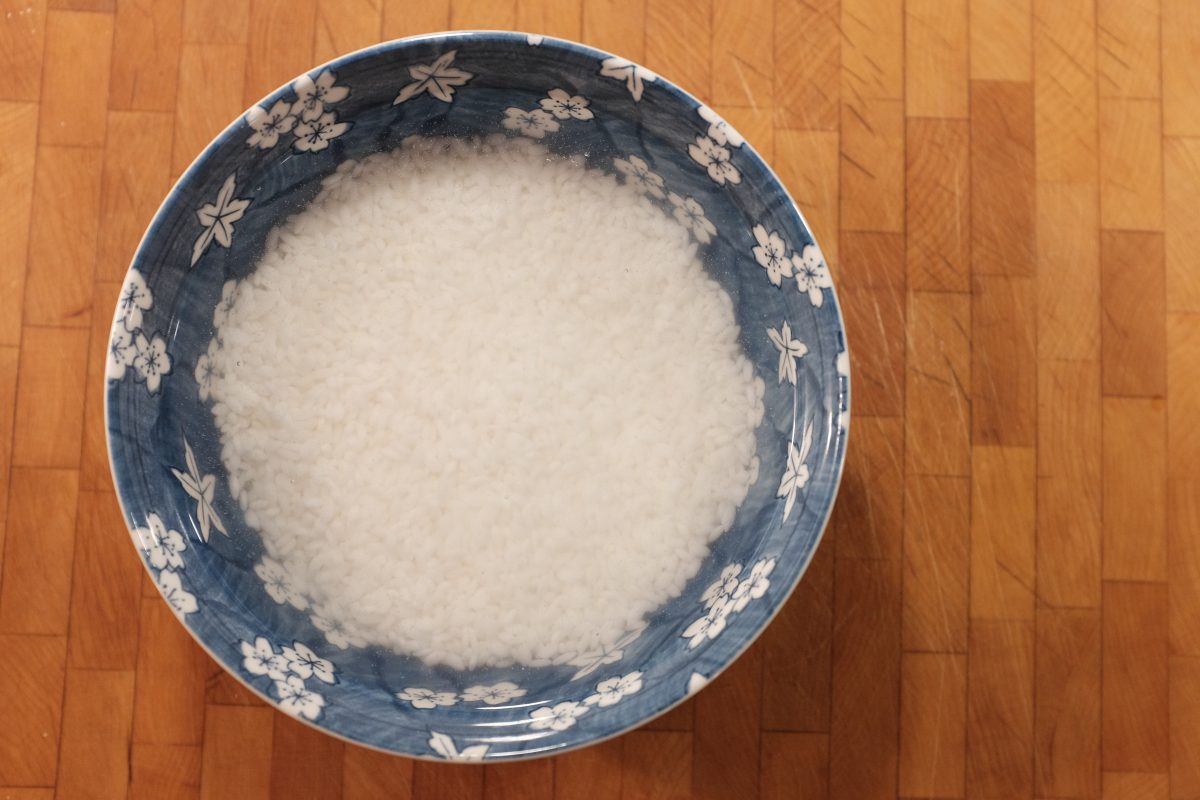
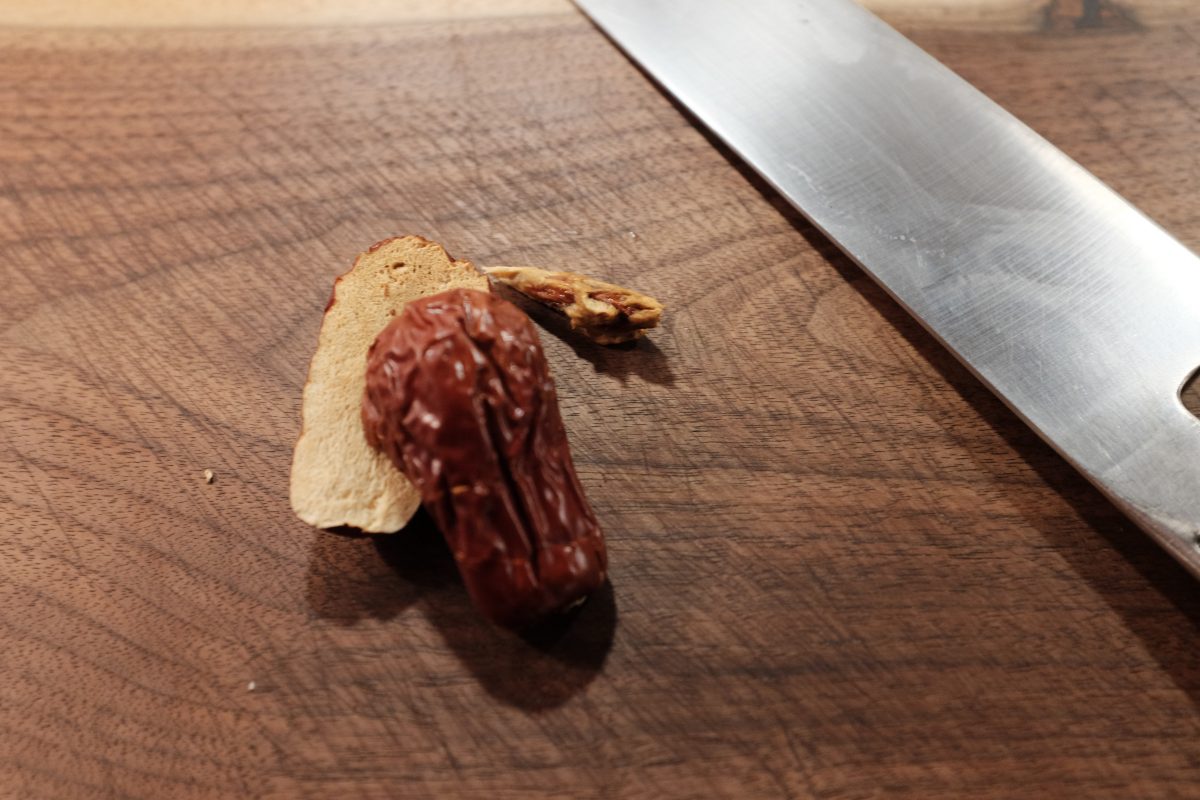
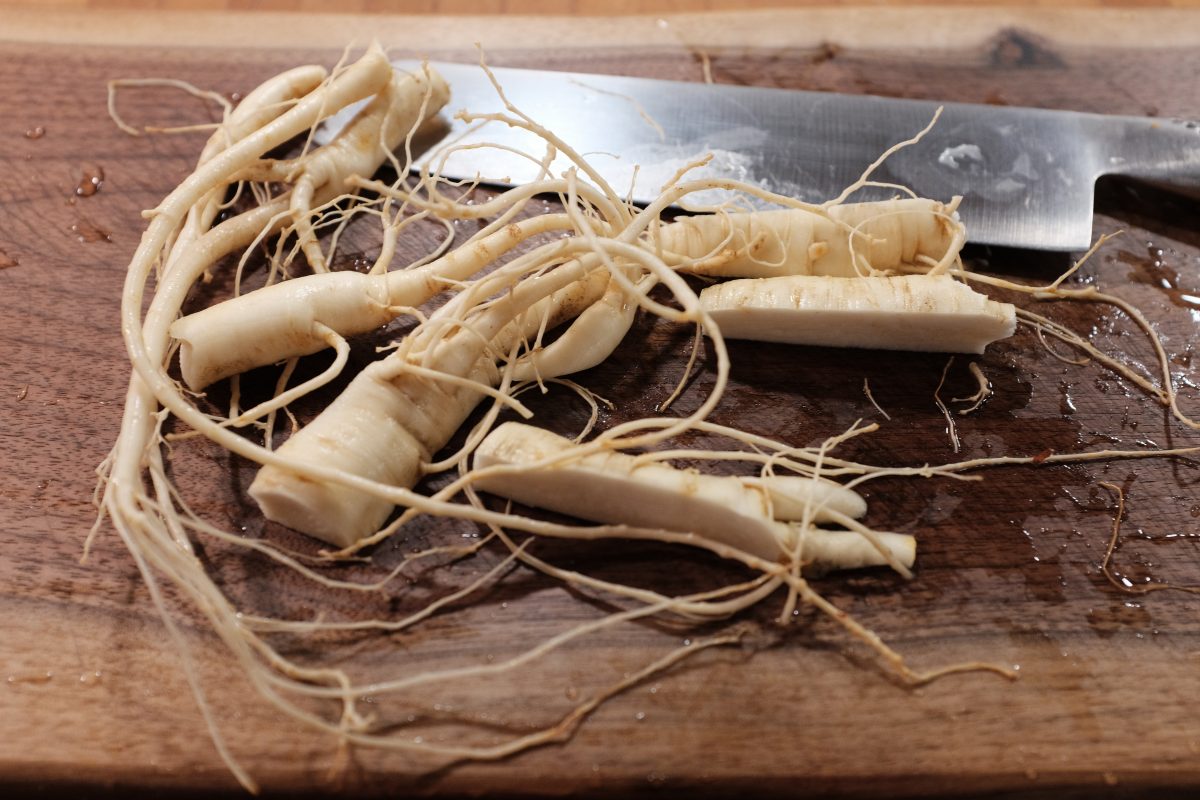
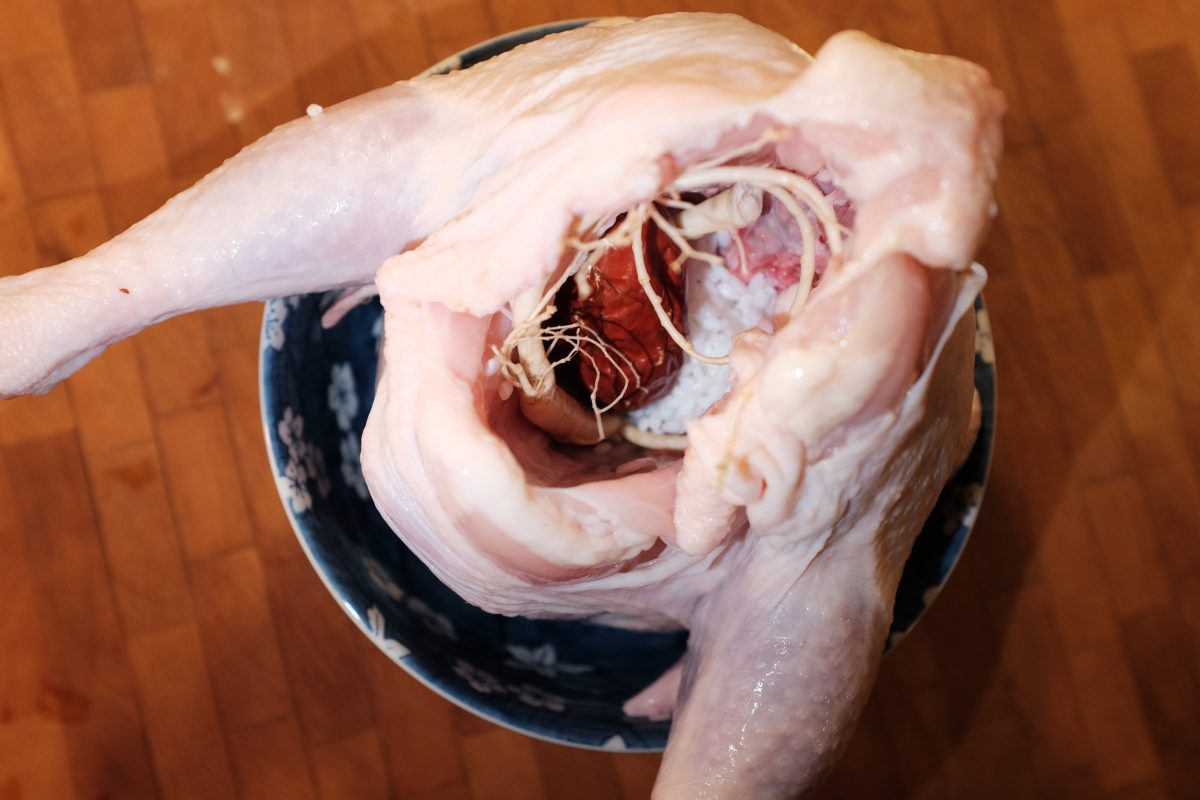
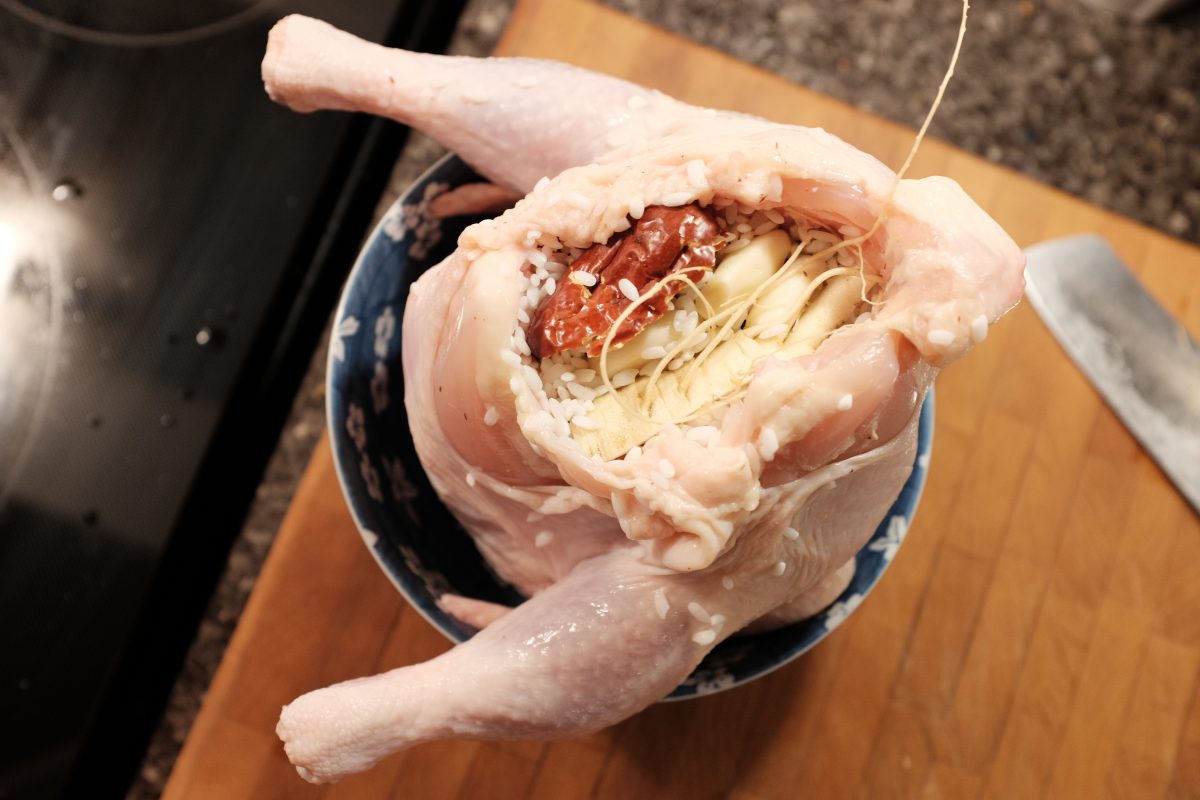
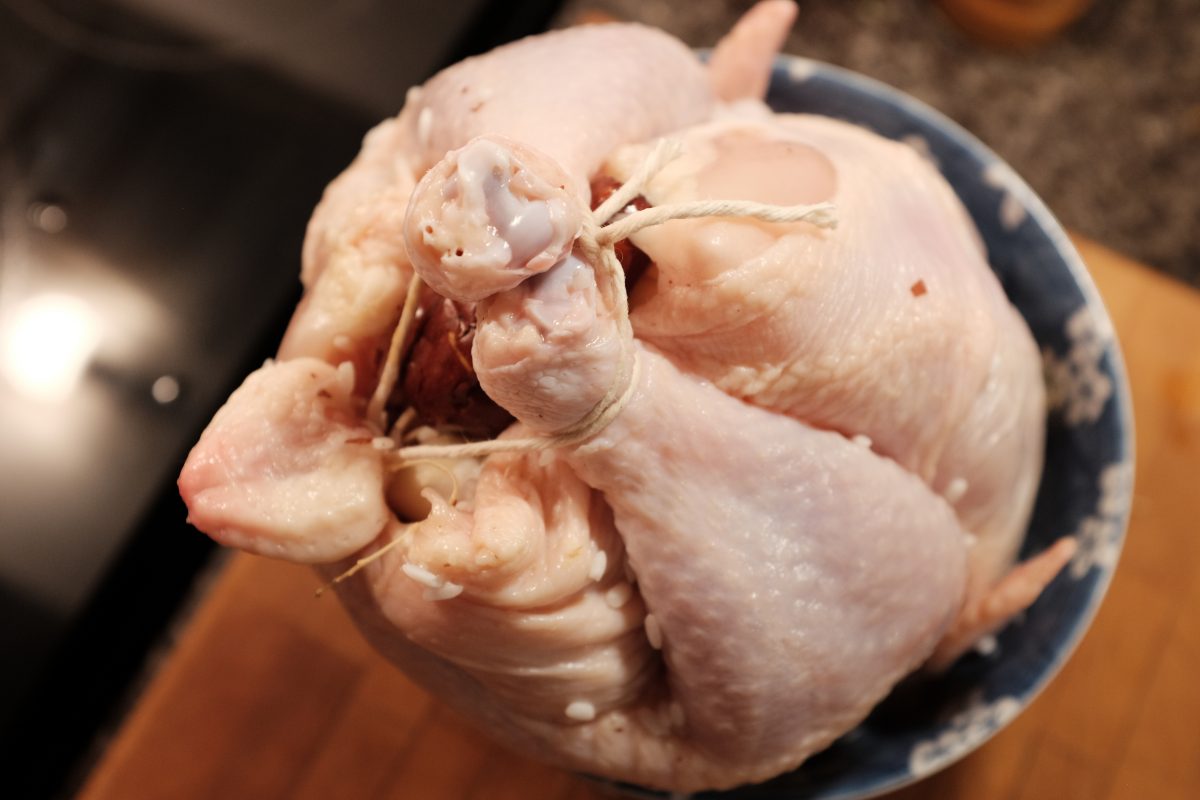
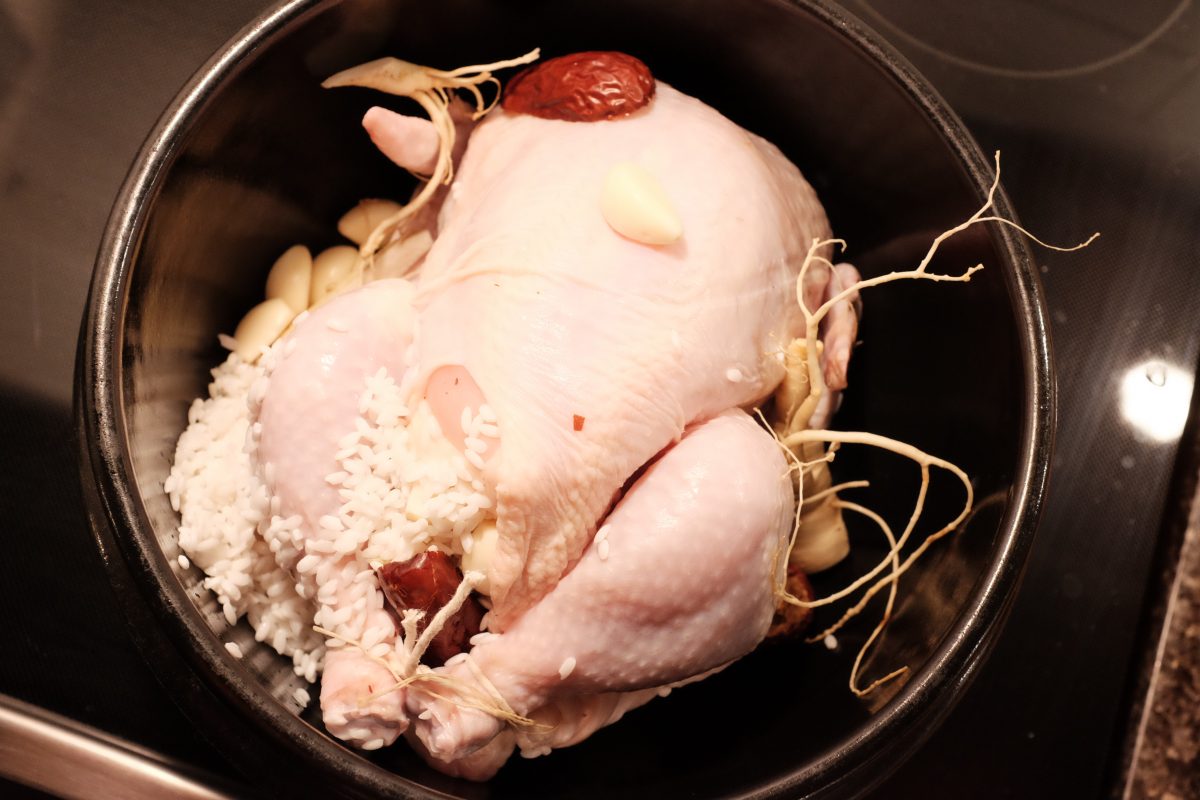
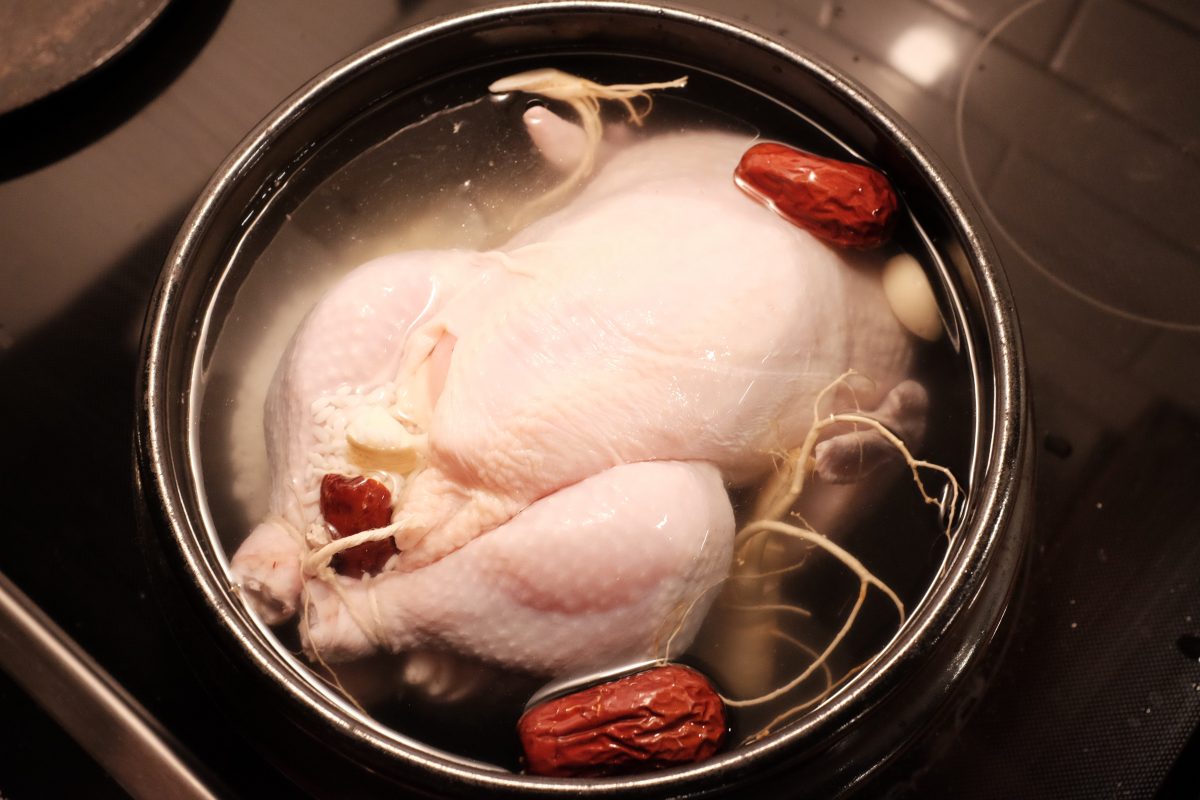
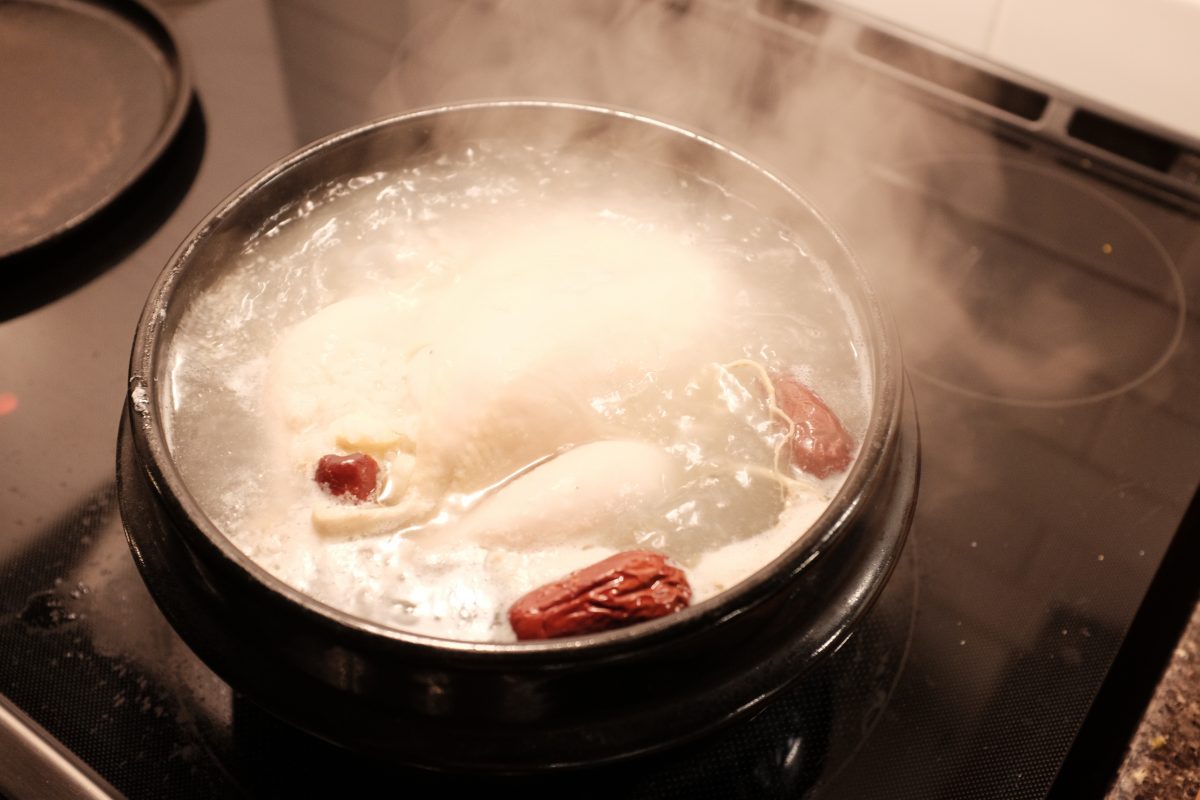
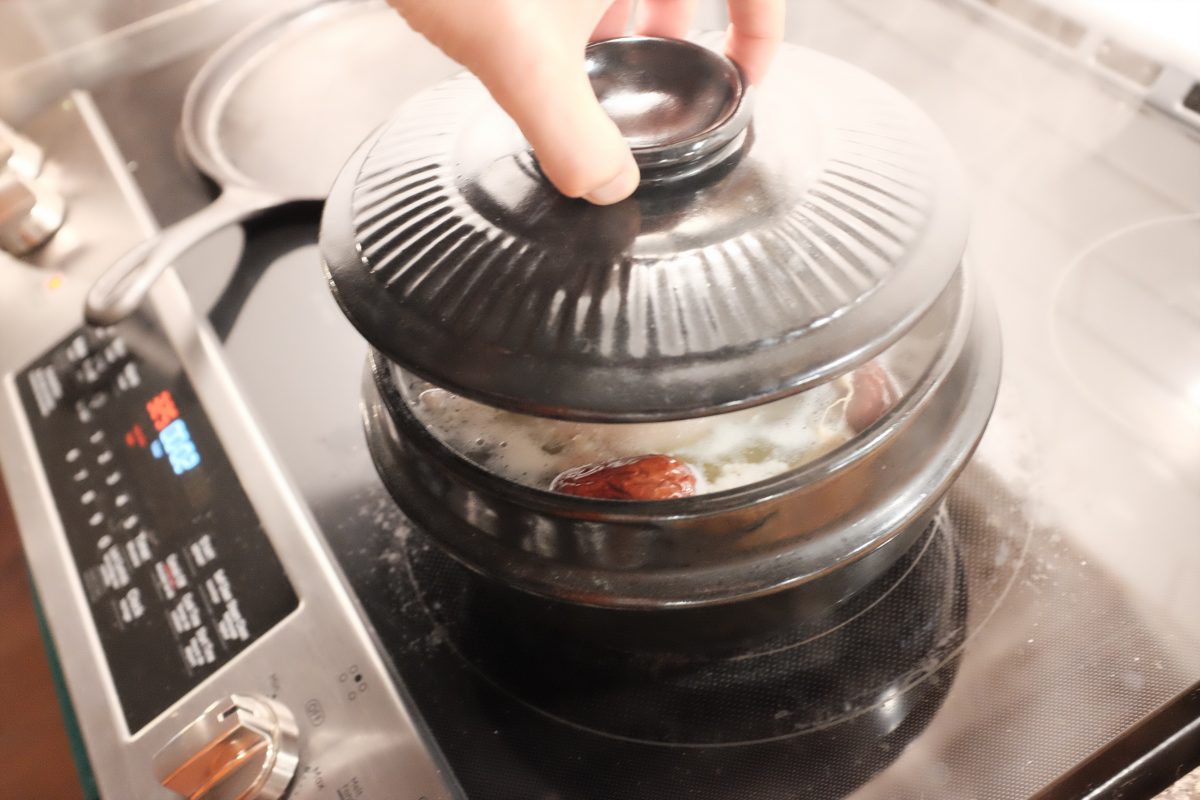
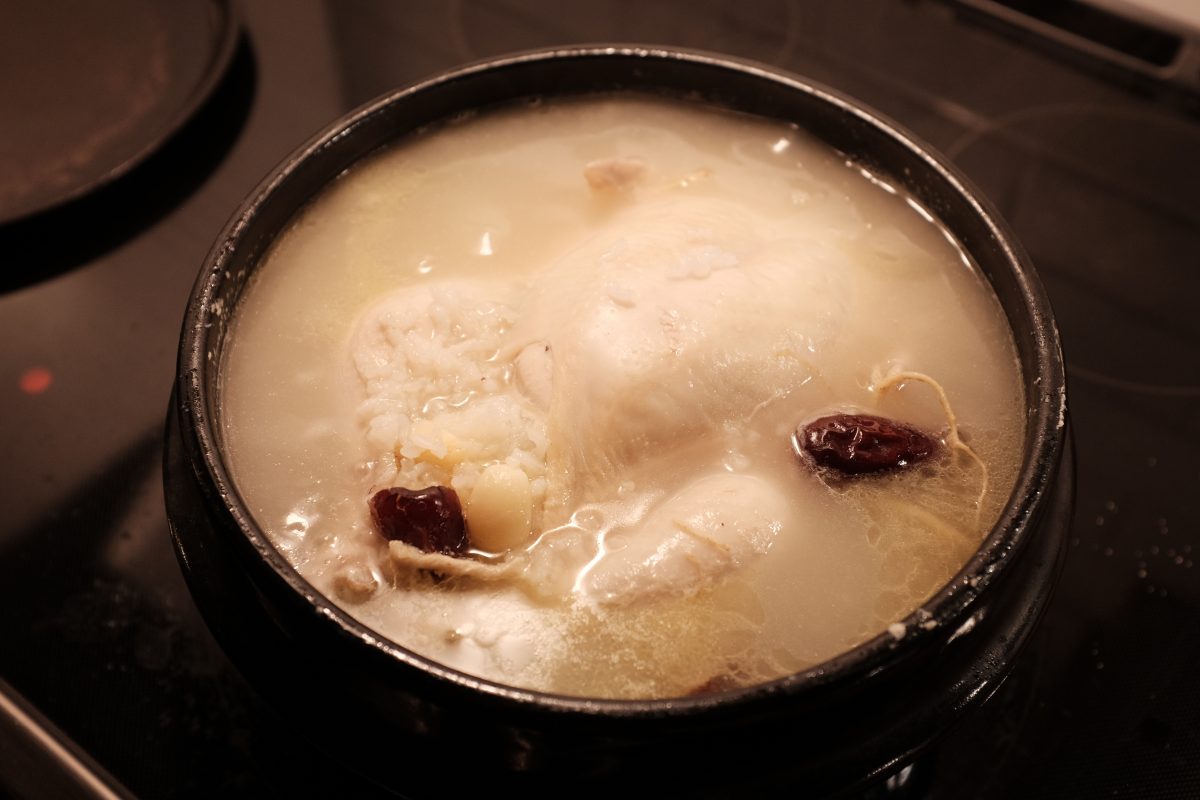
Serving
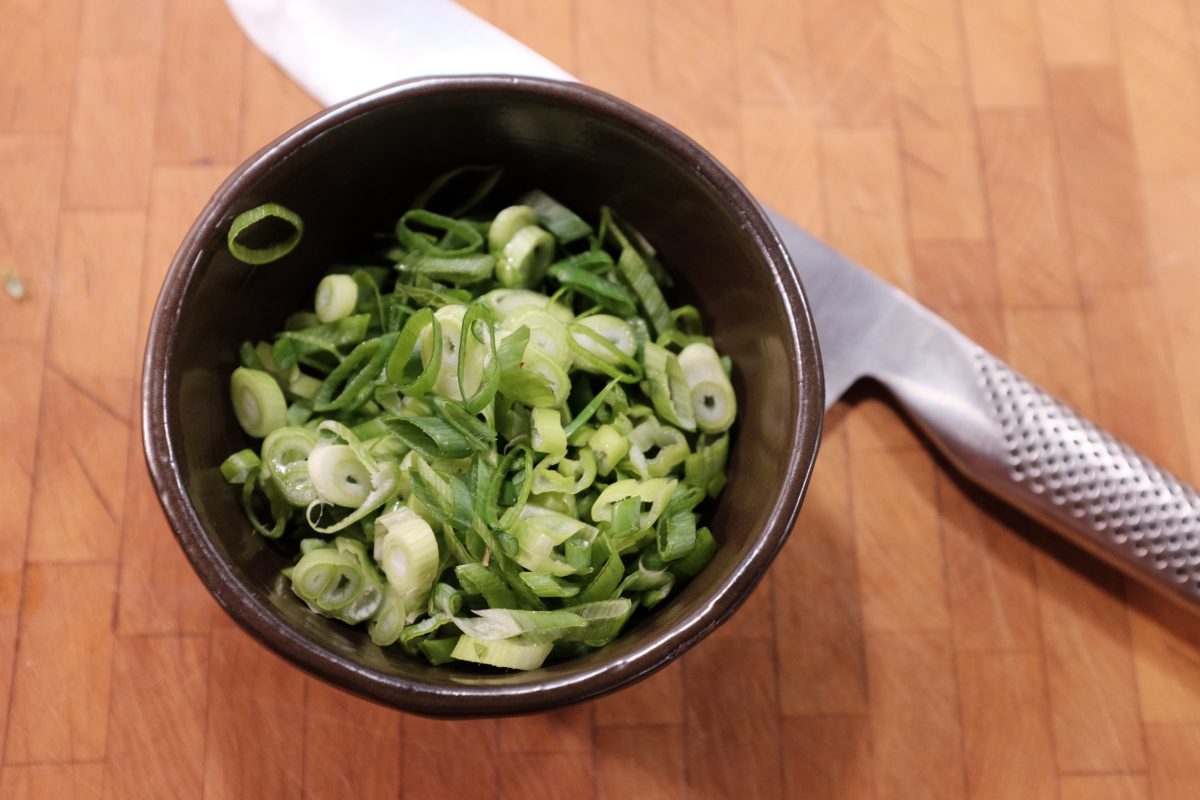
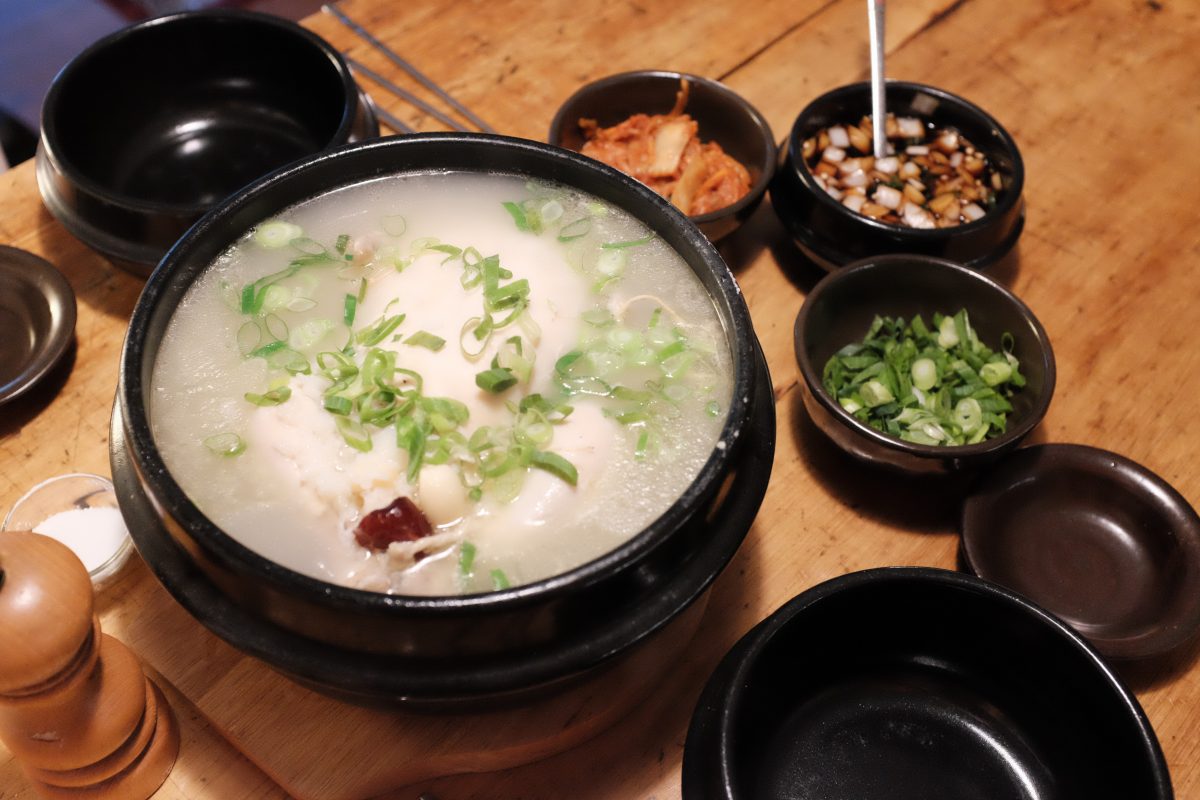
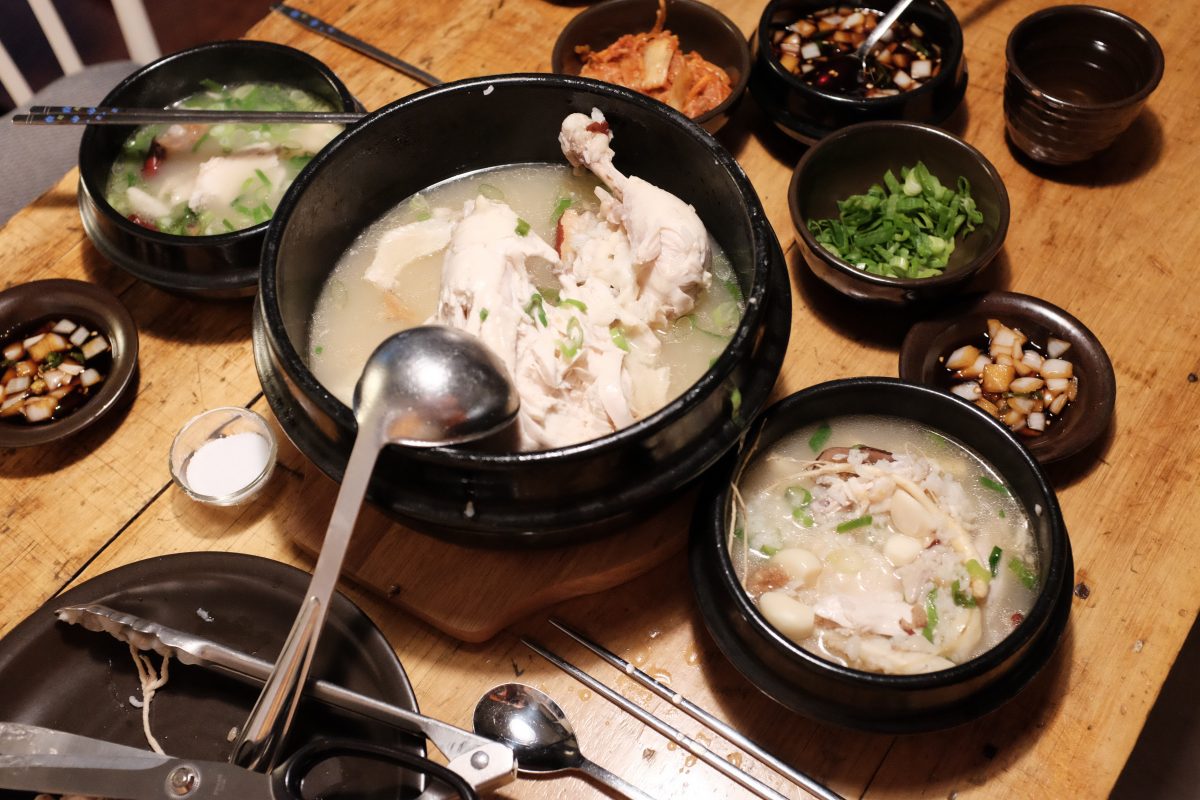
Soy and vinegar dipping sauce
Ingredients
- 100ml (around 6 tablespoons) brewed soy sauce
- 50ml (around 3 tablespoons) white vinegar
- 12-13gr (1 tablespoon) white sugar
- 1/2 medium white onion
- 1 green long chile or jalapeño
I like regular harsh white vinegar for this recipe. You can substitute rice vinegar or apple cider vinegar but I would avoid using wine vinegars. Use regular brewed (Japanese style) soy sauce, not Korean soup soy sauce. Use an equal amount of honey if you prefer it over white sugar. You can leave out the chili altogether but, I would recommend just taking the seeds out if you don’t want any spice. The “greenness” of the chili adds alot of flavour here.
Process
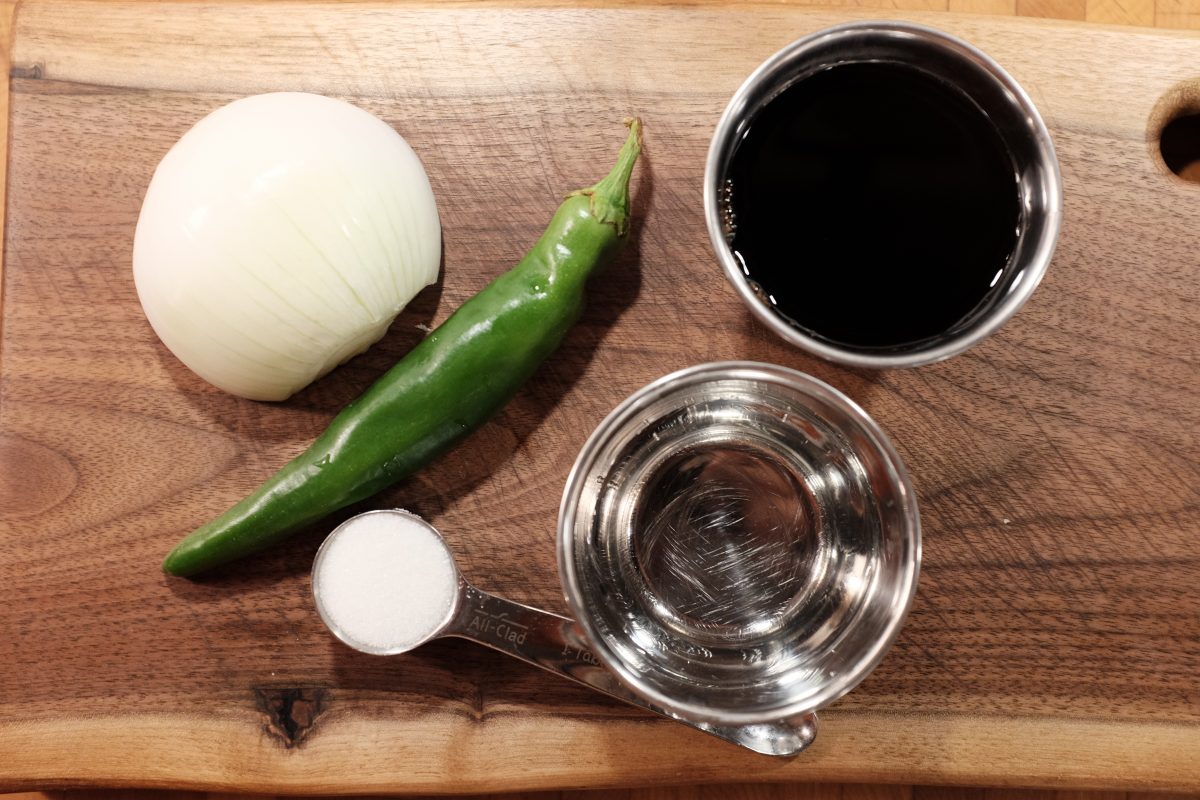
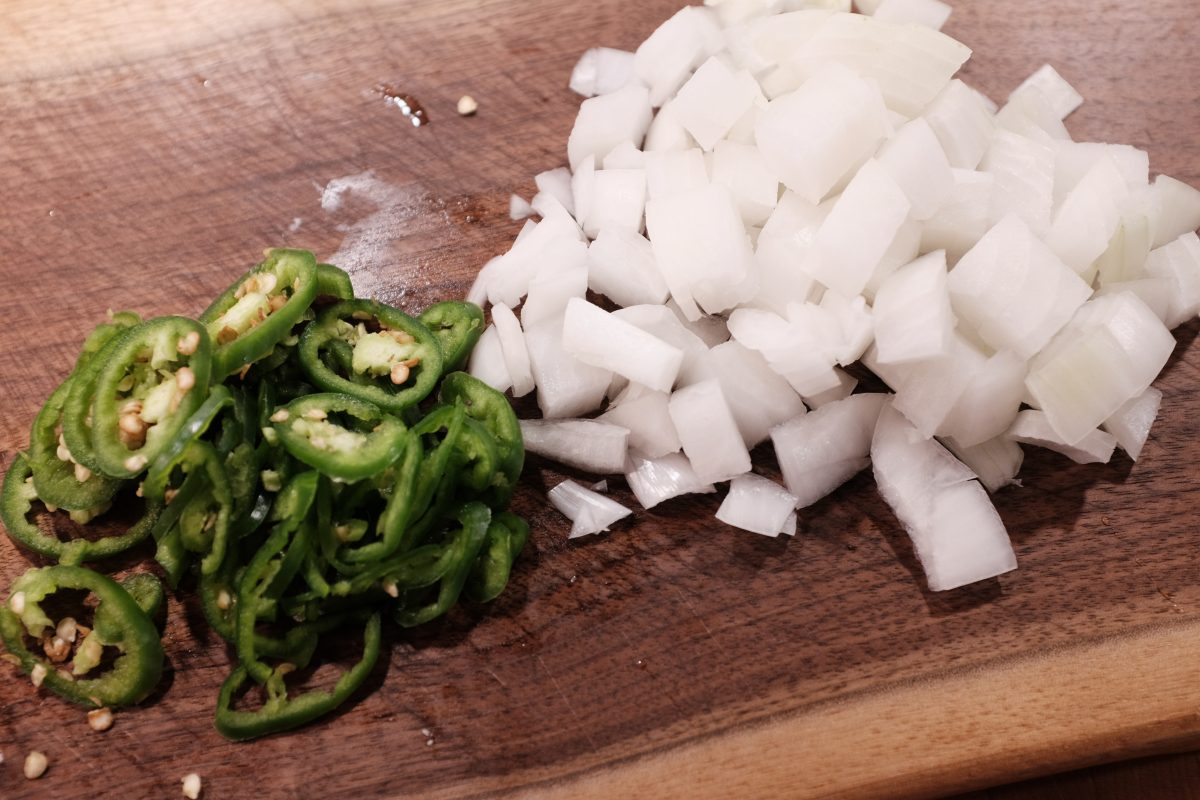
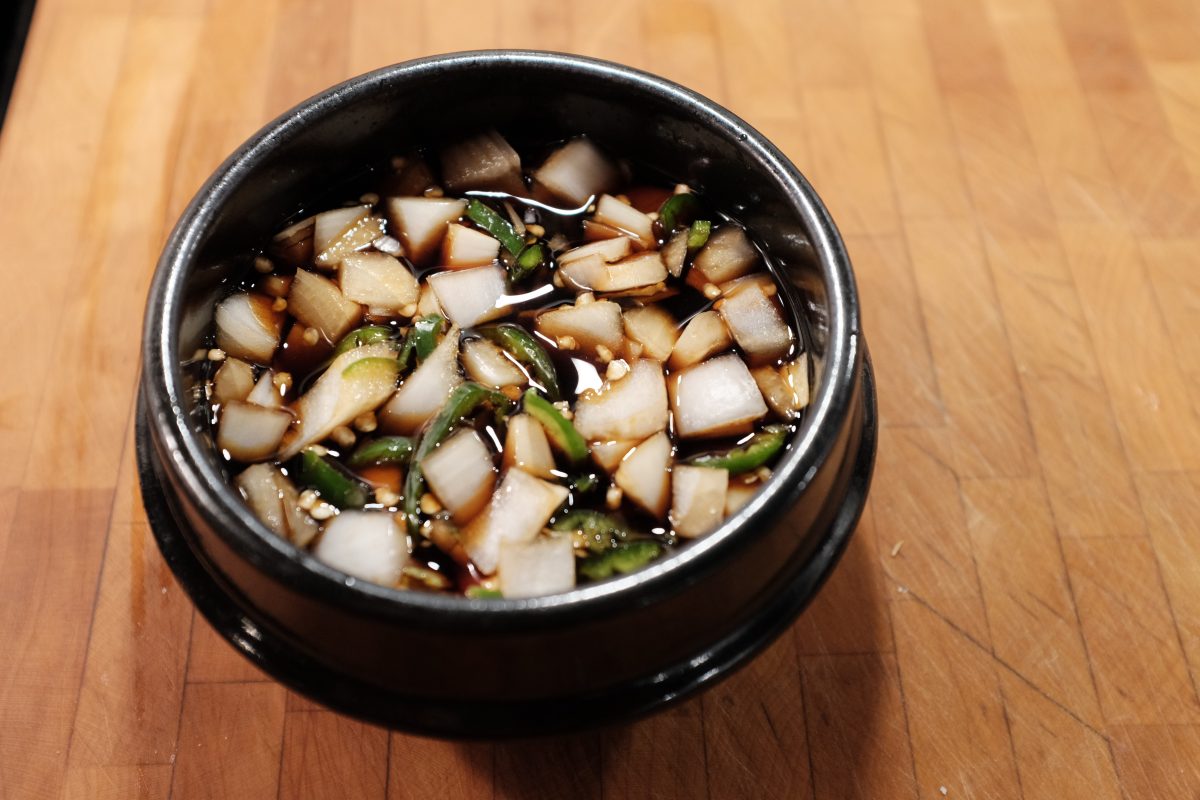
This is one of my favourite soups. Hot and satisfying, it is especially good when you are feeling a little sick or run down. It is one of those meals that seems to instantly fortify the body much like my other favourite seolleongtang.
If you need a homemade kimchi recipe to go with any of your Korean cooking, click here.
If you have any comments or questions, please leave them below. Thanks for reading.
Vegan Napa Cabbage Kimchi
This is a tested recipe for anyone who does not eat meat, anyone with shrimp allergies or anyone who does not like the fishy taste of fish sauce. Once this recipe ferments, you will have a tasty vegan kimchi that you can use just like any other kimchi. It is a variation on a cut kimchi recipe that I posted previously. If you are interested in making a kimchi with all the seafood included or if you are interested in more information about kimchi in general, you can find that by clicking here.
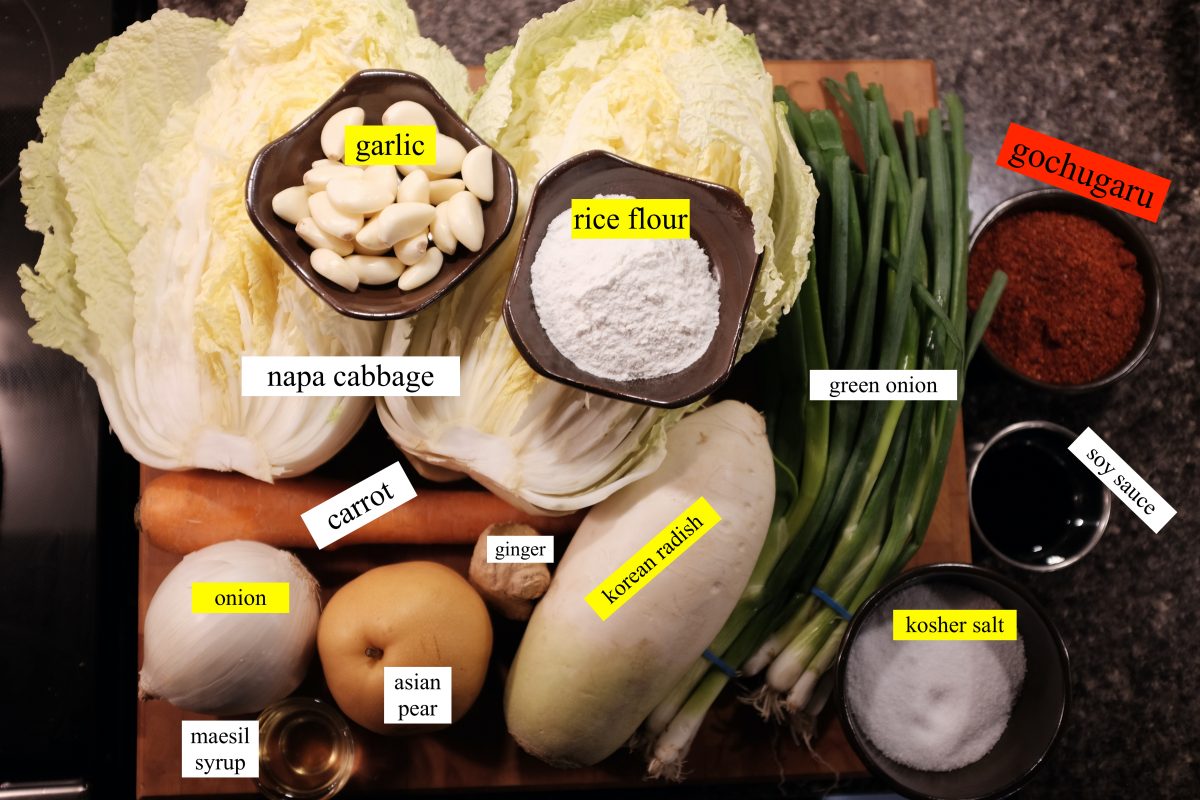
Ingredients
- 1 large (2kg) Napa Cabbage
- 80 grams/3oz (around 1/2 cup) Diamond Kosher Crystal salt for brining
- up to 2 Tablespoons kosher salt for seasoning (not for brining…save this for later)
- 1 tablespoon soy sauce
- 275ml (1 1/2 cups) water
- 1/4 cup rice flour
- 1 tablespoon white sugar or maesil plum syrup
- 1/2 cup peeled garlic cloves (around 20)
- 1 tablespoon ginger peeled and sliced
- 1 white onion peeled and chopped
- 1 asian pear or apple peeled and chopped
- 1/4 up to 1 cup (30-120 grams) korean chili flakes (gochugaru)
- 2 bunches (12 or so) green onions sliced
- 1 cup carrot matchsticks
- 1 cup korean radish matchsticks
Try to weigh your salt rather than measuring by cups. Diamond Kosher is a popular salt in my area. If you live in the US, you may be using Morton’s. This salt is much saltier by the cup. Same goes for sea salt if this is what you are using. Whichever salt you use, it is better to weigh it. Avoid using table salt.
Rice flour/rice powder is just finely ground sweet rice. Mochiko is a popular brand but any brand will work.
Korean chili flakes are all very different from batch to batch. Some are mild and fruity and some are sharp and very spicy. It is better to start with less, taste, and then add more if you want it spicier.
Process
Cabbage preparation
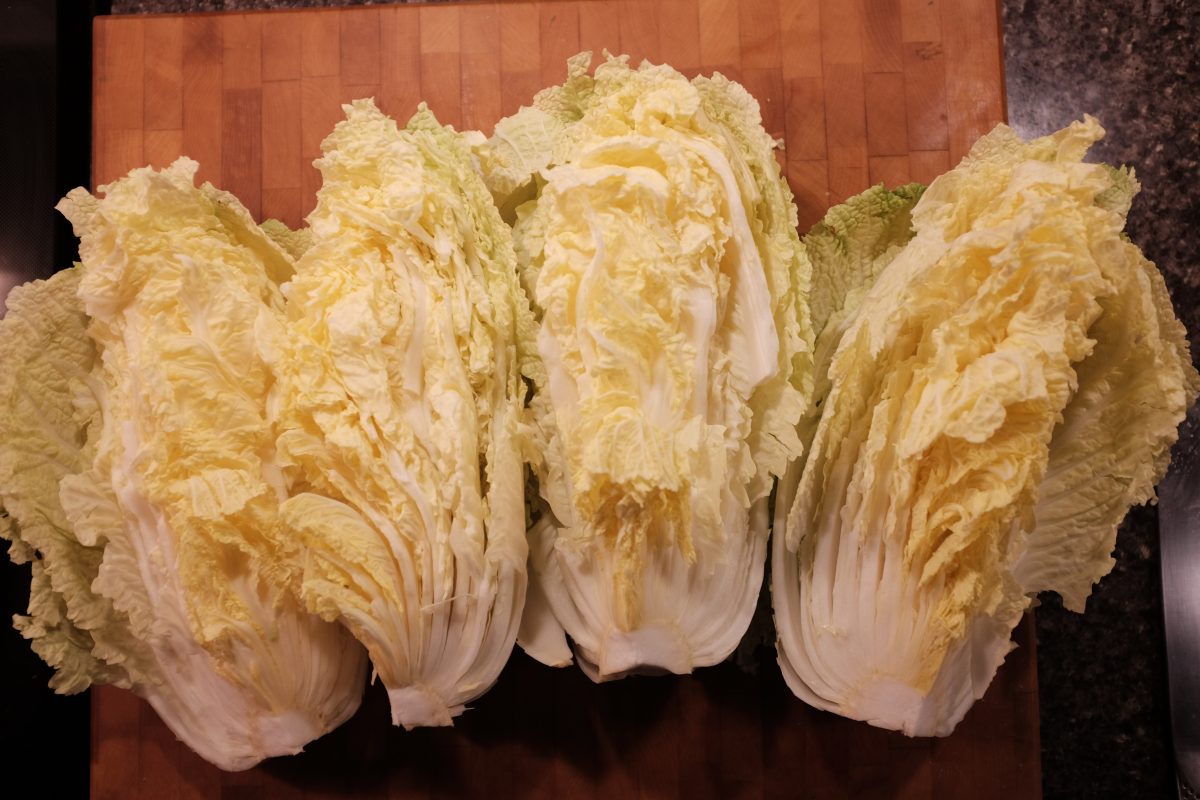
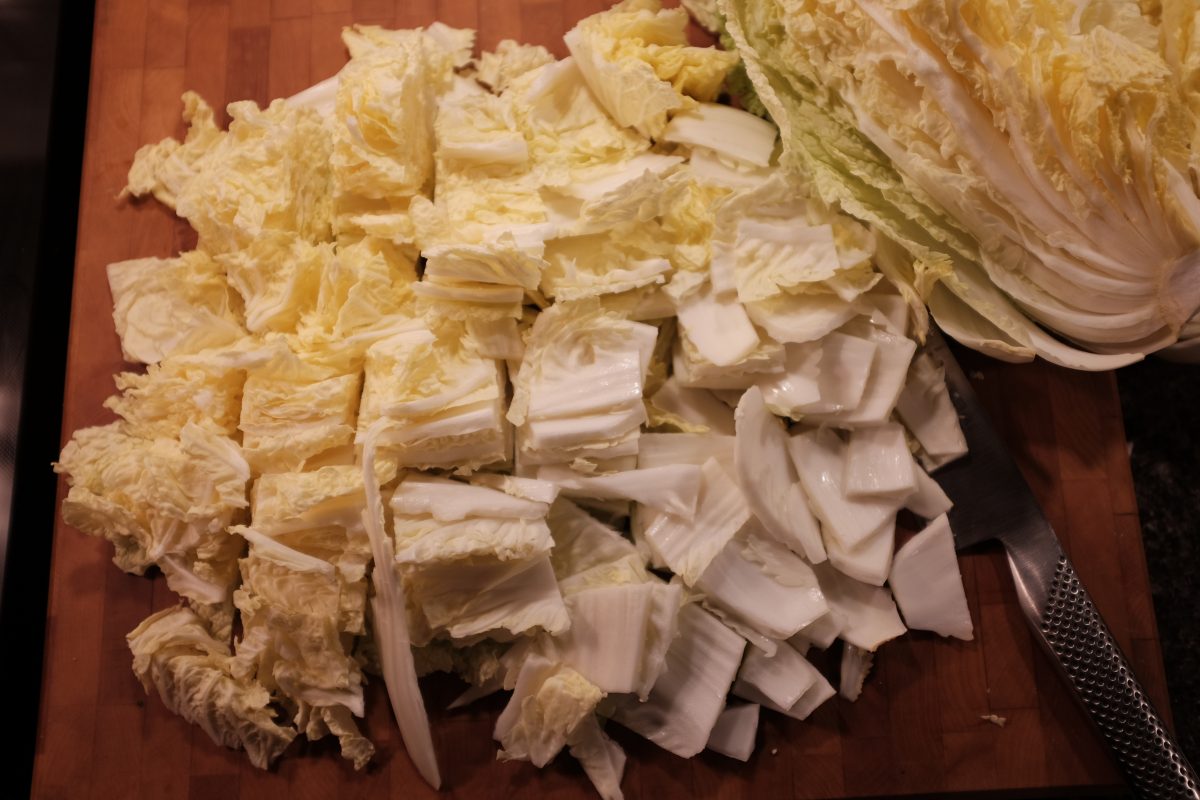
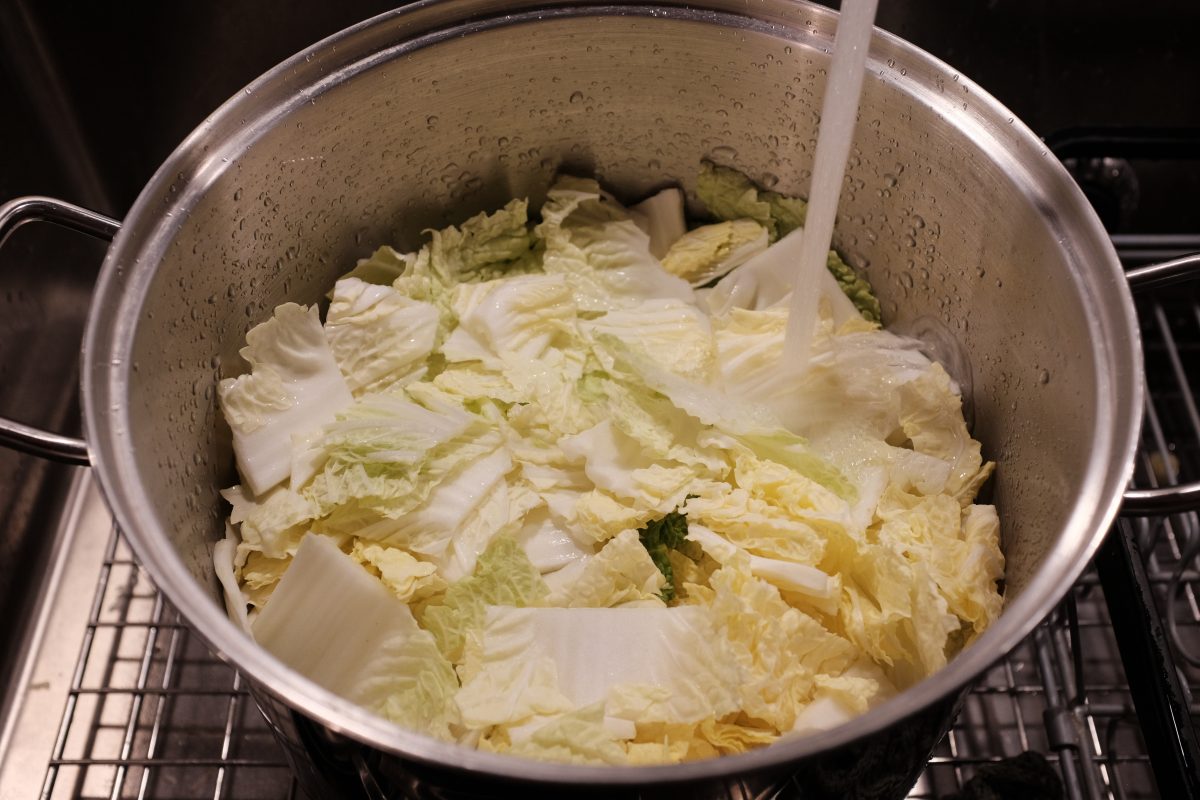
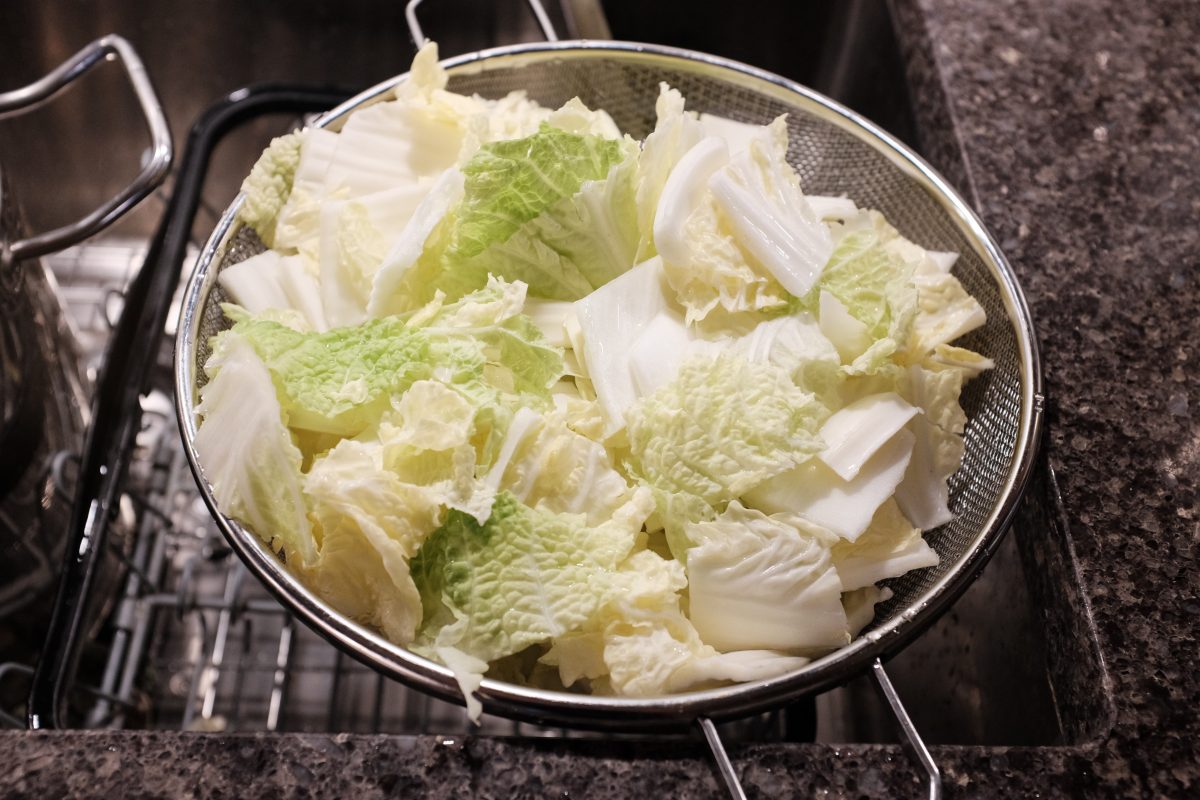
Brining
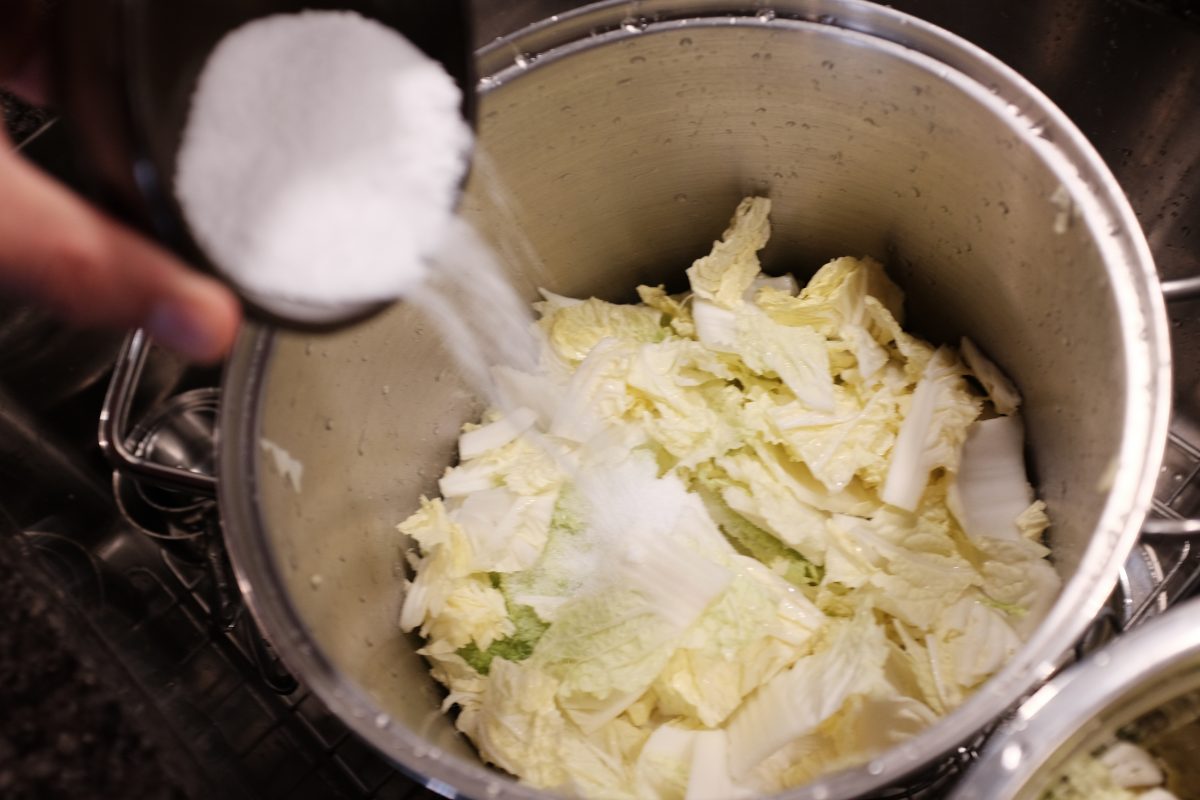
Making the kimchi paste
While the cabbage is brining, make the kimchi paste:
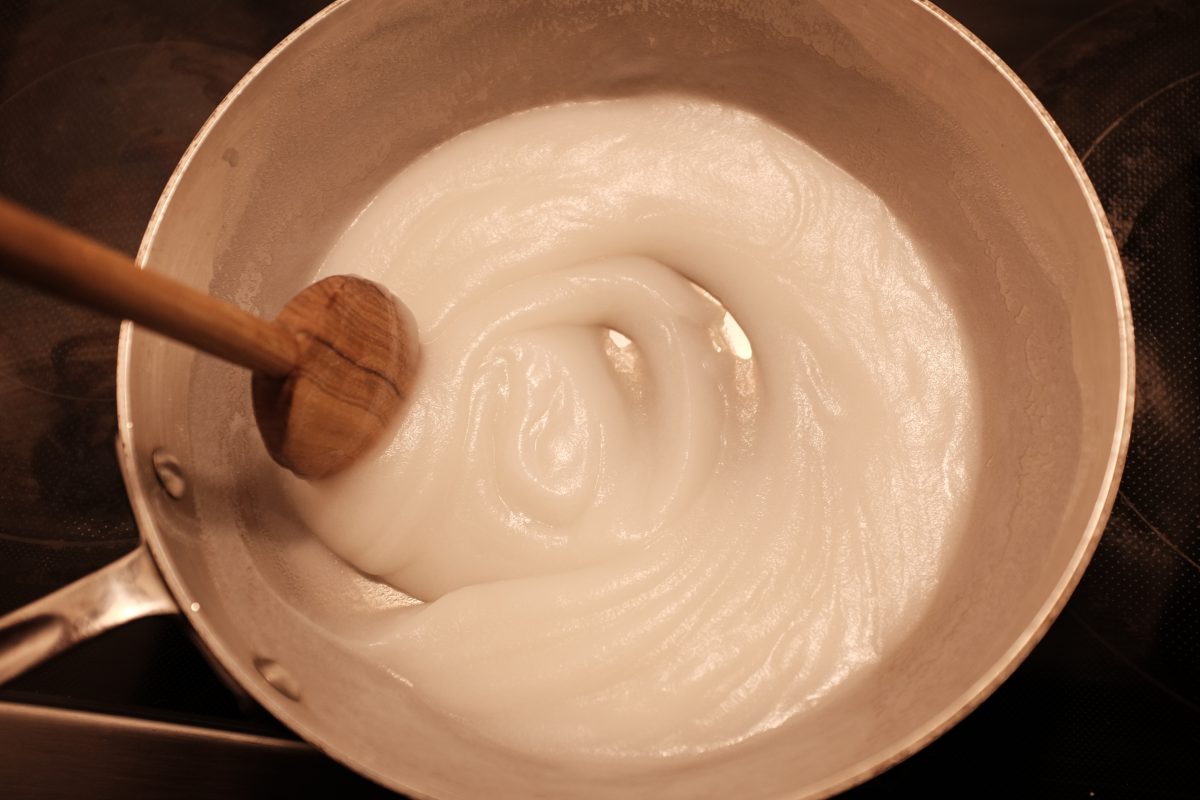
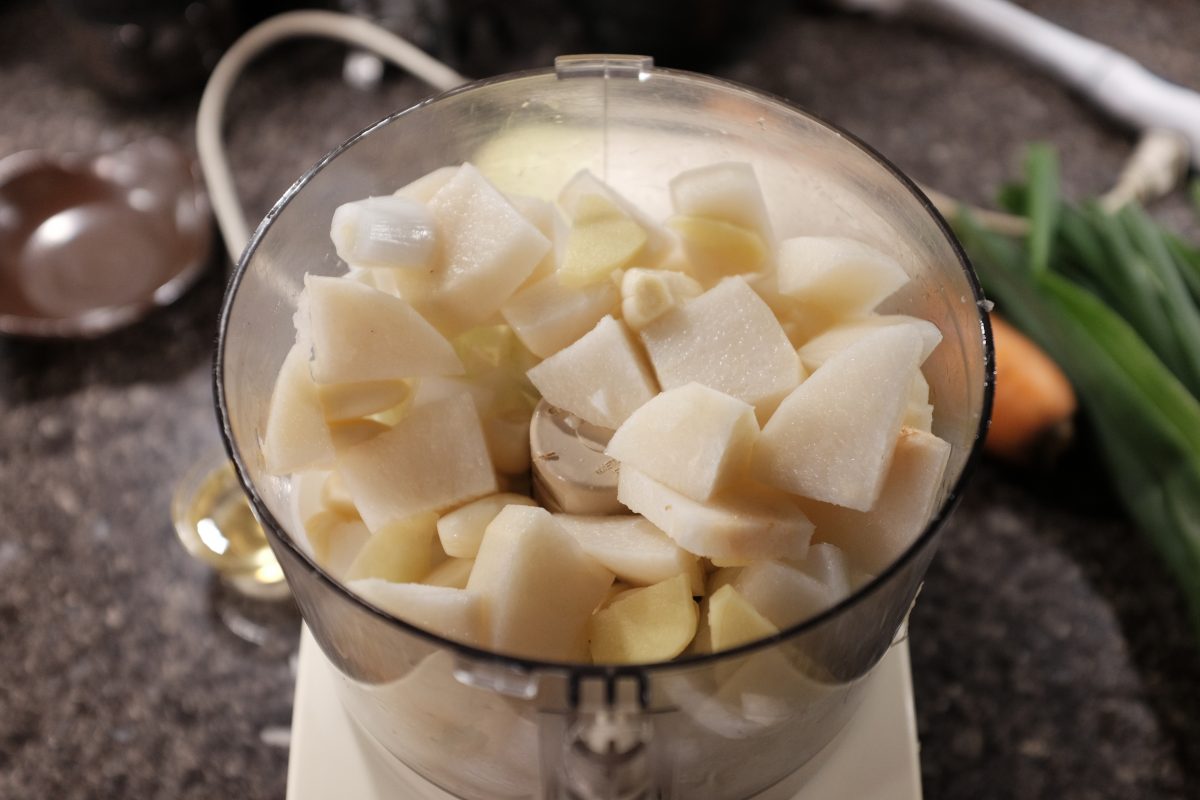
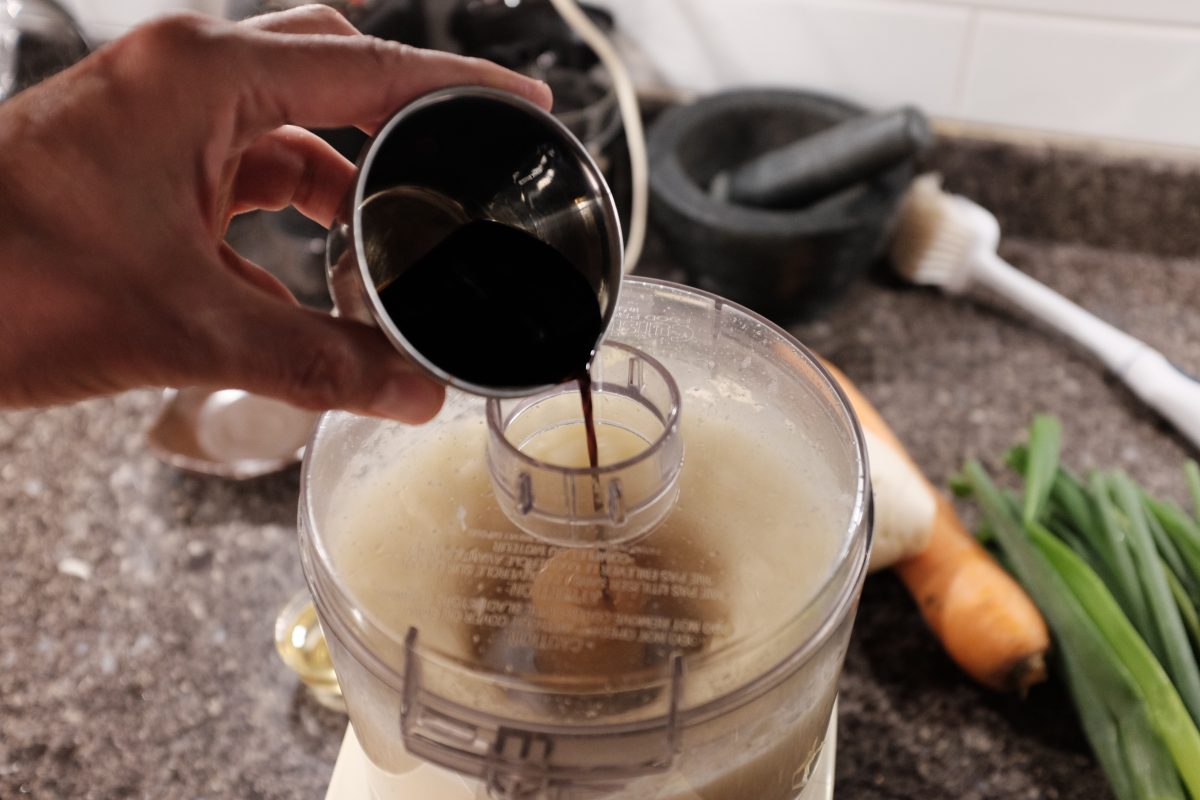
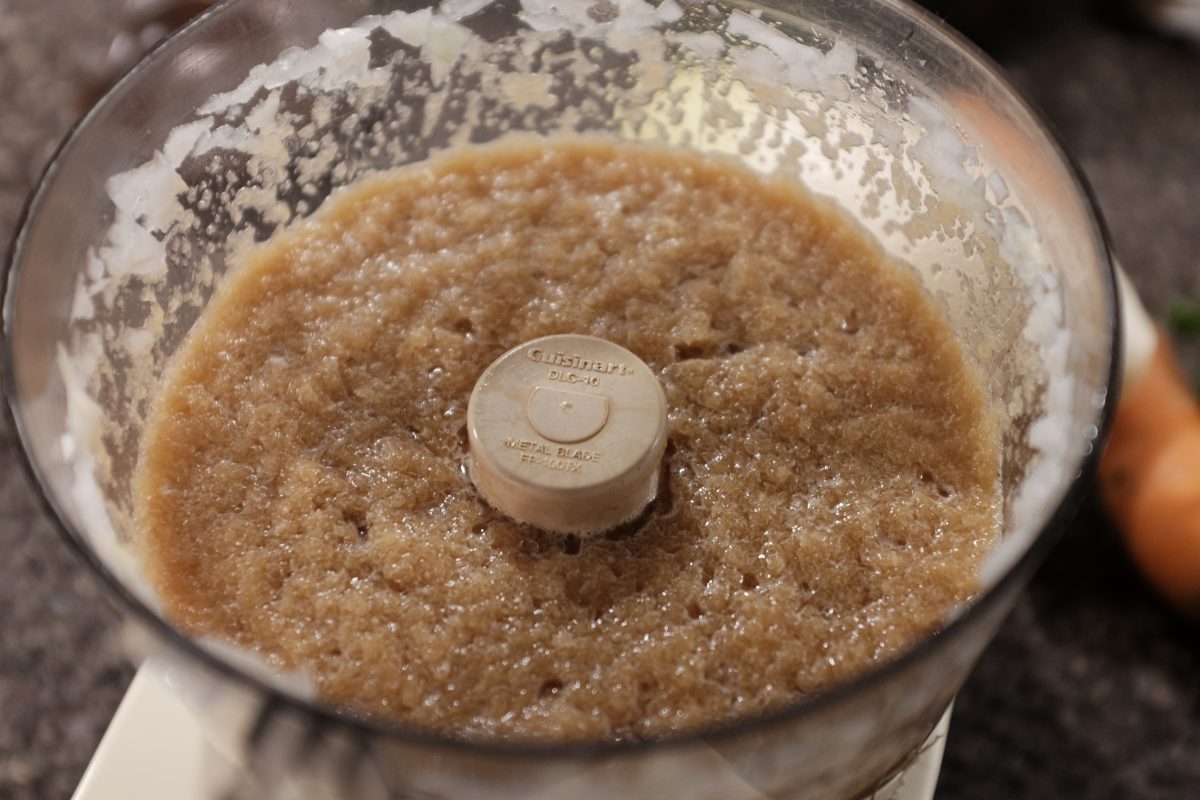
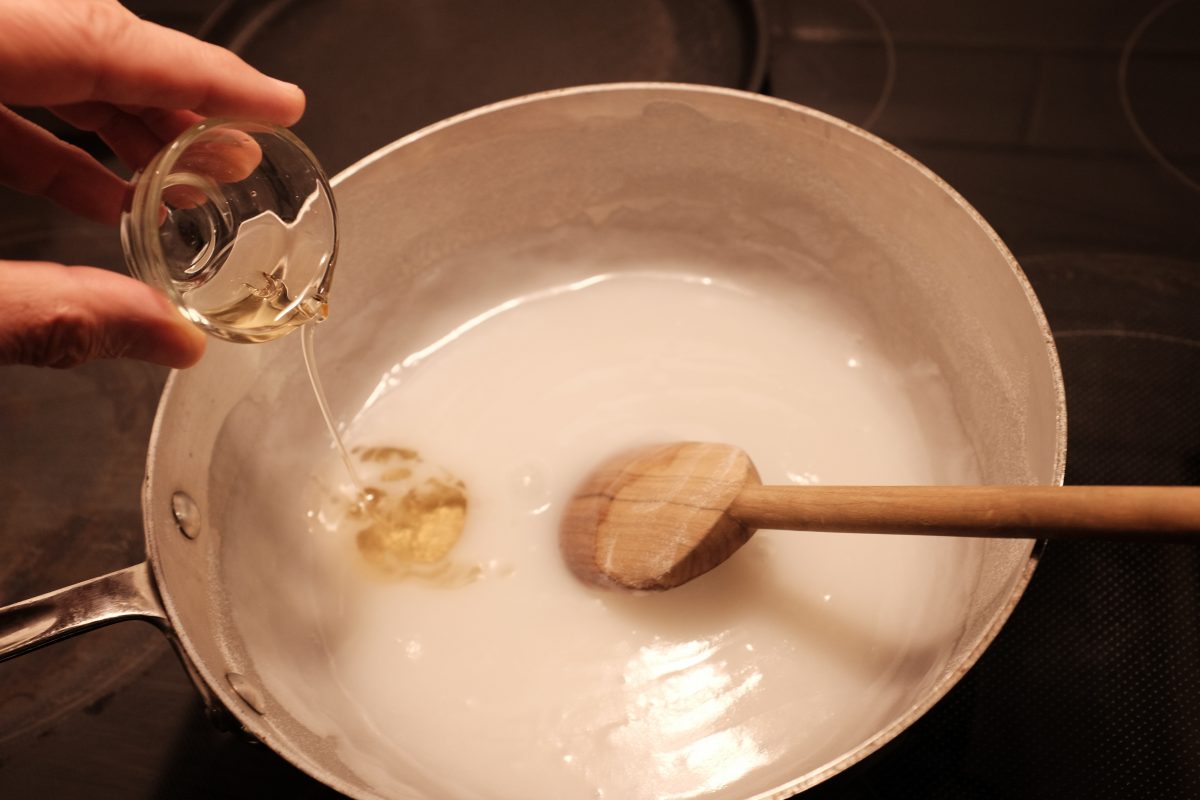
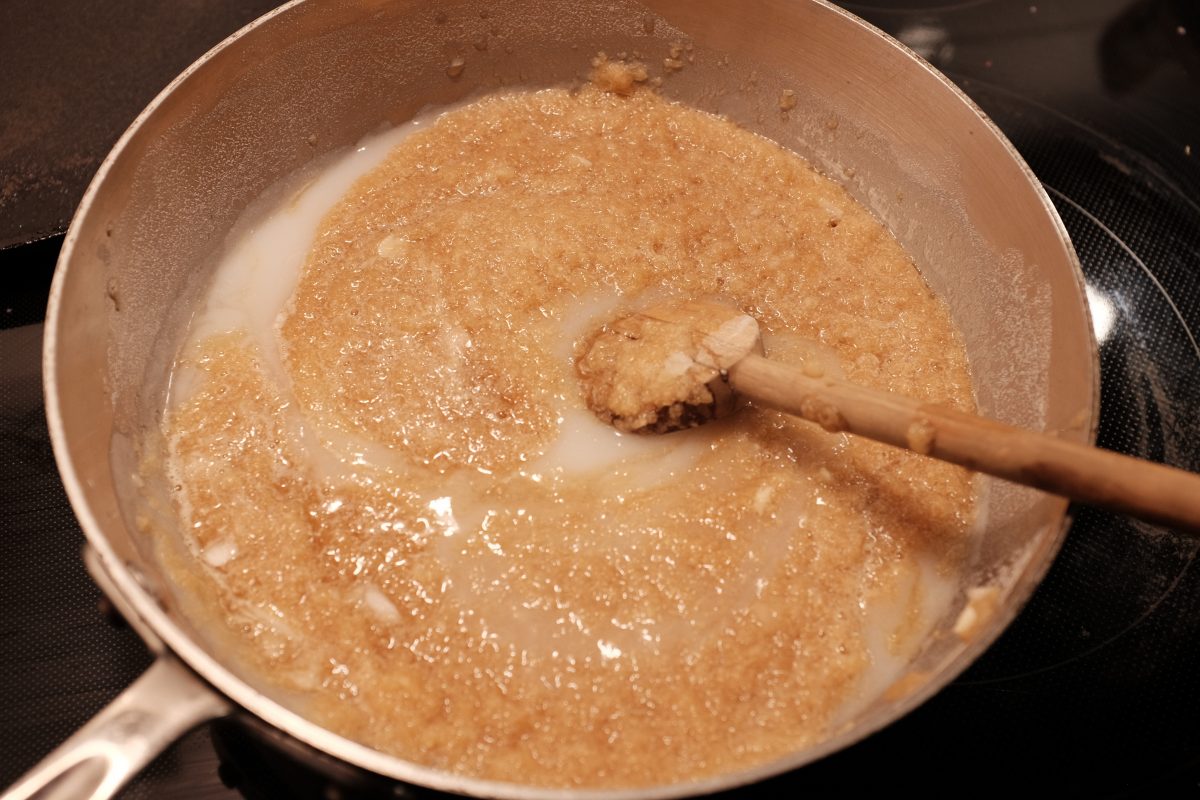
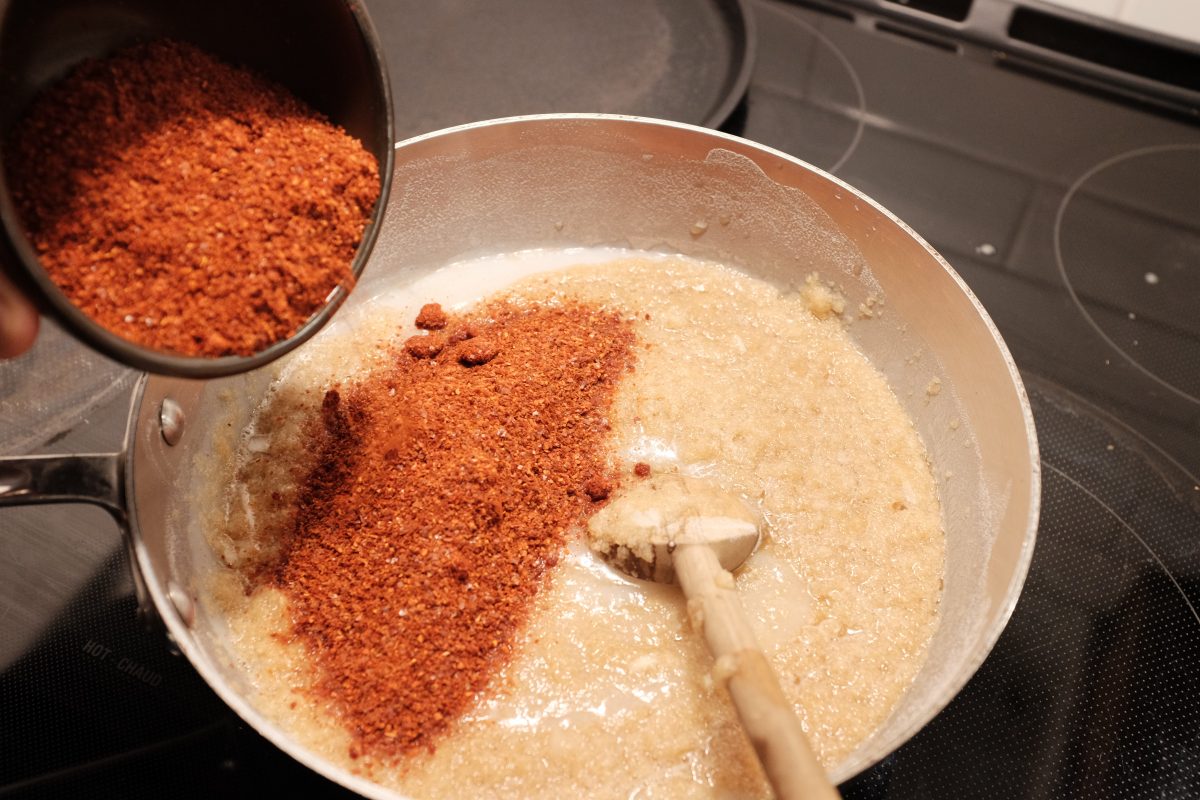
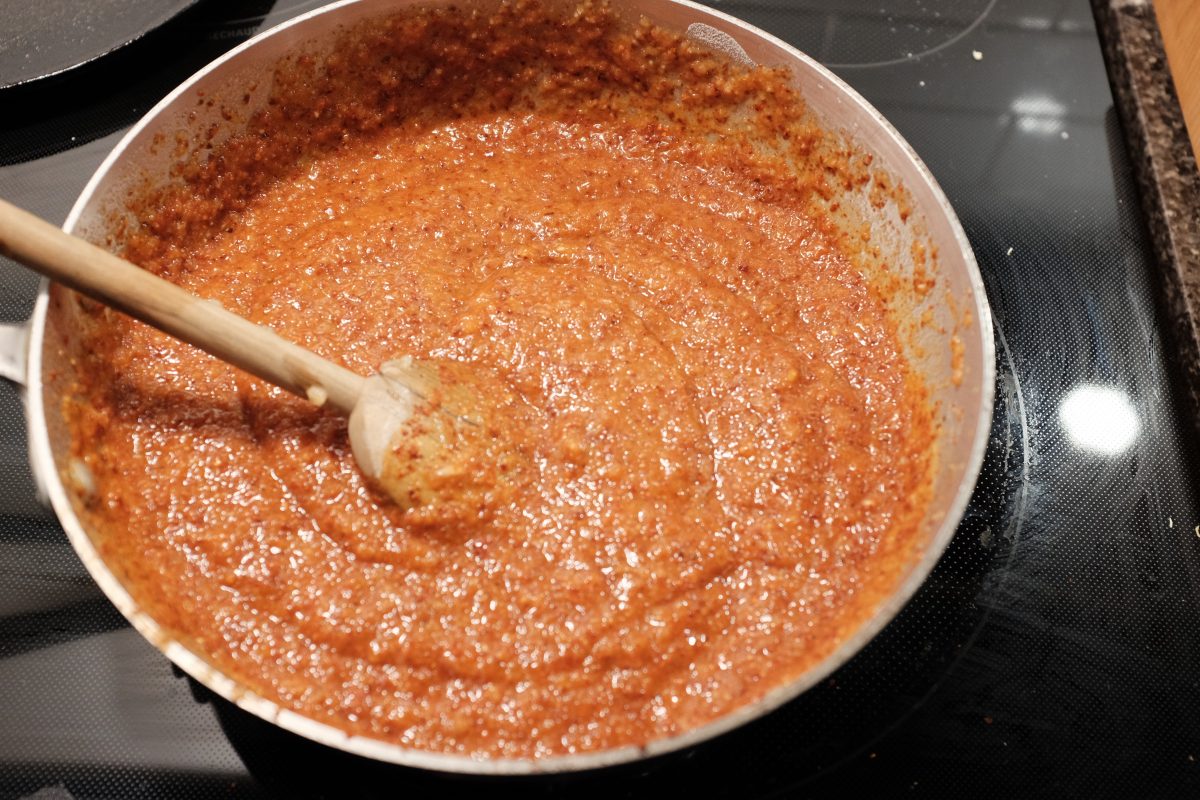
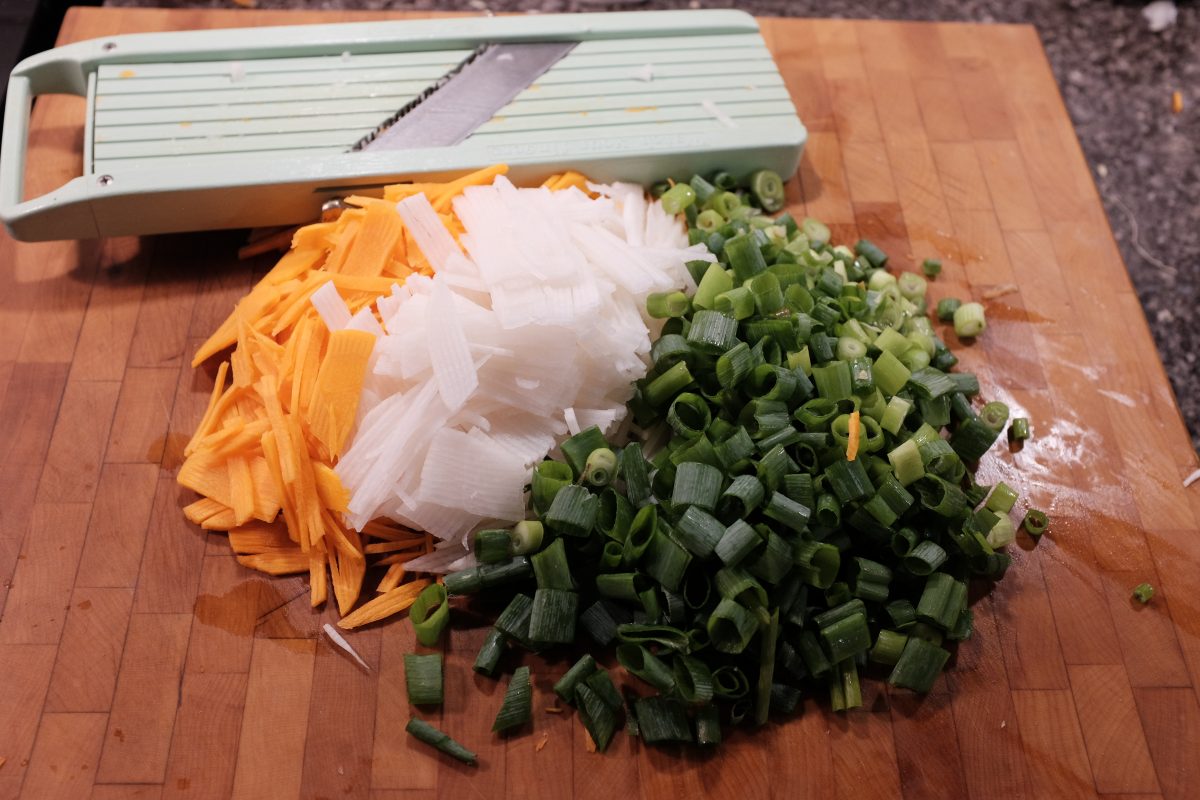
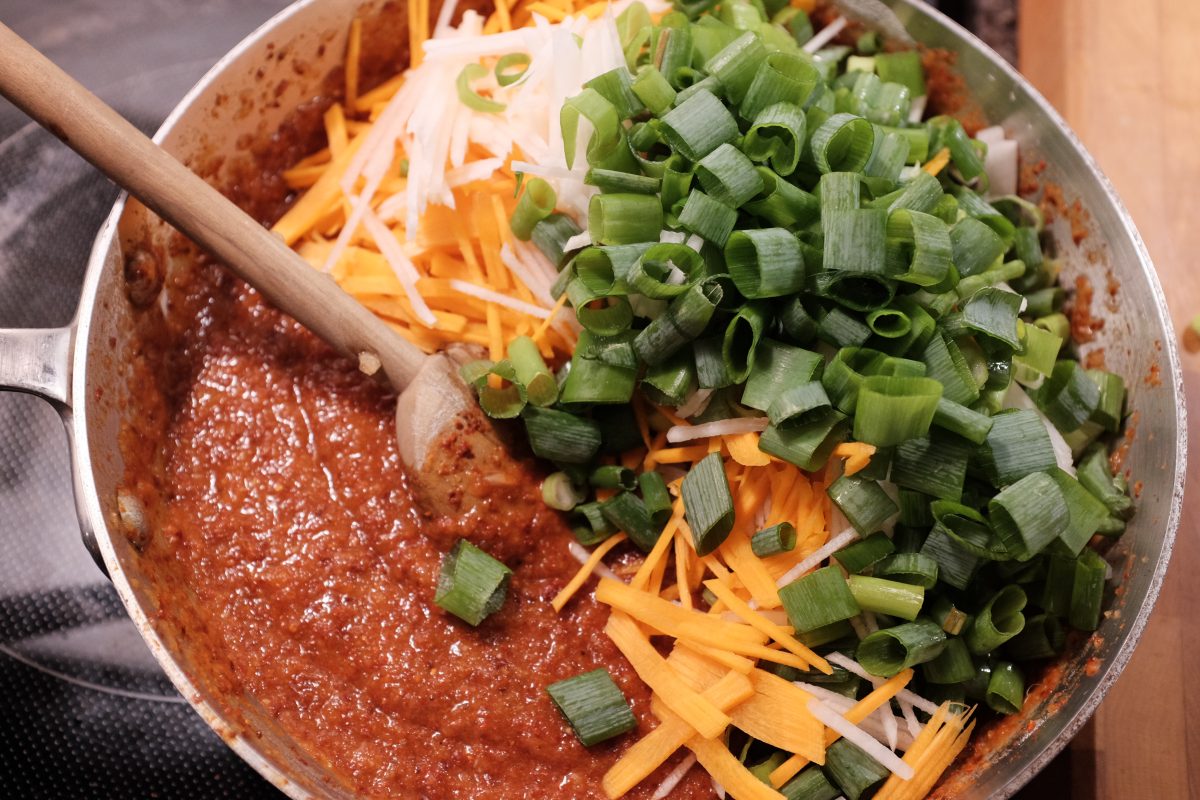
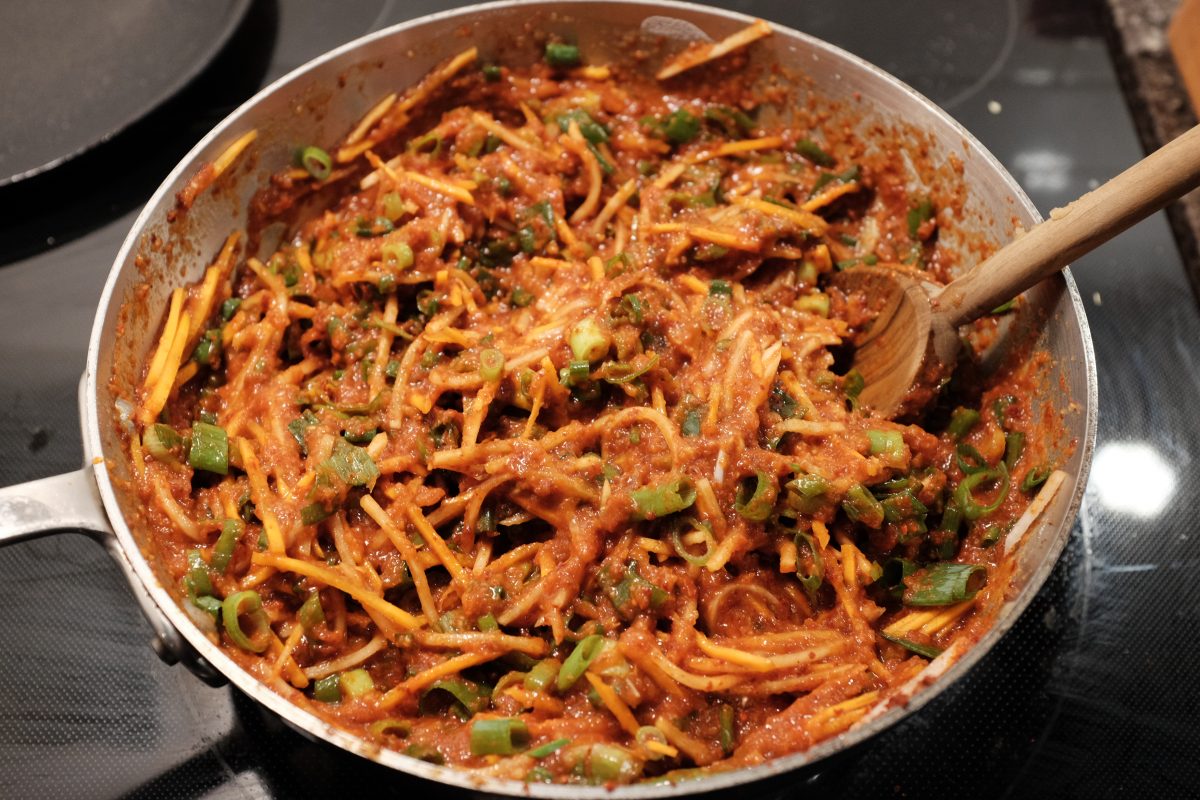
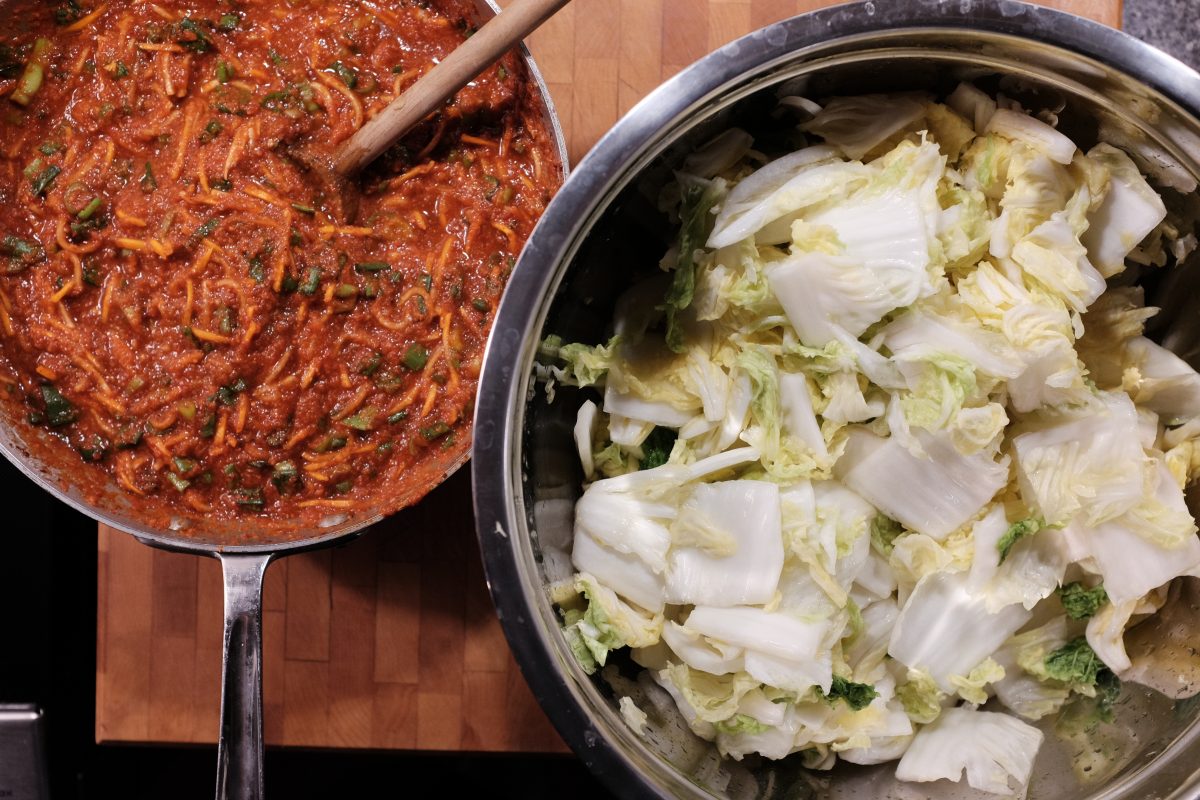
Put it all together
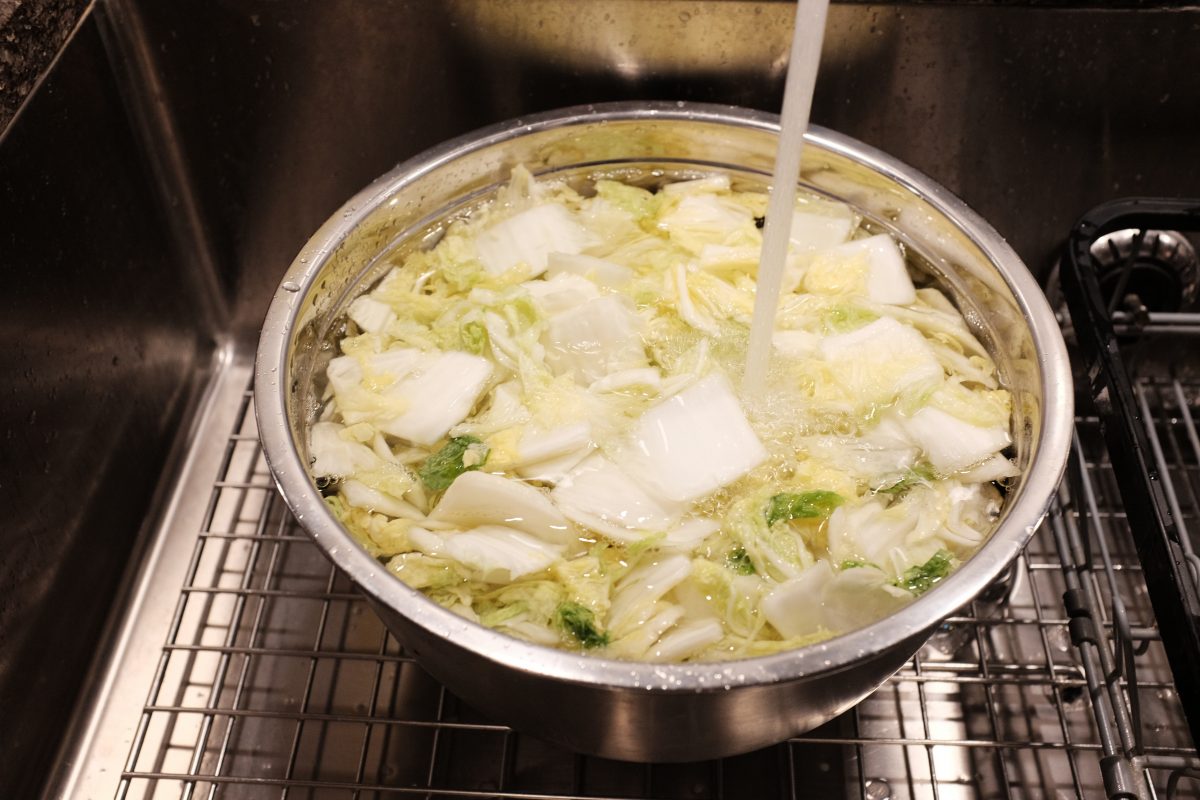
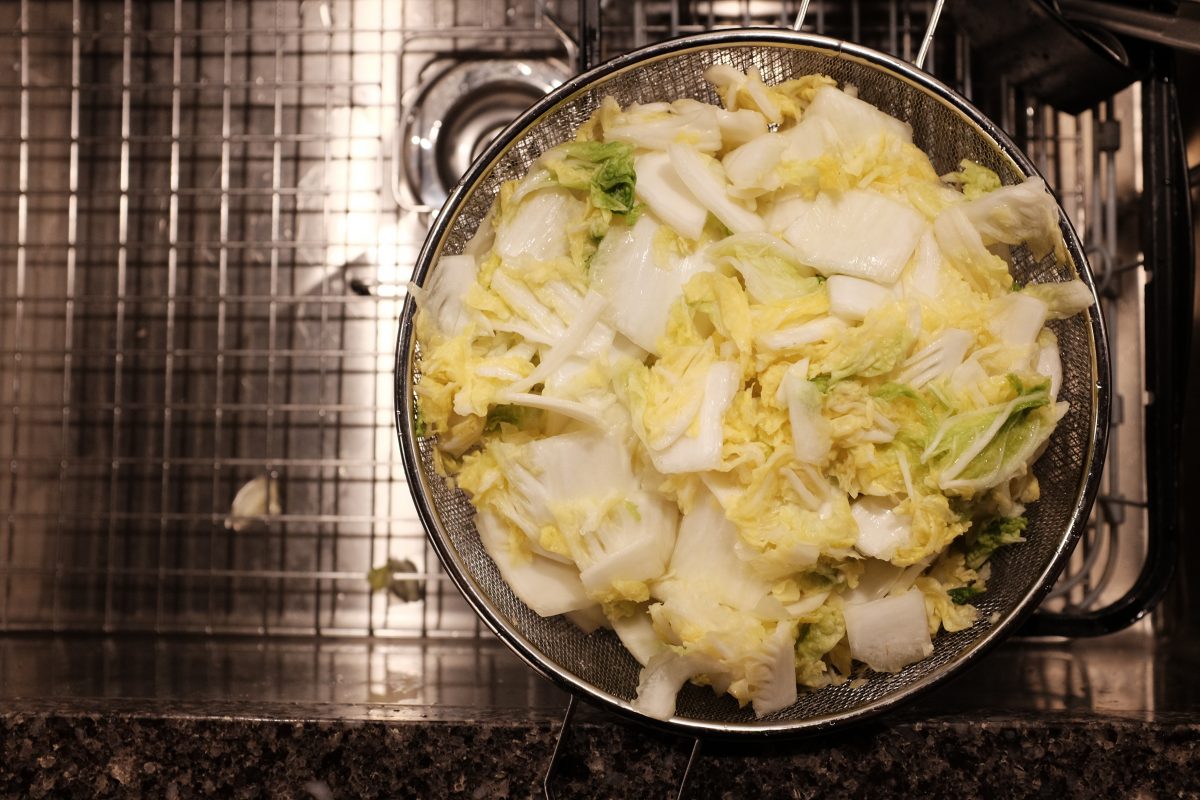
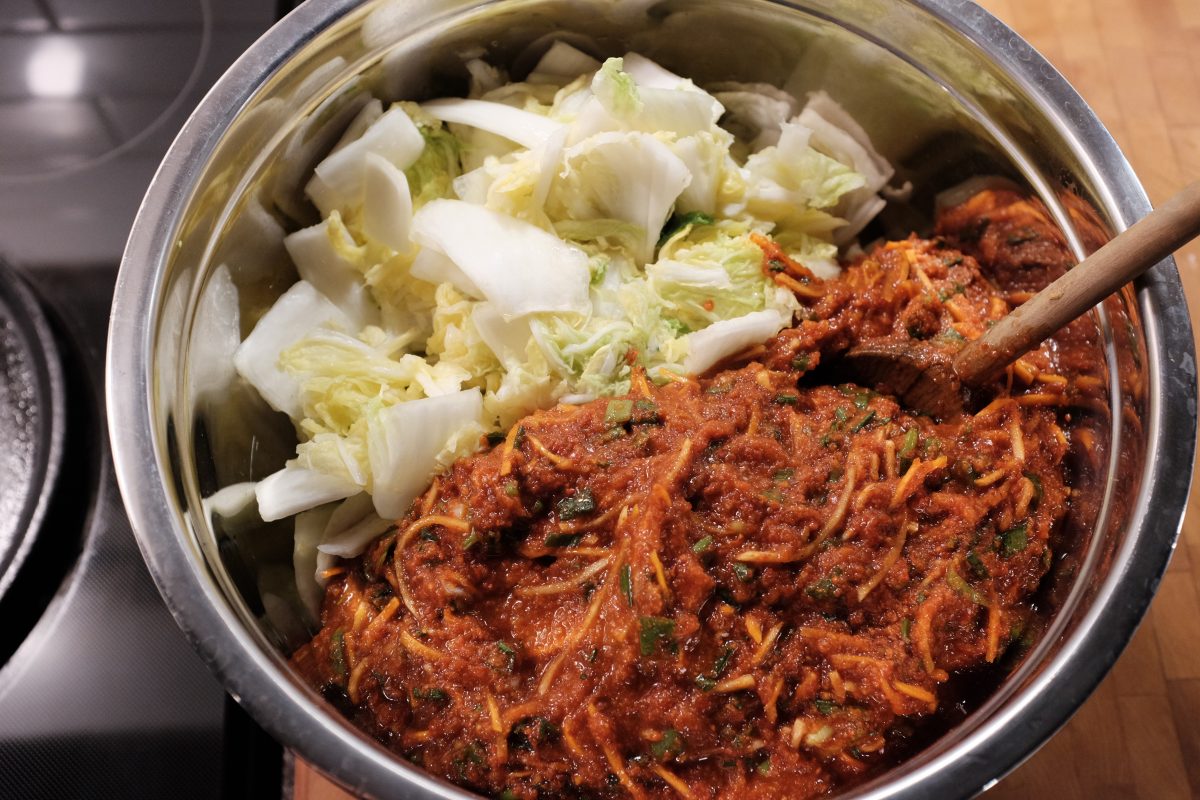
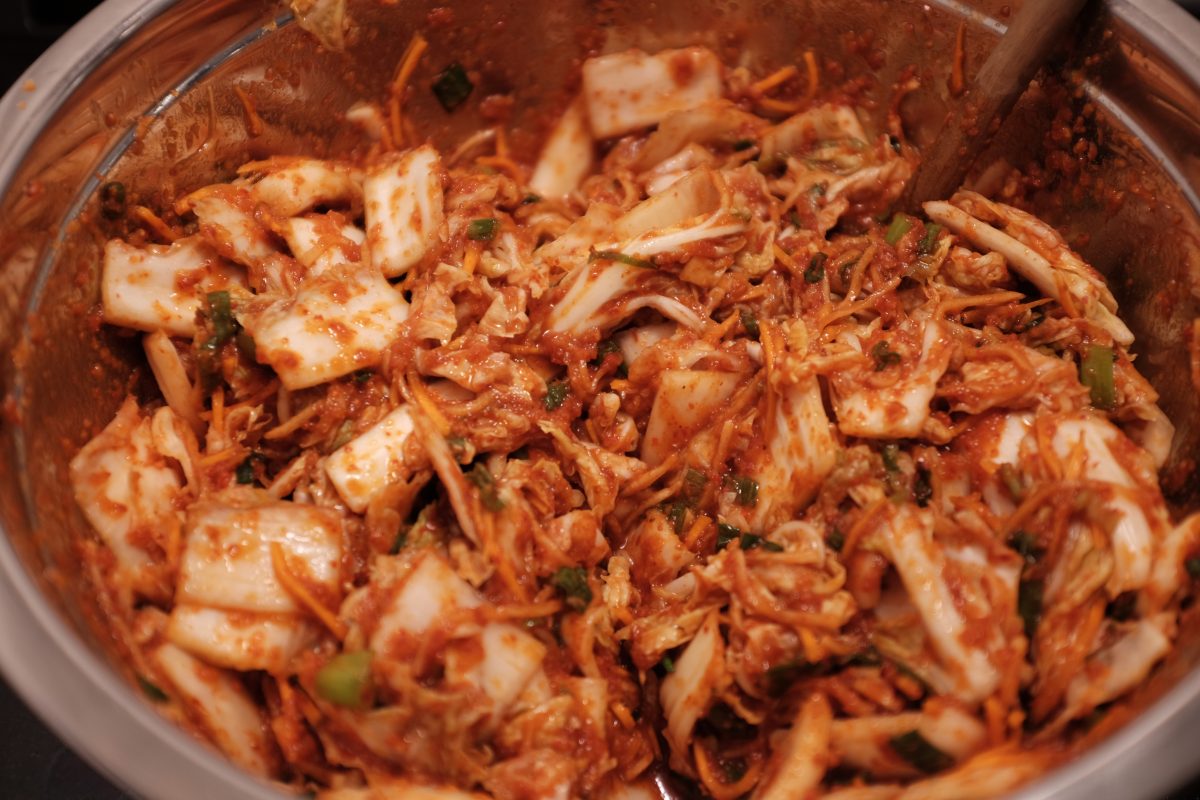
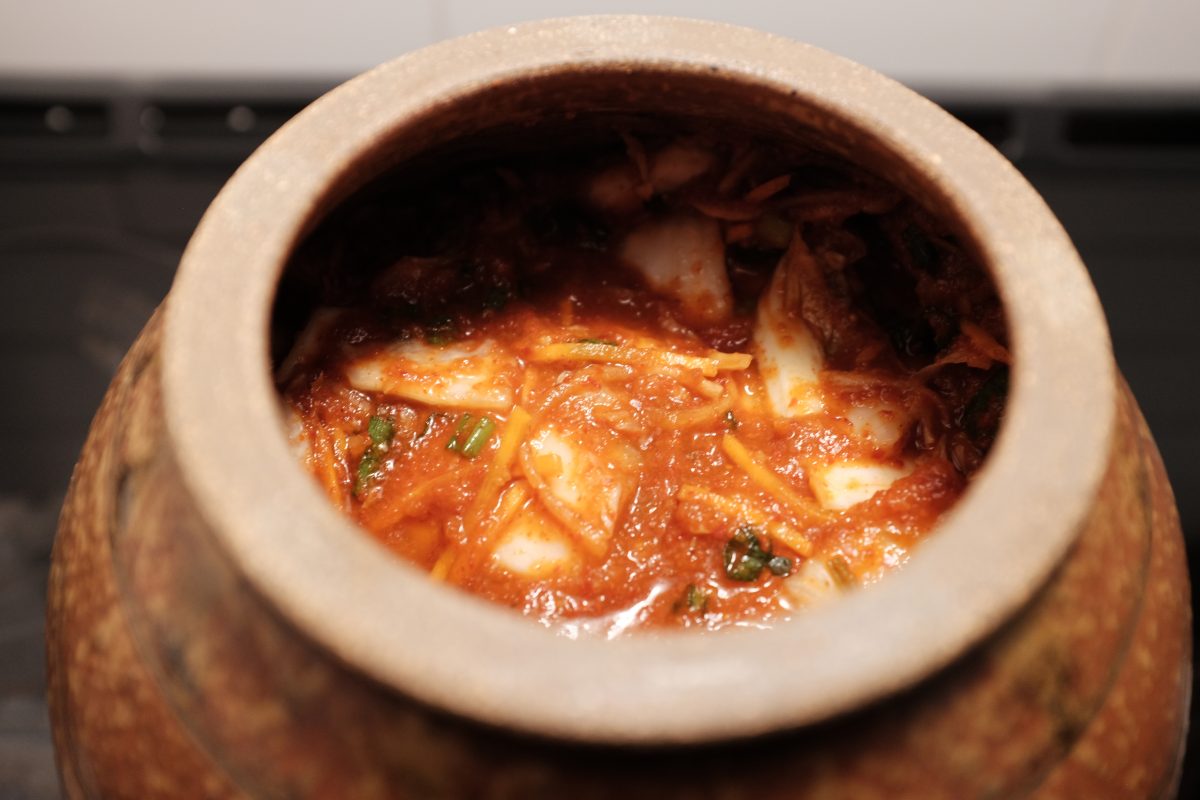
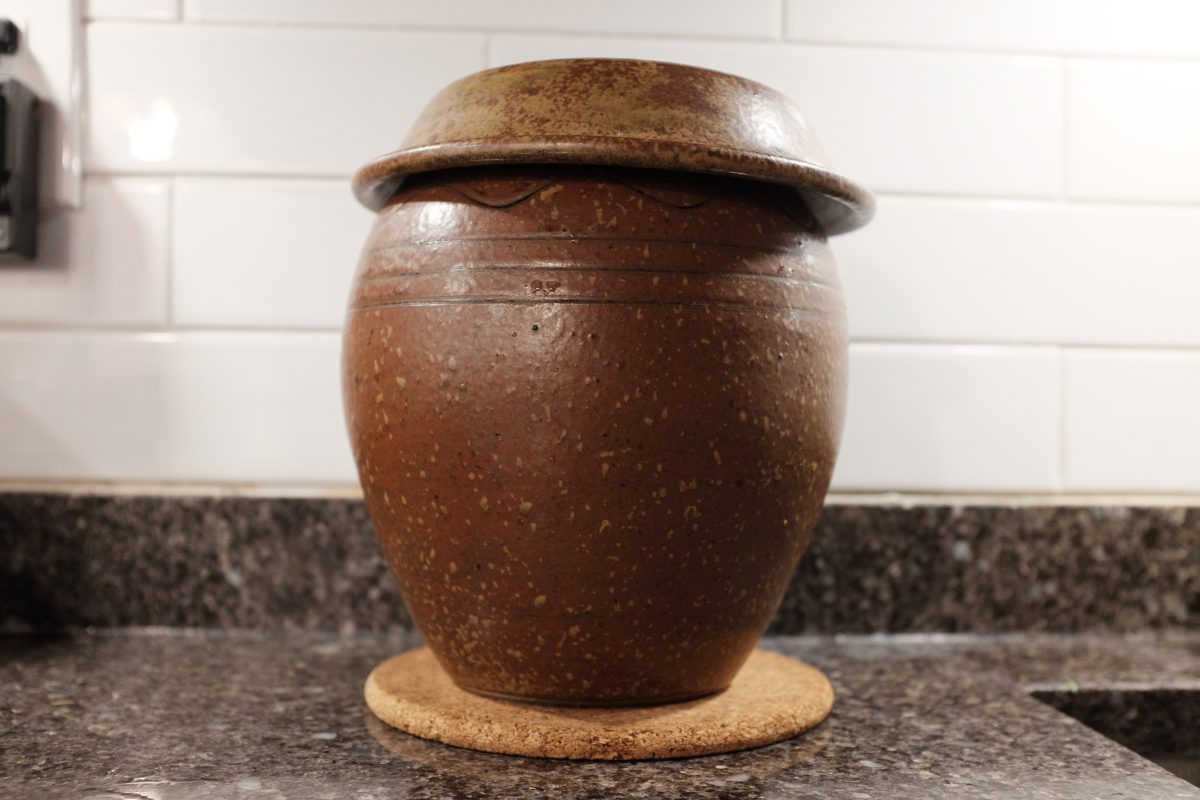
Now what?
For ideas on what to do with your kimchi take a look at this post.
If you have any questions or comments, please leave them below. I am always happy to hear from you.
Thanks for reading!
Seolleongtang
Seolleongtang is the first meal I ever ate in Korea. After a 15 hour flight and a long train ride, I finally arrived at my Insa-dong hotel sore, exhausted and hungry. The closest restaurant was directly behind the hotel, attached to the parking lot. This unassuming restaurant turned out to be one of the oldest in Seoul: Imun Seolleongtang. I had a big hot bowl of this plain milky beef soup and within an hour I felt completely refreshed. This simple soup seemed to erase my body’s memory of being crushed in an economy seat for the last 15 hours. It was like magic.
Since then, I have been back to Korea many times and I always start and finish my travels with this simple meal. Imun Seolleongtang has since received Michelin recognition and so it is busier (and more expensive) than ever with lots of tourists coming in to snap photos for instagram and tiktok. The staff seem to take it in stride, brisk and efficient, though maybe somewhat less friendly than I remember nearly 10 years ago. Also gone is the sloppy bucket of juicy and chunky kkadugi in the middle of the table and the big basket of chopped green onion. These now arrive in less bottomless portions after you order. But, even though some things have changed, the food is still as delicious as I remember and I still go to Imun as well as another smaller family run Seollongtang restaurant nearby.
Homemade seolleongtang
Seolleongtang always seemed kind of mysterious to me. Where did that milky colour come from? How was this simple soup so nutty and delicious? It arrives at the table completely bland and unseasoned but the addition of a little salt and pepper, kimchi juice and green onion turns it into something deep and complex and unforgettable.
Like a good food detective, I decided to launch a full investigation. After much reading and video watching, I discovered that the secret is really in the style of beef stock, in the process rather than the ingredients. The recipe below is a two-part process. First you will need to make the milky bone broth. Once you have this broth on hand, turning it into finished seolleongtang is a very simple and quick process. You can find the complete recipe for the beef bone broth by clicking here.
Ingredients
*this is for one big portion or 2 smaller portions
- 1 litre Korean milky beef bone broth
- 250gr beef brisket point
- cooked white rice
- cooked somyeon/somen noodles
- 2-3 green onions (scallions)
- salt and pepper
I used brisket point. You can use any beef you like. Tougher cuts will take longer to soften up and more tender cuts will take less time. I like brisket because it is somewhere in between. It has the deep beef flavour of a tougher muscle but is slightly more tender so takes a little less time to cook. If you like, you can soak the meat in water for a few hours to remove some of the blood but, this is optional.
Process
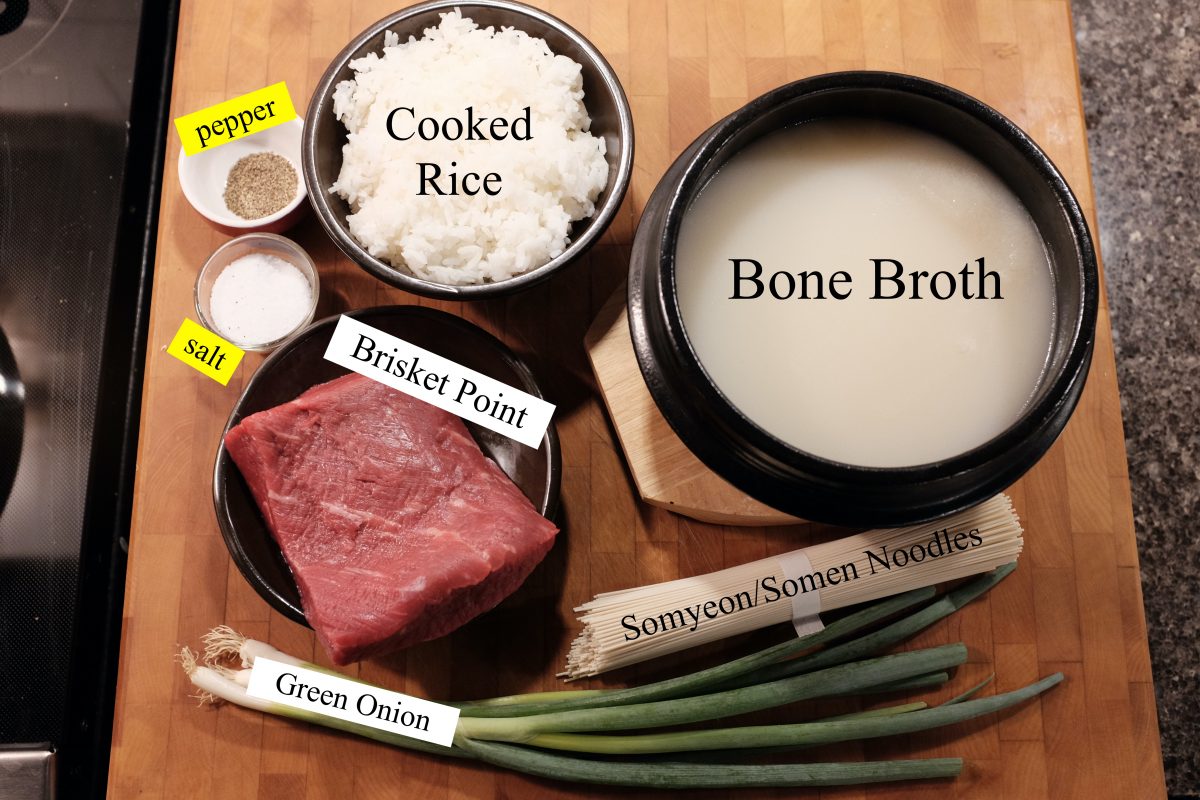
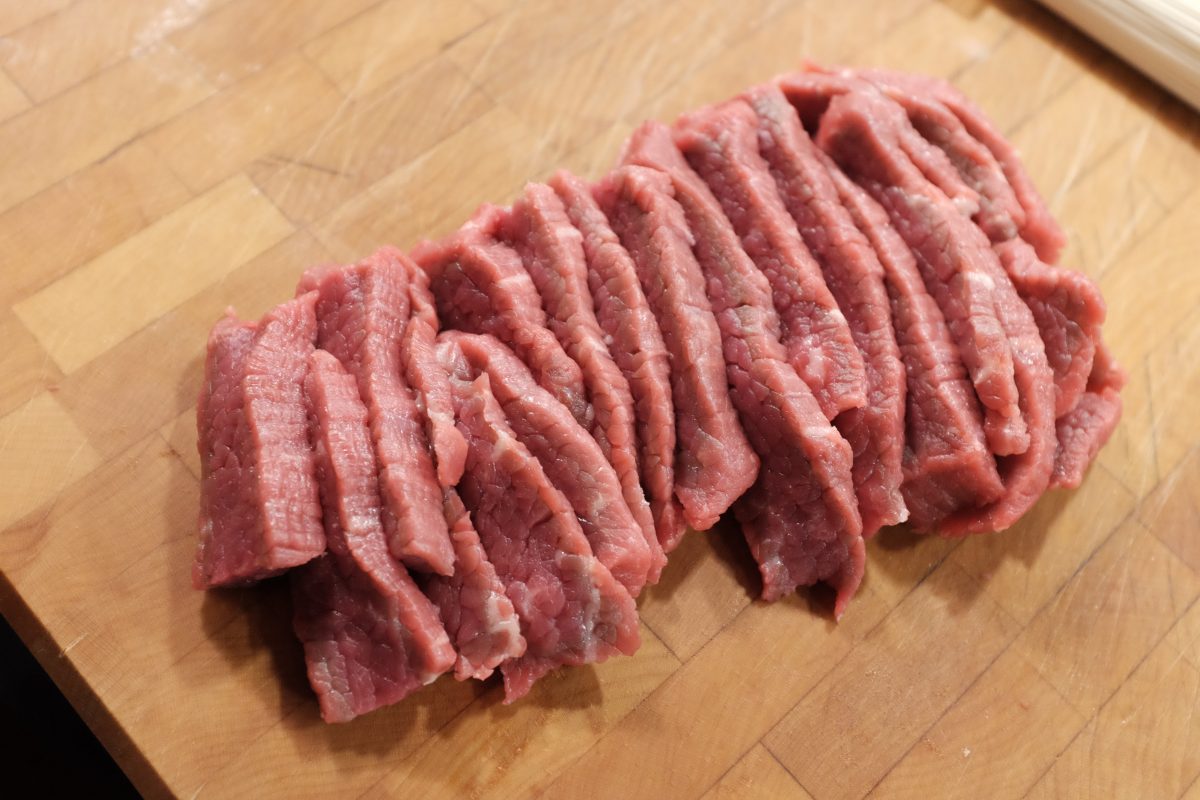
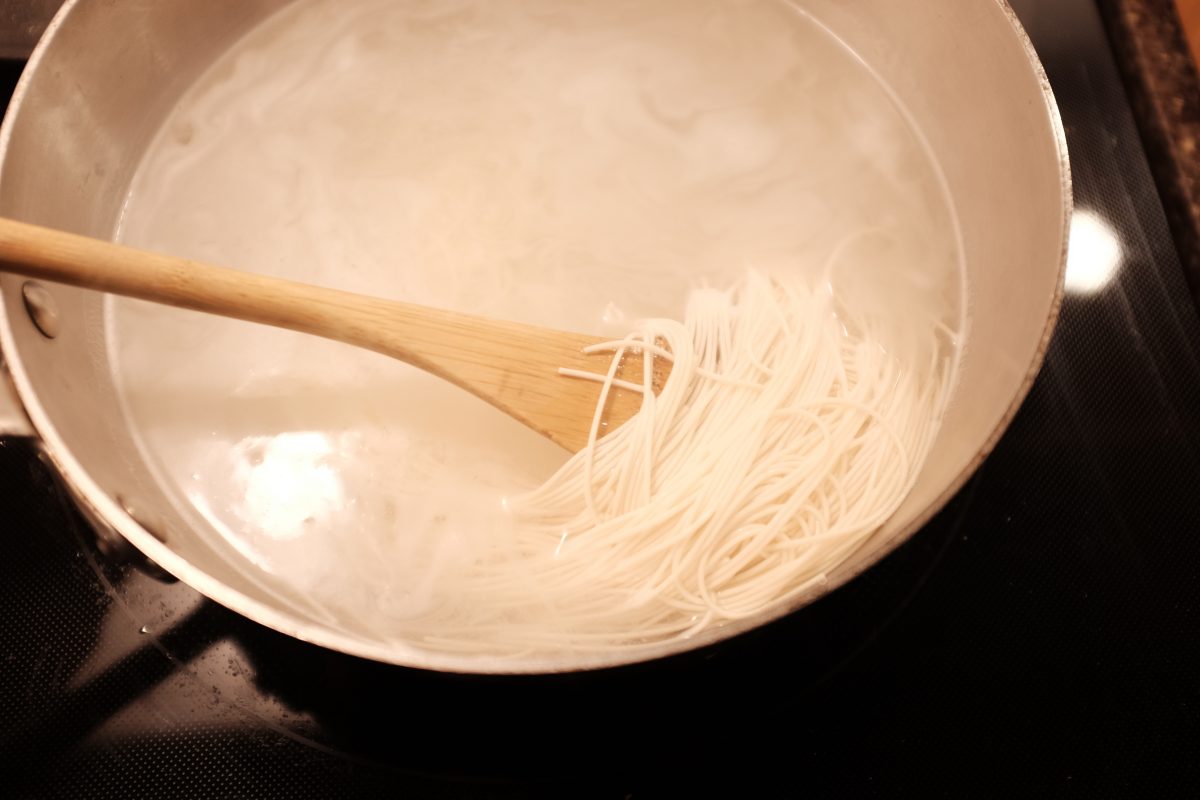
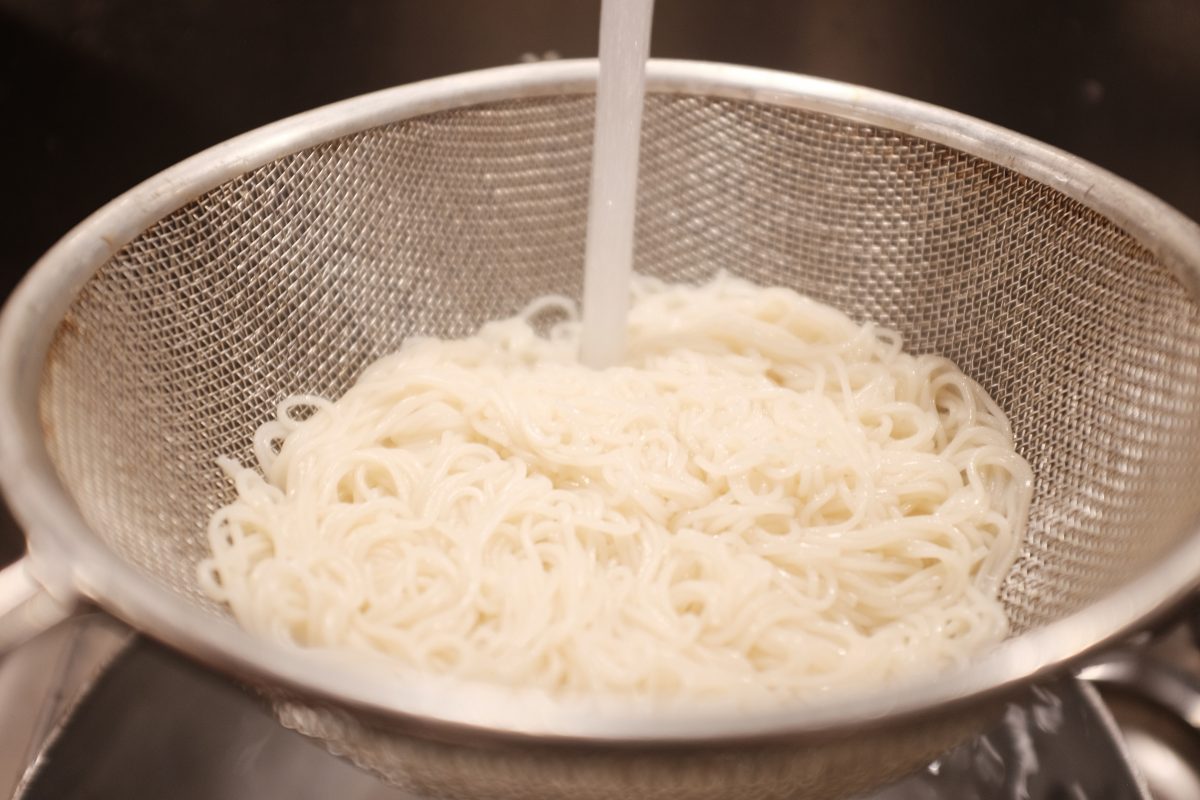
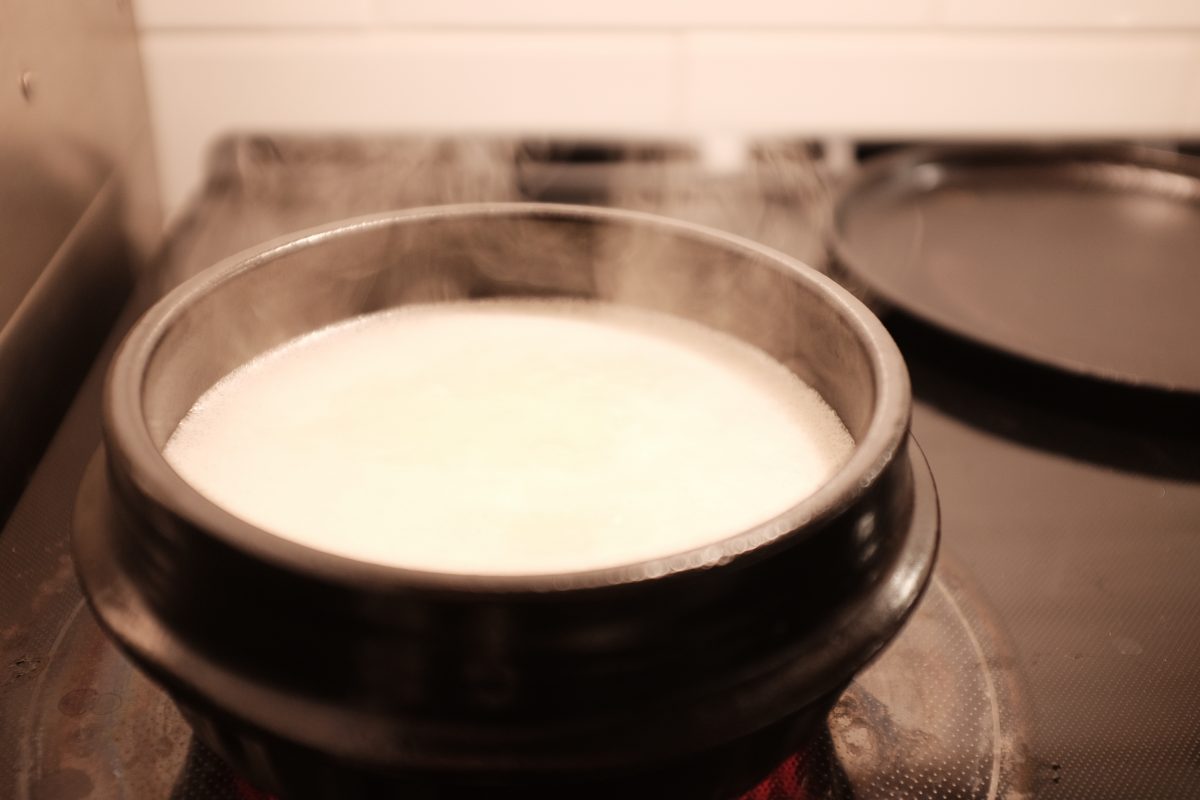
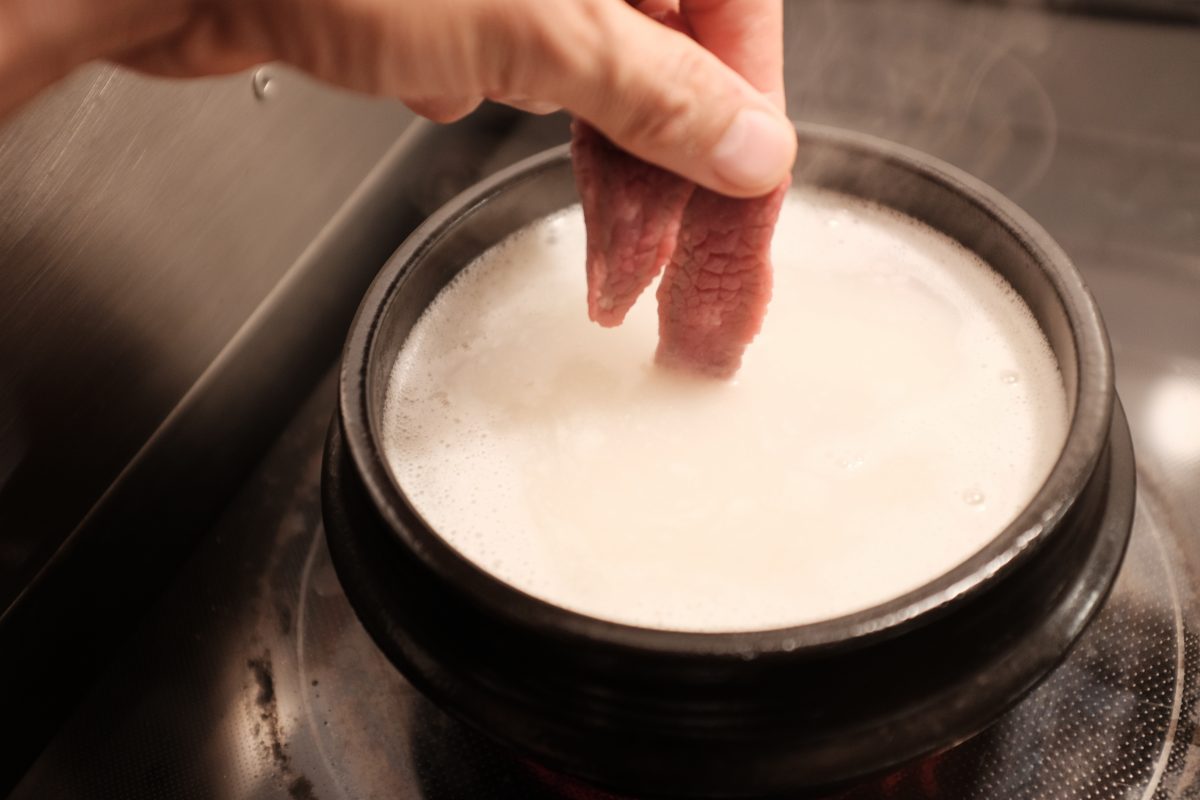
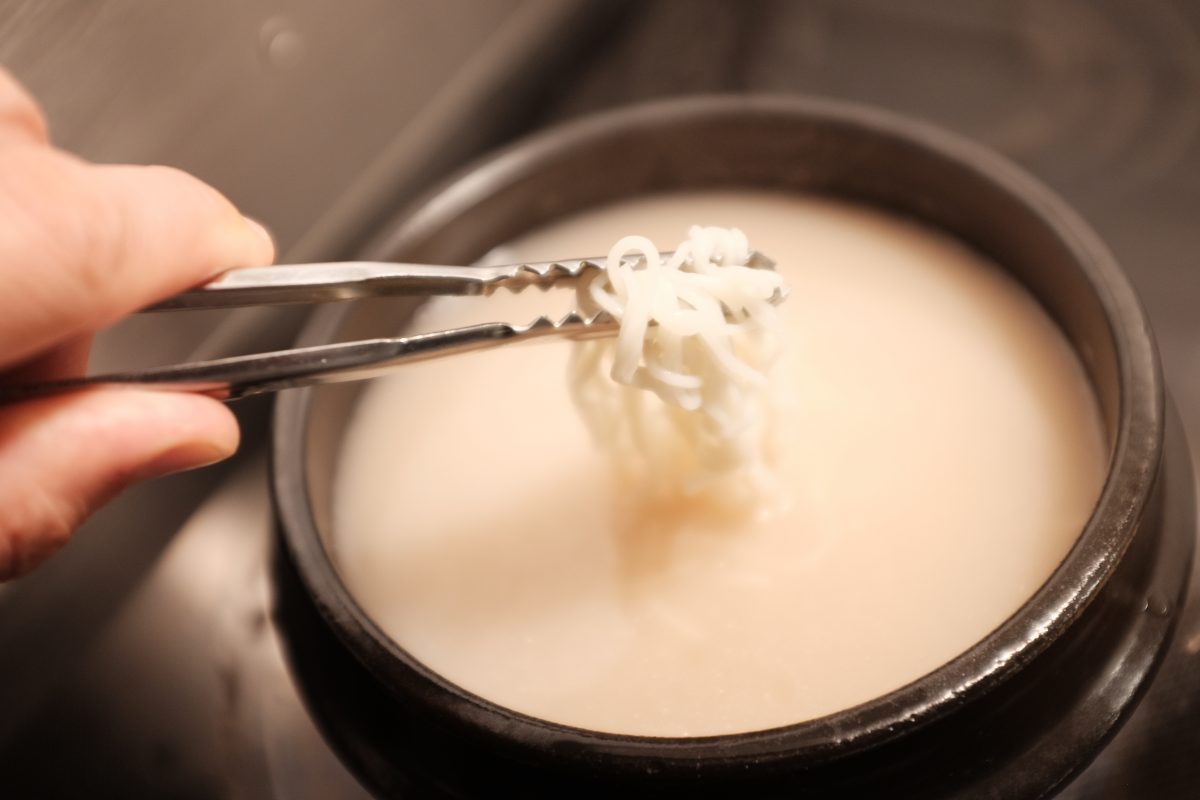
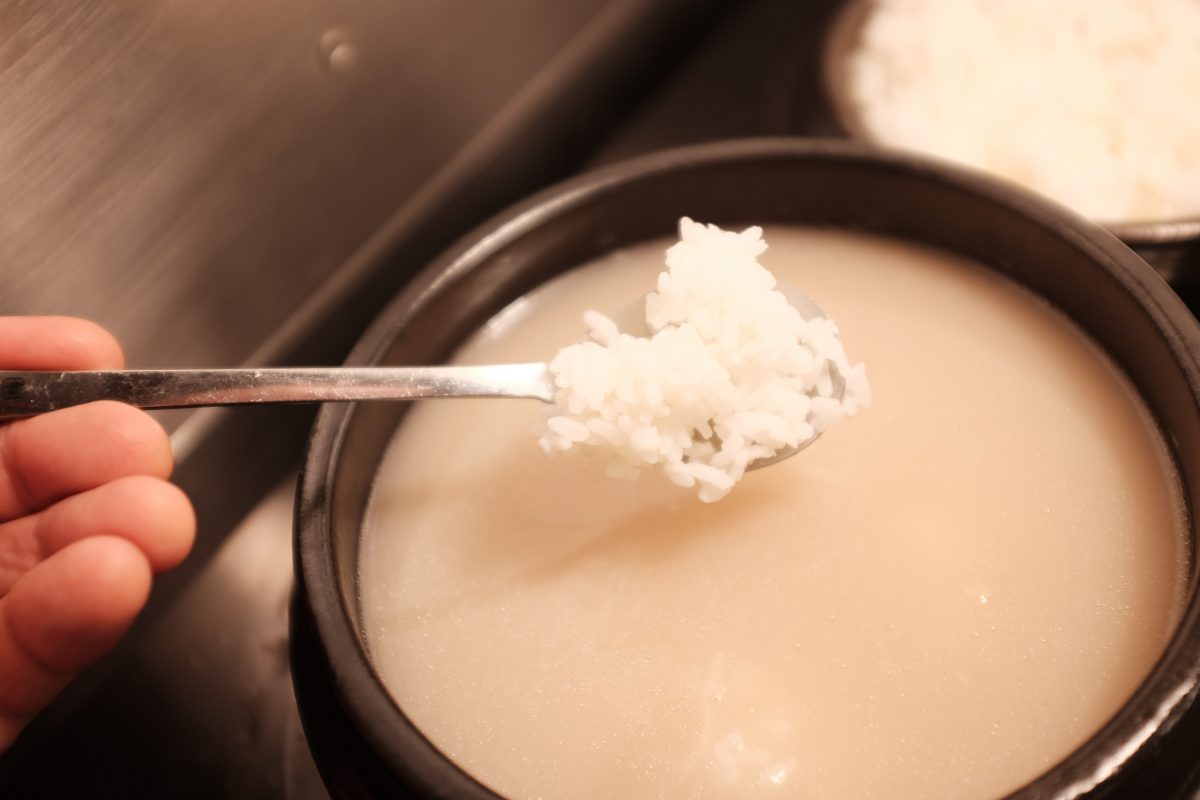
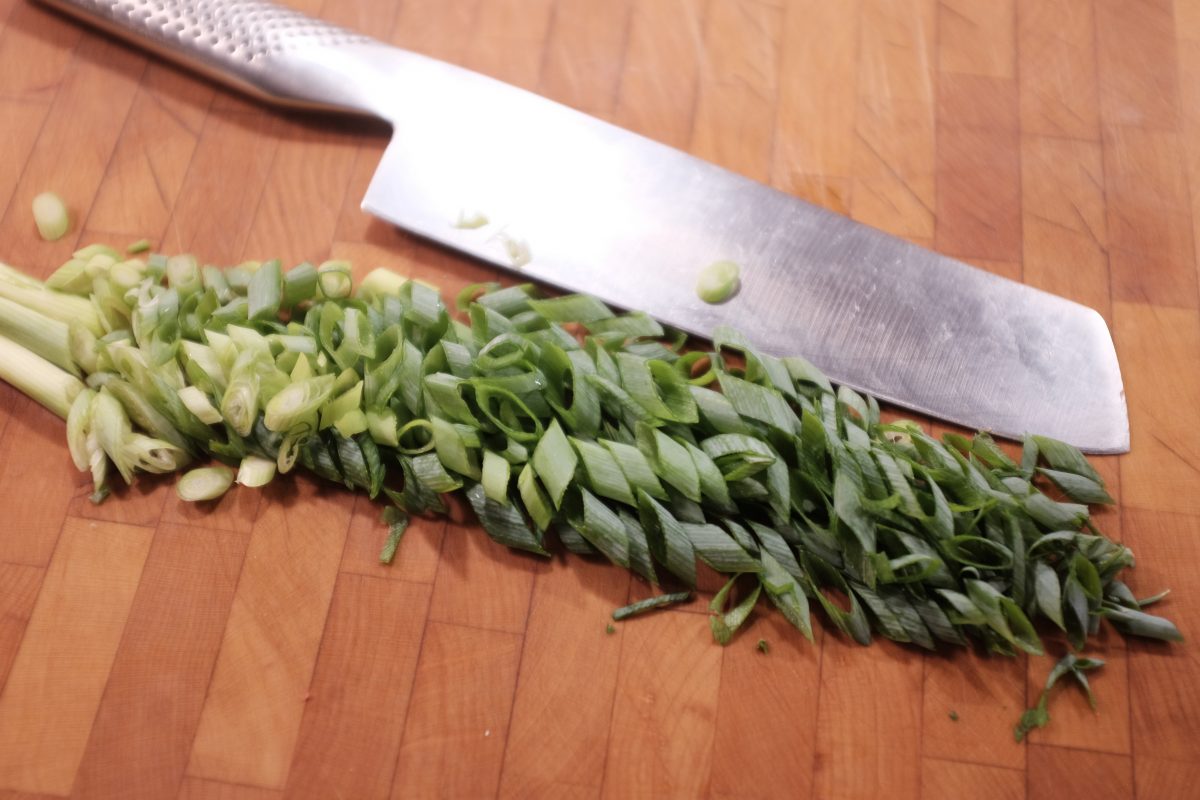
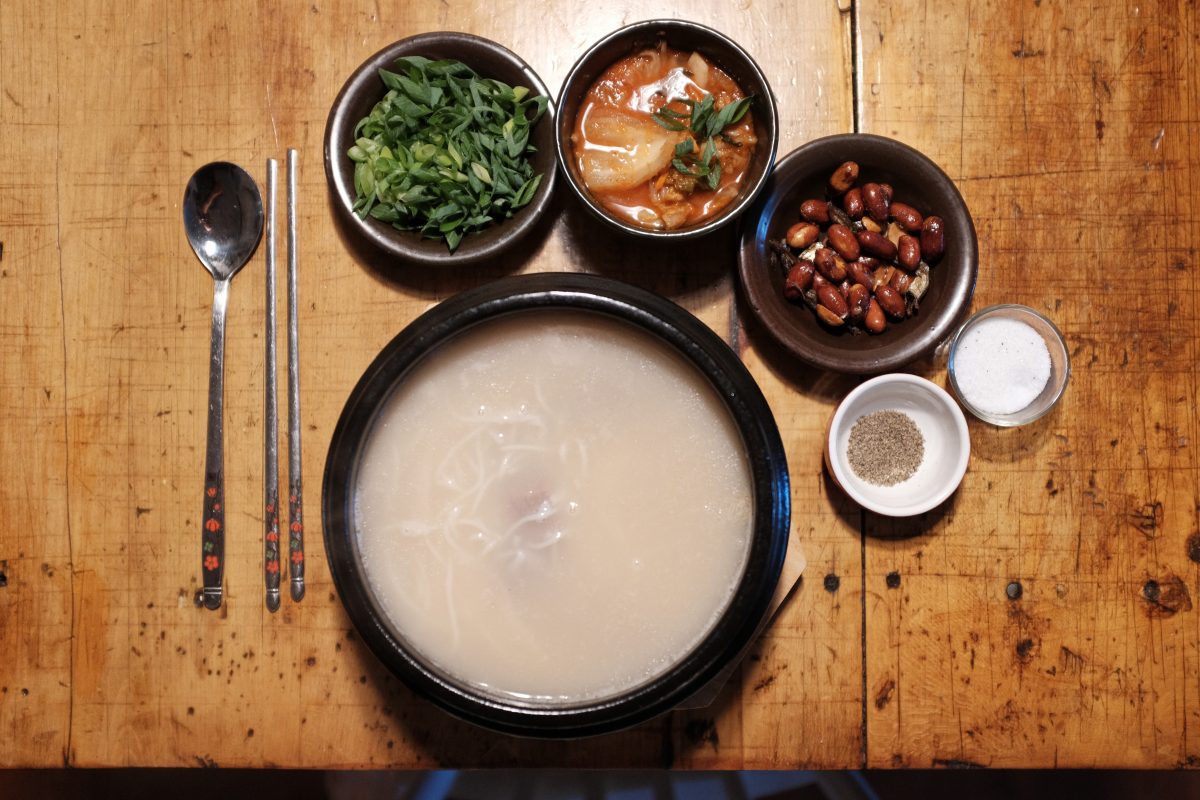
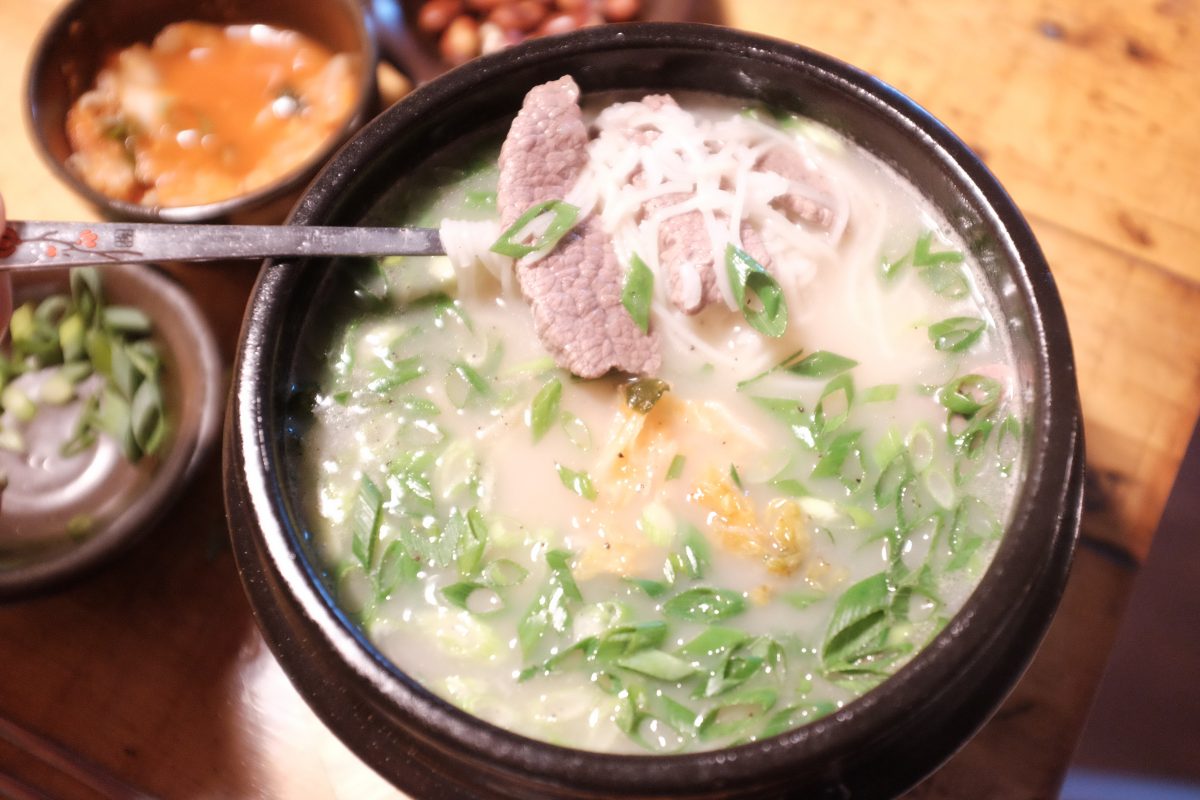
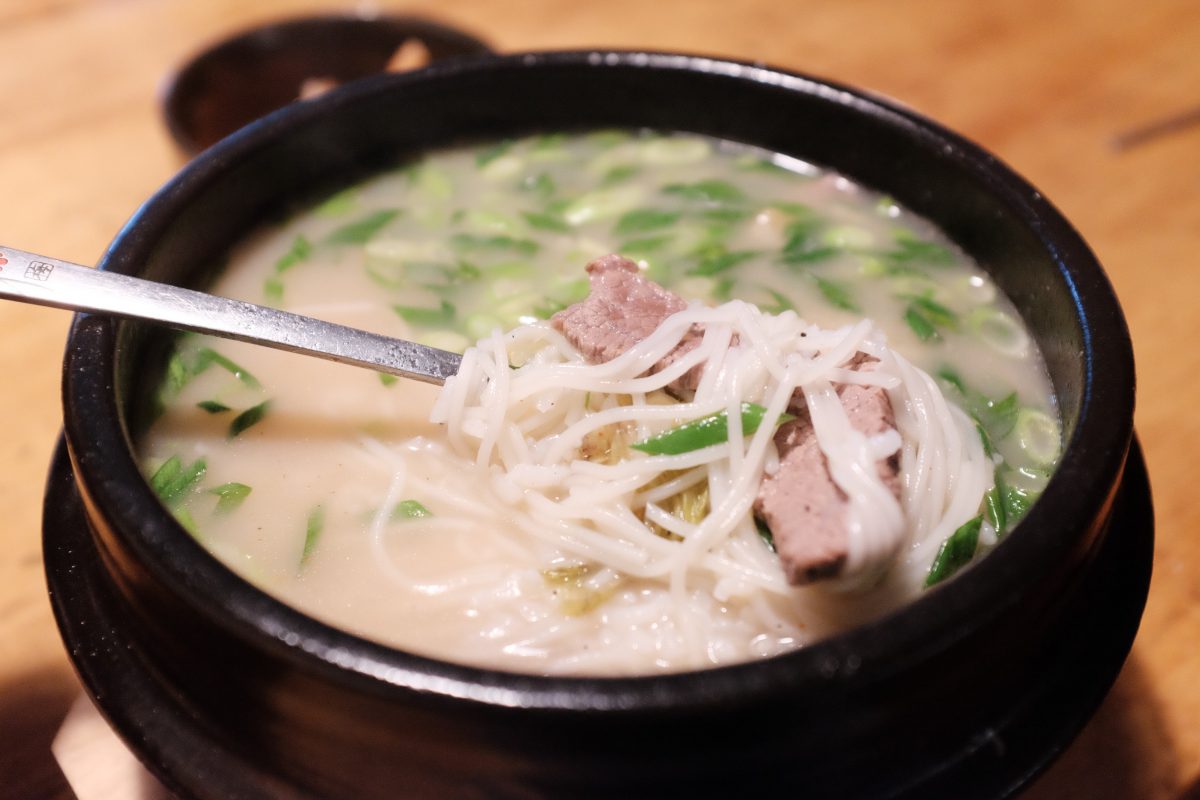
The verdict?
This turned out to be very very good. Maybe 4 out of 5 stars. One star off because, as good as it is, it doesn’t quite measure up to the flavour of Imun Seolleongtang in Seoul. But, honestly, I can say the same thing about all Korean food made outside of Korea. There is always a little something missing when you make these dishes yourself or, eat them in restaurants back home. I think a big part of this is the high quality of ingredients in Korea but, there is also generational knowledge and experience that adds flavour to these dishes and makes the magic hard to replicate. Imun Seolleongtang has been making this same dish for over 100 years and legend has it that the same stock pot has been continuously boiling fresh bones every day for the whole time!
Having said that, I am really happy with the way this turned out and I feel just as refreshed after eating a big hot bowl of this flavourful soup. 시원하다!
If you have any questions or comments please leave them in the space below. Thanks for reading!
Beef Bone Broth Version 2: Hard and Fast
Korean Beef Bone Broth vs Western Versions (hard and fast vs low and slow)
Some time ago, I posted a recipe for beef bone broth (stock) that involves a very long cooking time at a very gentle simmer (click here for this low and slow version). The result is a mostly clear, brownish, meaty and gelatinous stock. This is most often what chefs make in a western kitchen…it will typically be used as a soup or sauce base.
This recipe is almost identical in ingredients and process. The main difference is that this recipe cooks at a harder rolling boil for a shorter time. Even though the steps are almost identical, this small change results in a completely different stock. This one is just as gelatinous but, it is a silky opaque white colour with a nutty and delicate flavour. This stock is a base for dishes like mandu-guk (dumpling soup) or seolleongtang in a Korean kitchen. And, I think this is the version that most people think of when looking for “beef bone broth”.
Ingredients
- 4kg (almost 9lb) beef marrow and knuckle bones cut into pieces.
- 1.2kg (around 2.5lb) cow foot cut into pieces
- water
The Korean grocer in my neighbourhood usually has beef bones already cut up and frozen in bags ready to go. If you don’t have access to something like this, any butcher should be able to sell you beef bones for stock. A separate Halal butcher in the neighbourhood stocks frozen cow feet which he chops up for me on his meat saw. Cow foot adds gelatine to your stock which will give it a rich mouthfeel. If you can’t get cow feet, you can leave it out and substitute more bones.
The weights above are a guideline. You can make this as big as the biggest pot you have to hold the bones. I have a 12 litre stockpot and this is a good amount for me. The ratio of bone to cow foot does not have to be exact but I wouldn’t use more than 20-25% foot to bone.
There is no salt in this recipe. Season the stocks as you use it, depending on the dish you are preparing.
Process
This recipe is a slightly abbreviated version of the slow-and-low stock recipe. The process and ingredients are almost exactly the same so I have left out a few of the more obvious photos. If you want more detail on any step, just reference the recipe at this link.
Wash and soak bones
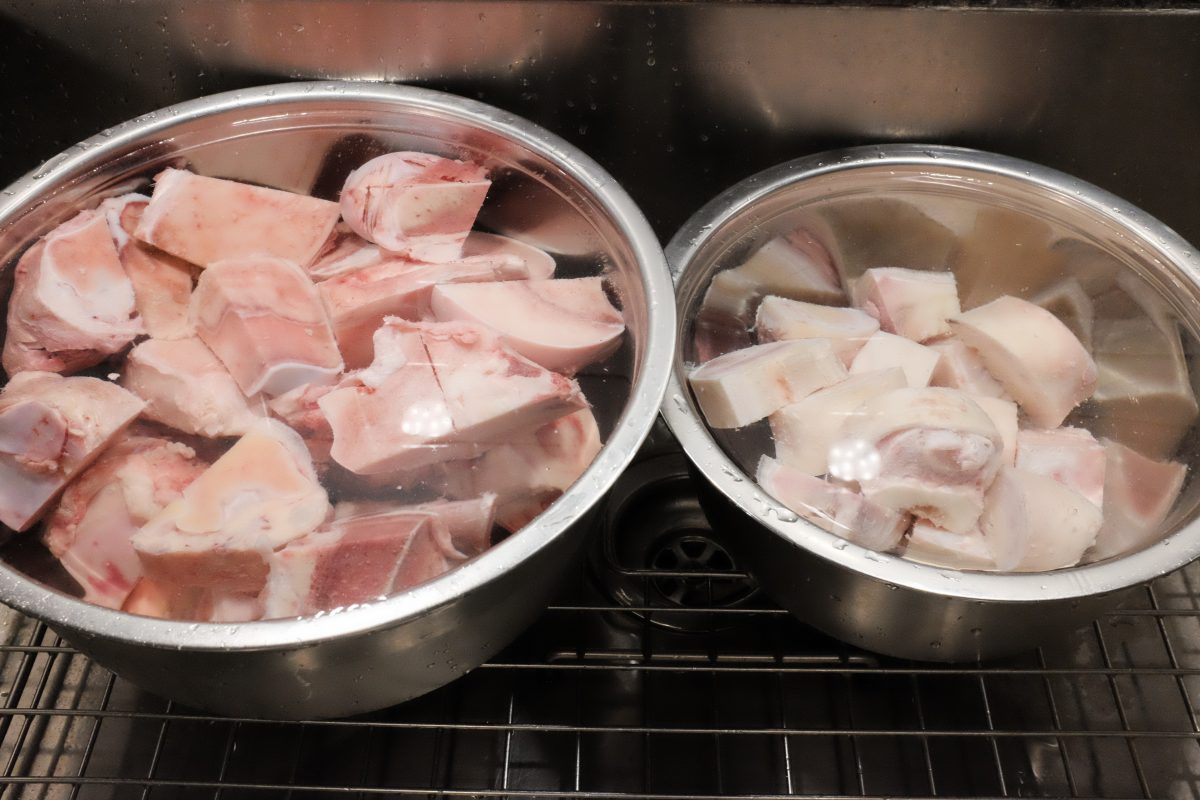
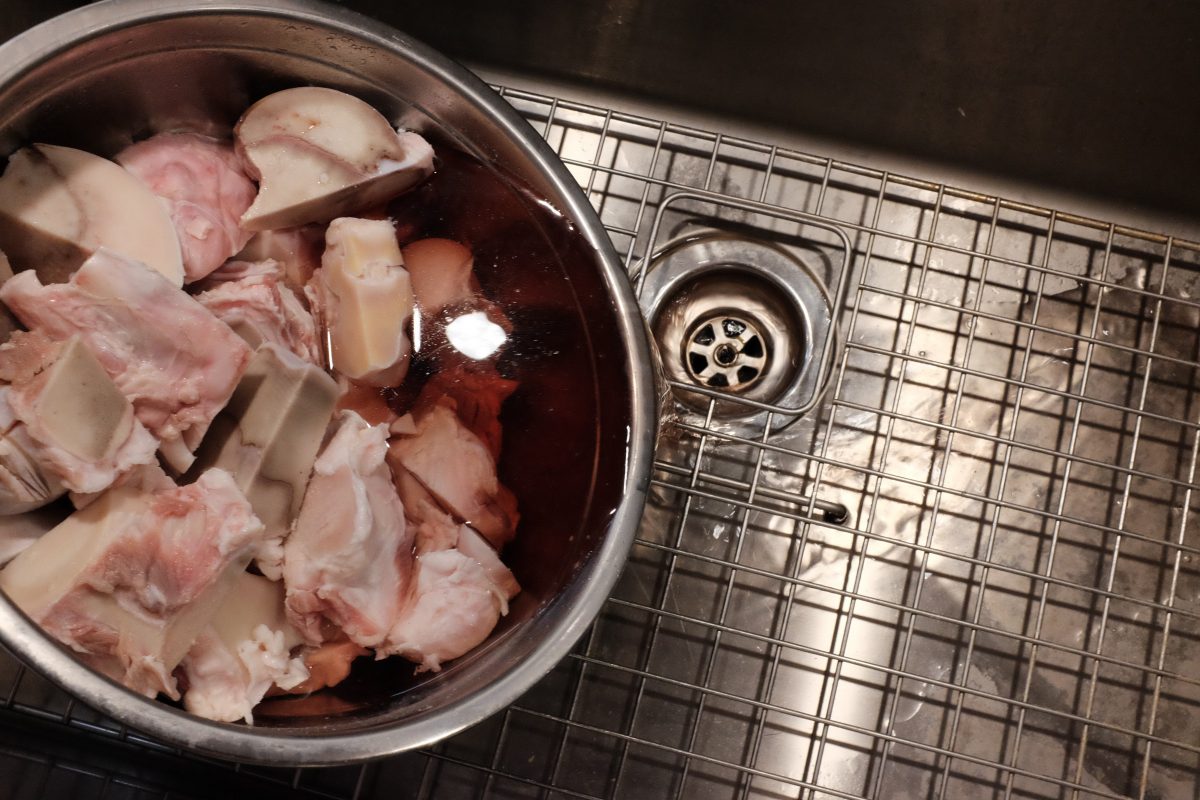
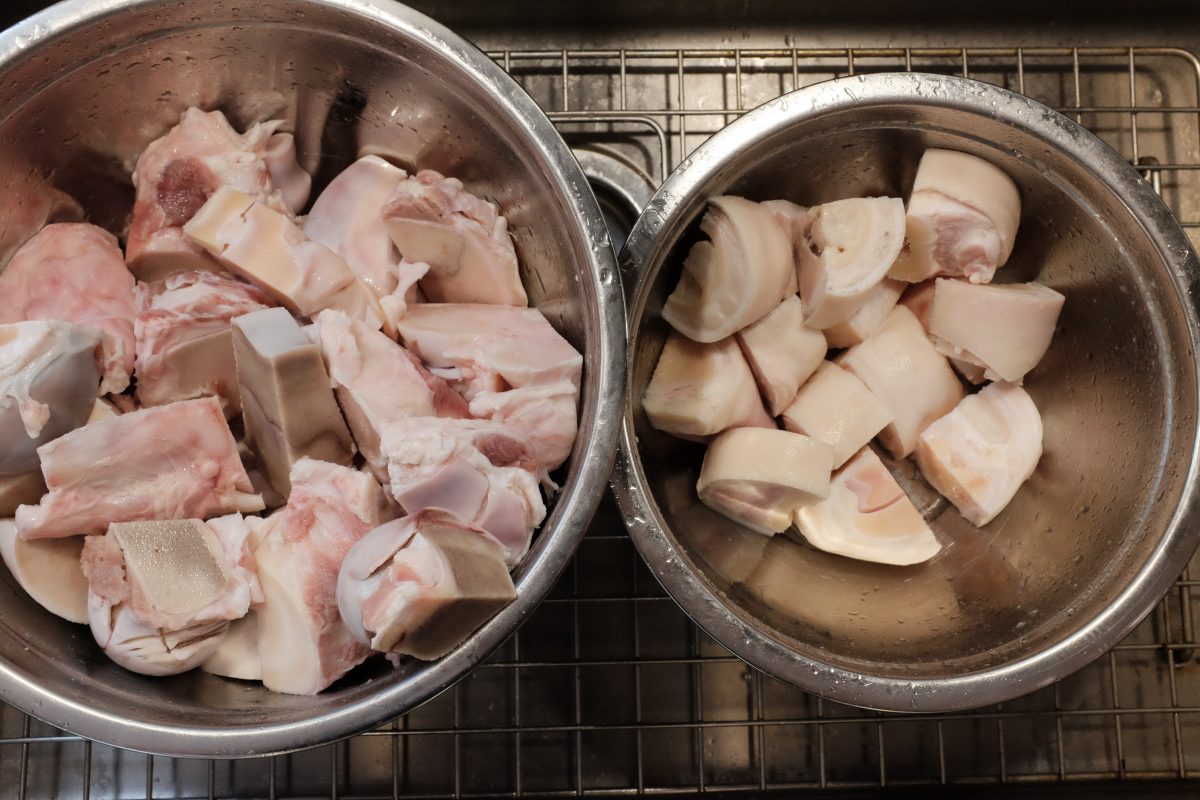
Blanching the bones
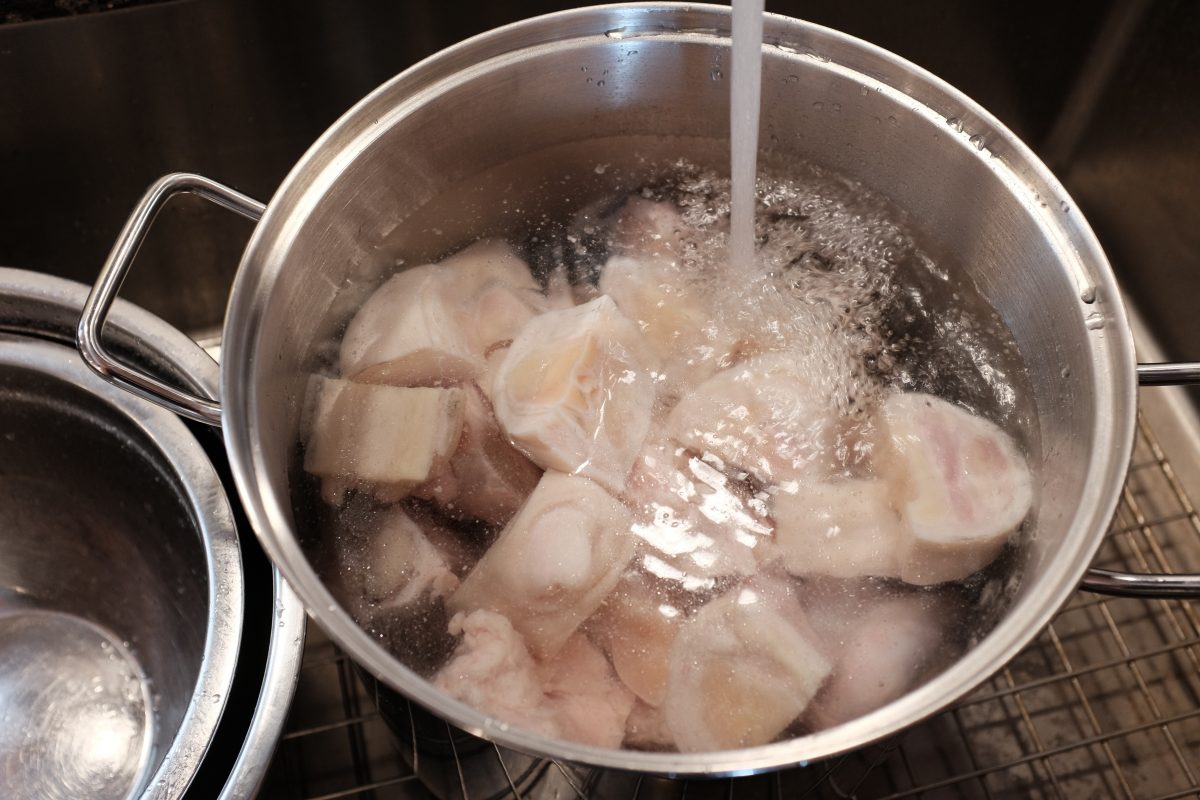
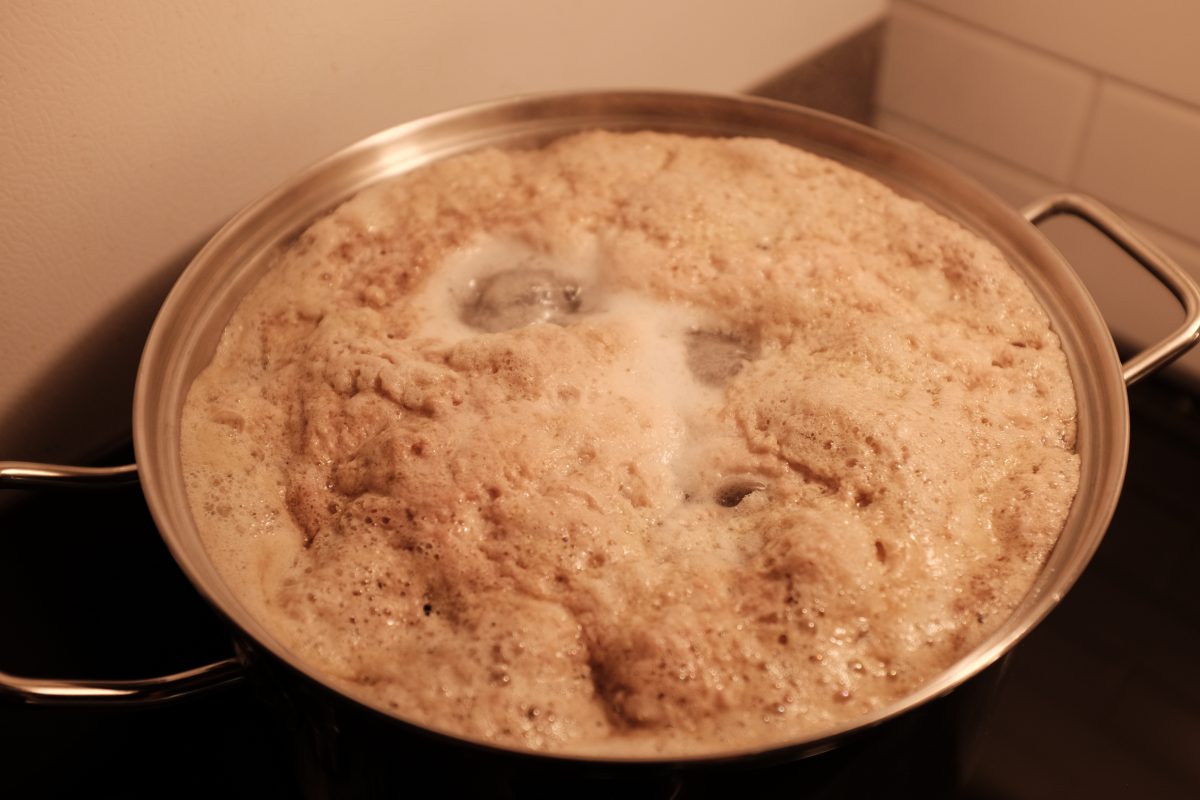
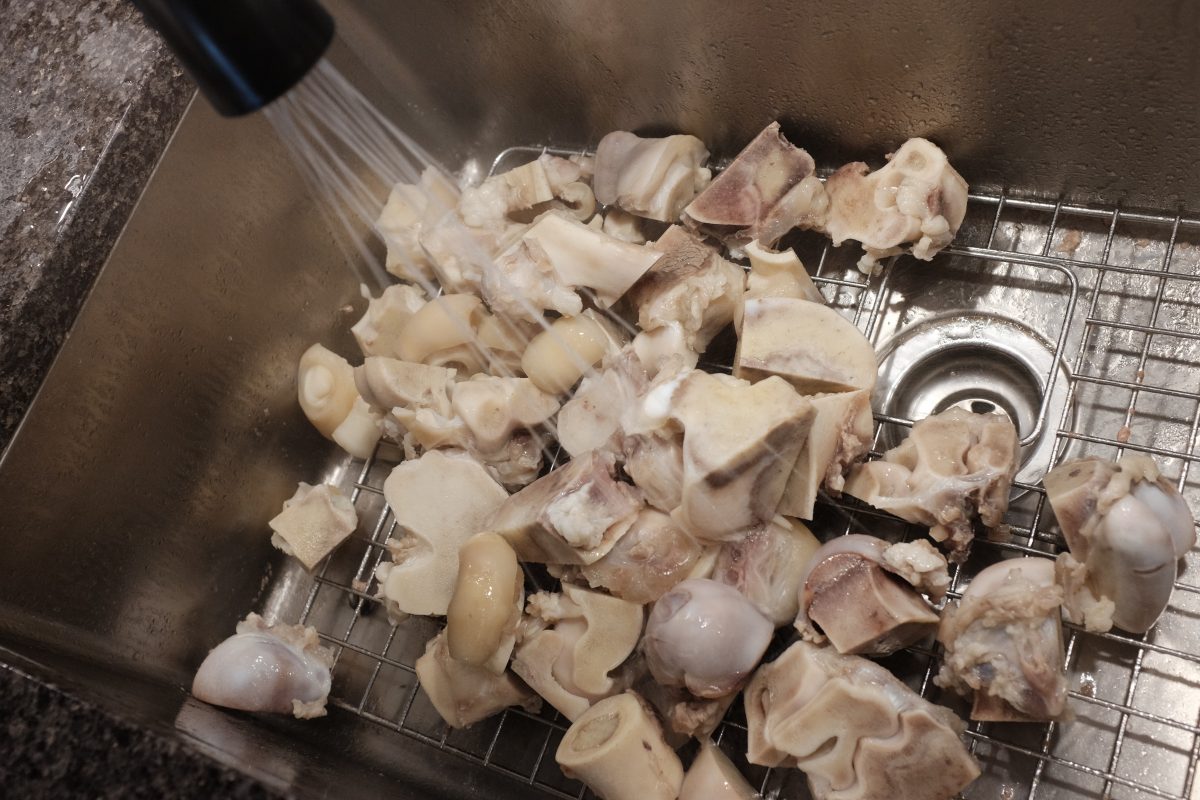
Making the stock
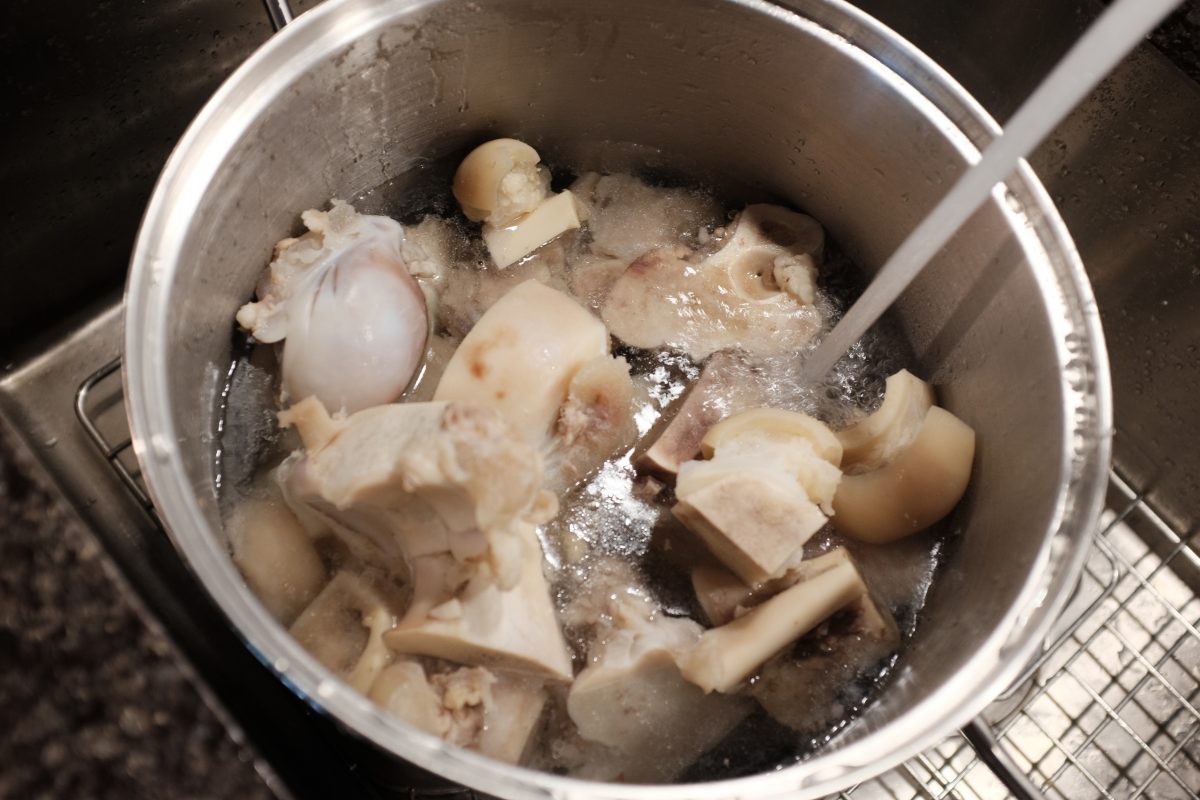
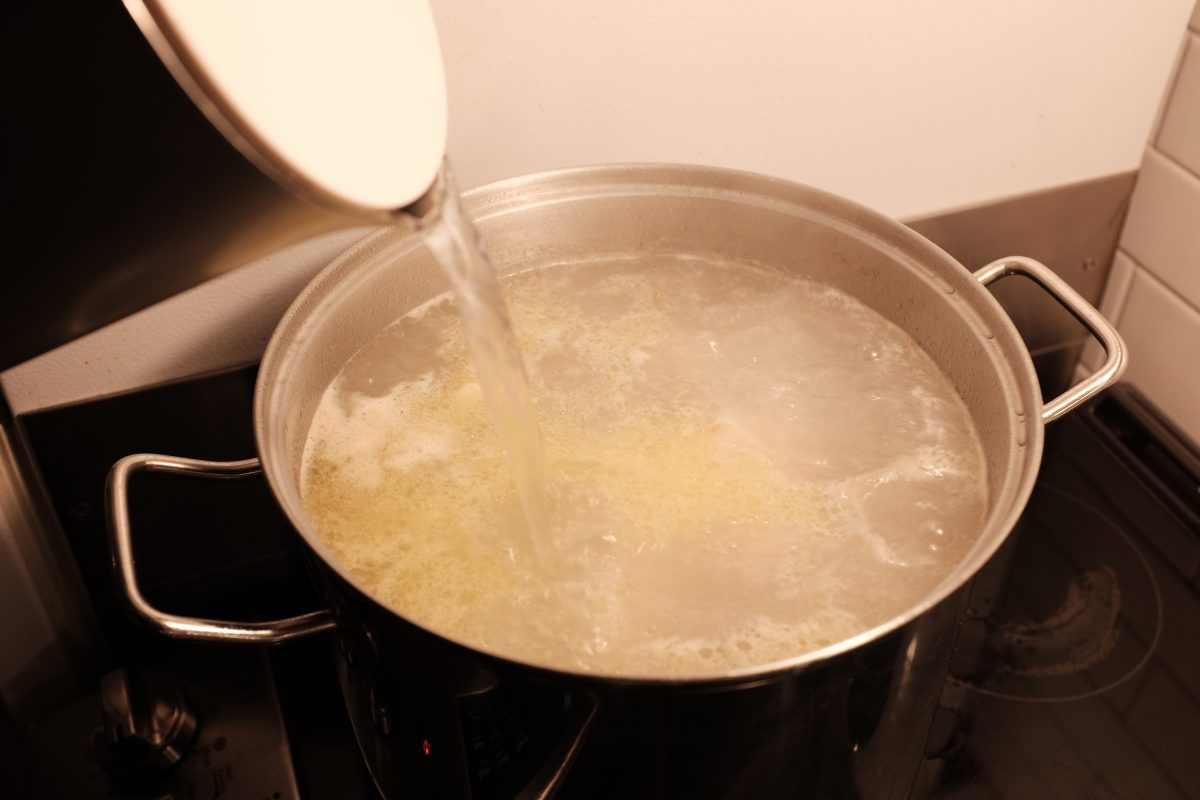
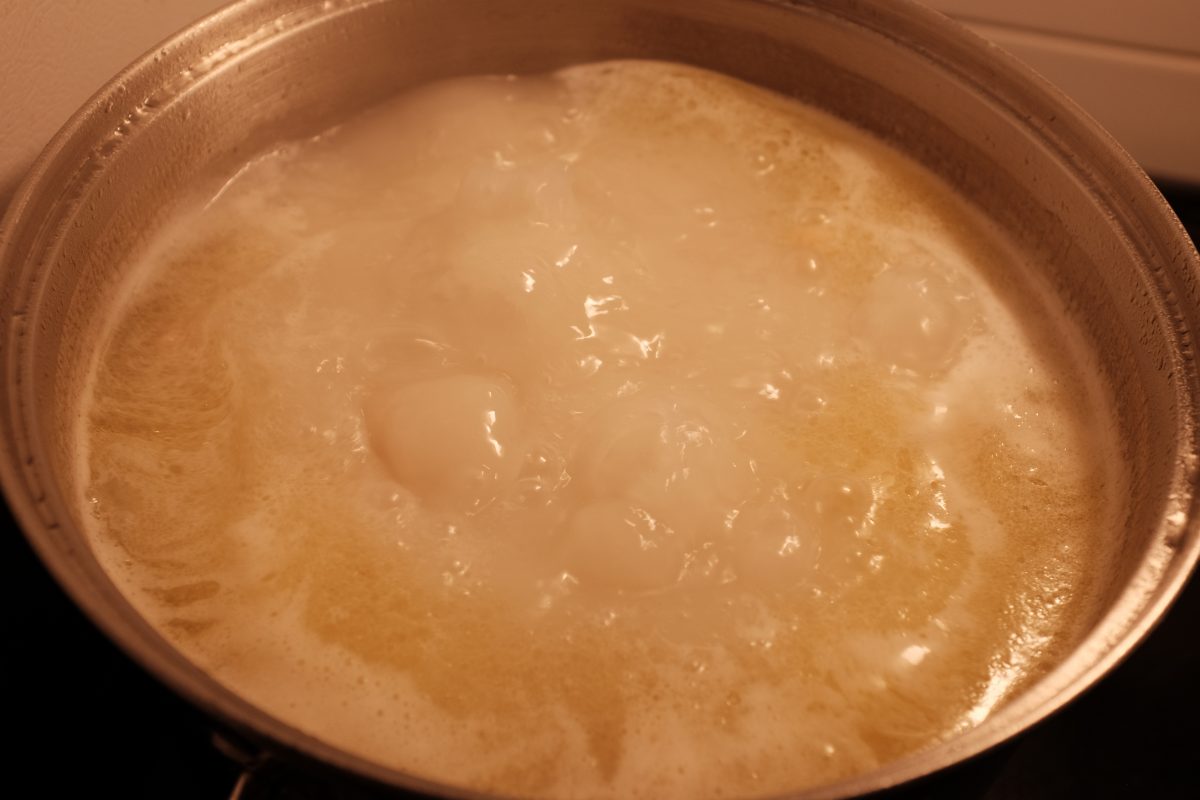
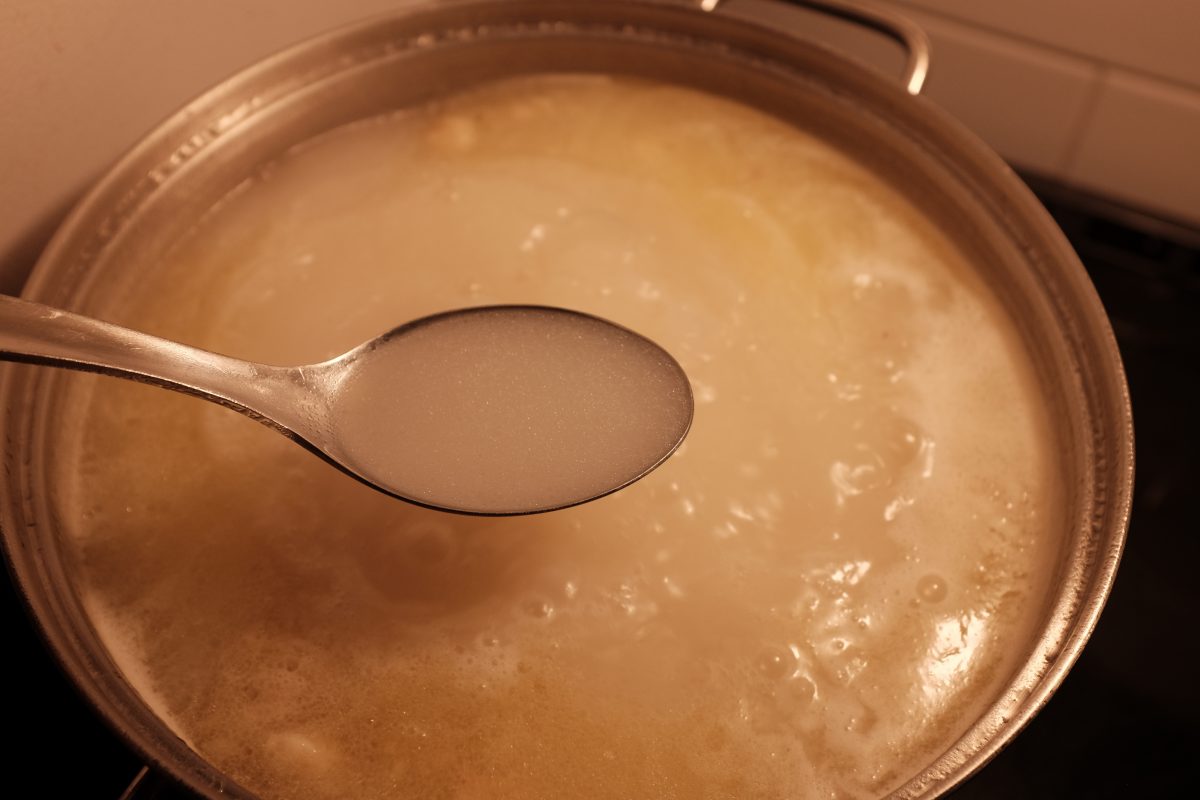
After 8 hours or so…
Remove the bones from the stock and strain the liquid.
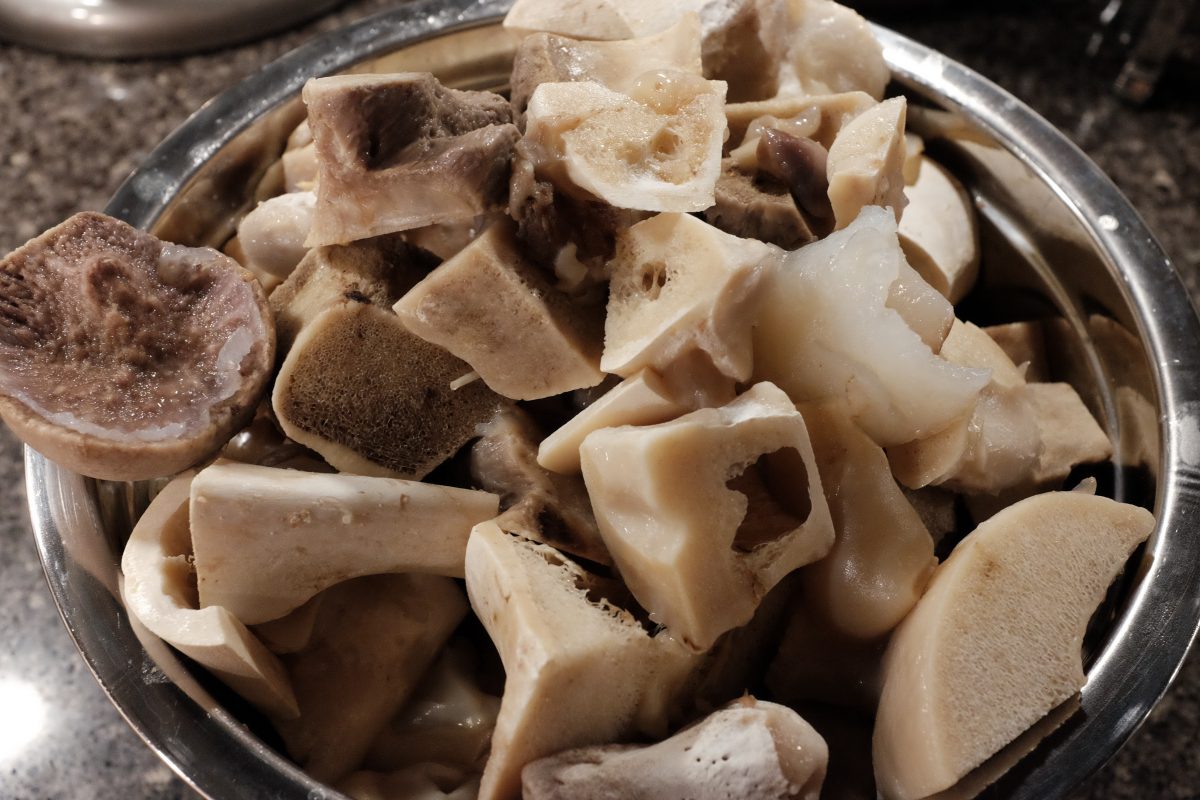
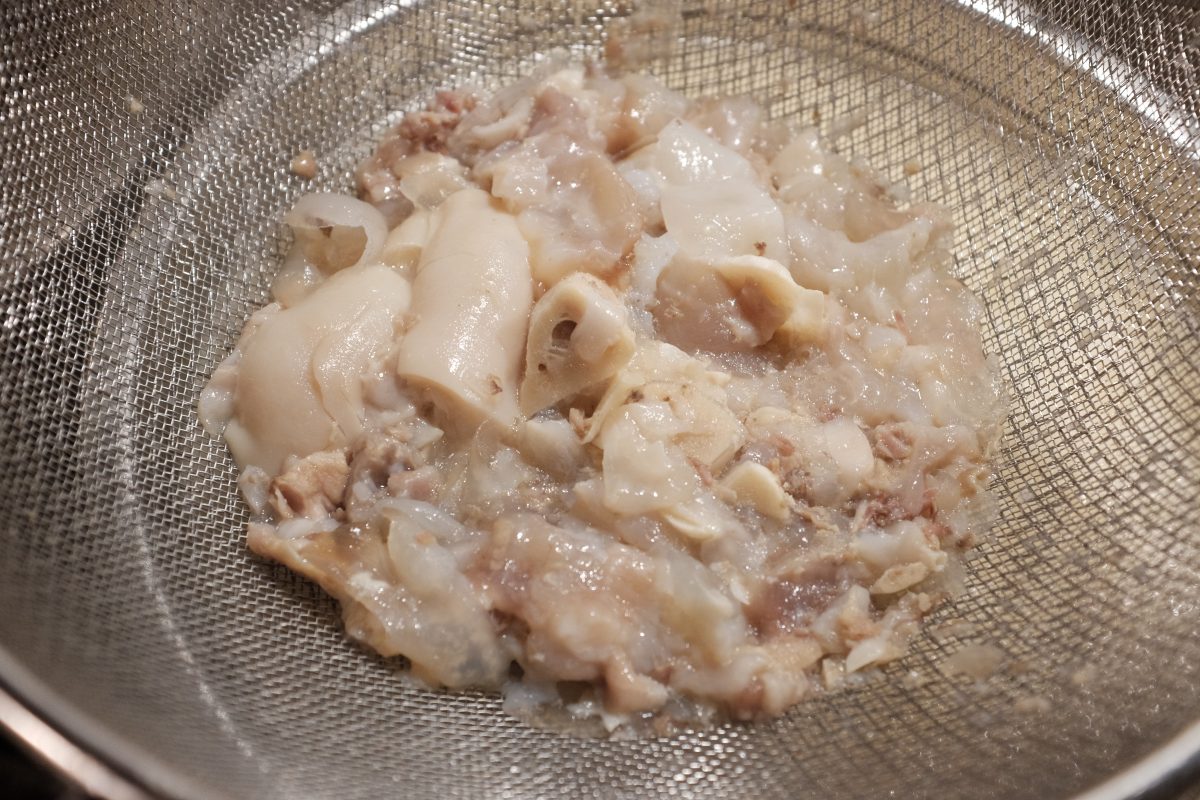
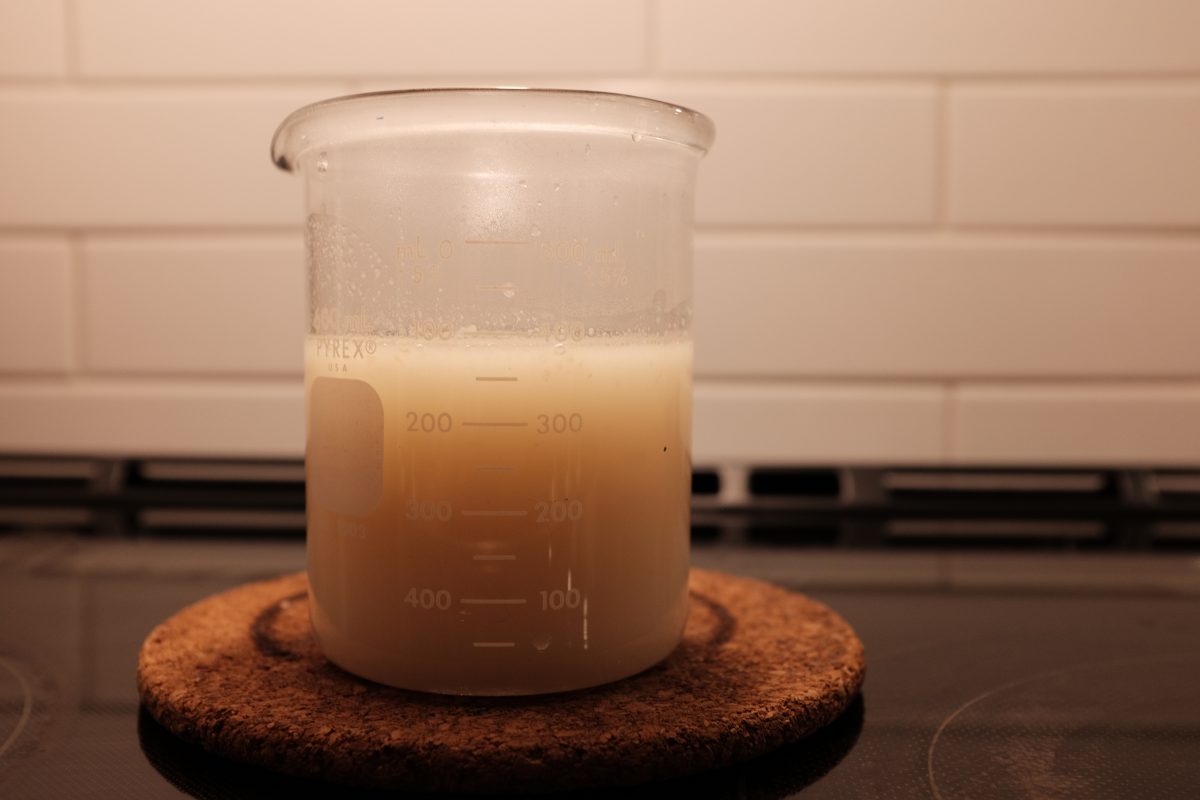
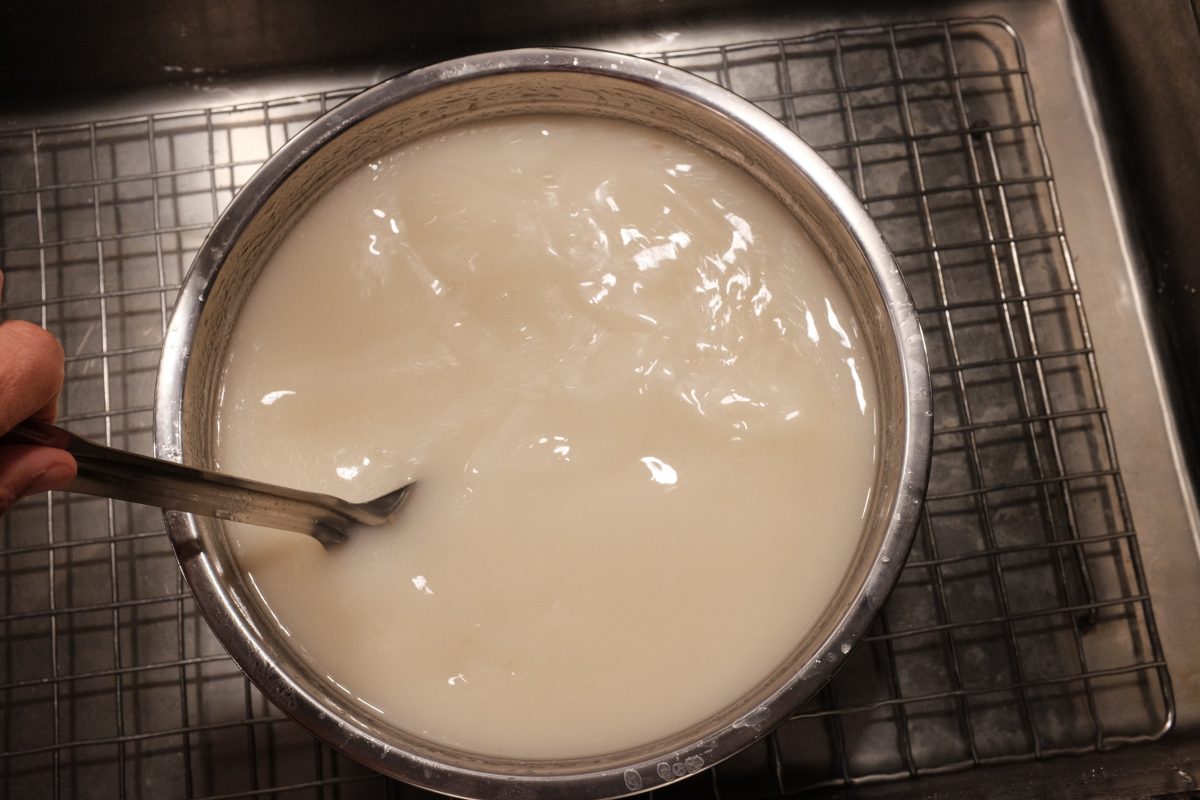
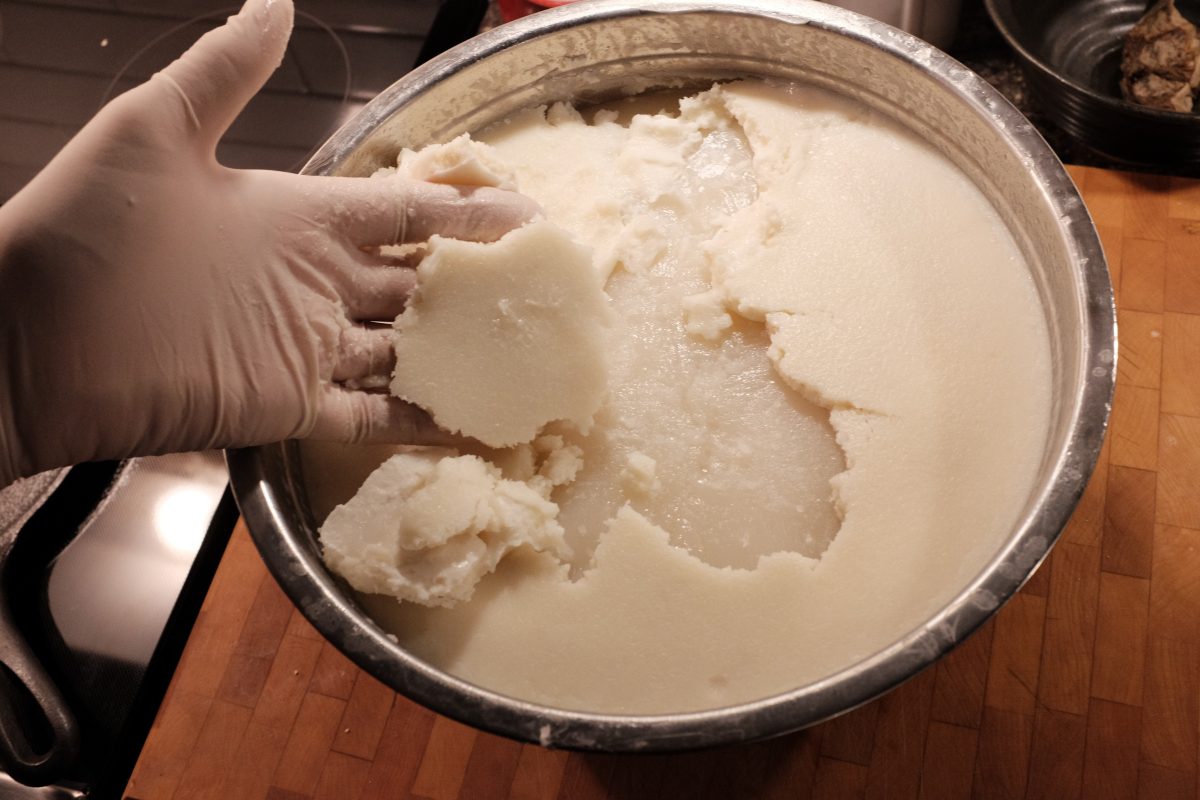
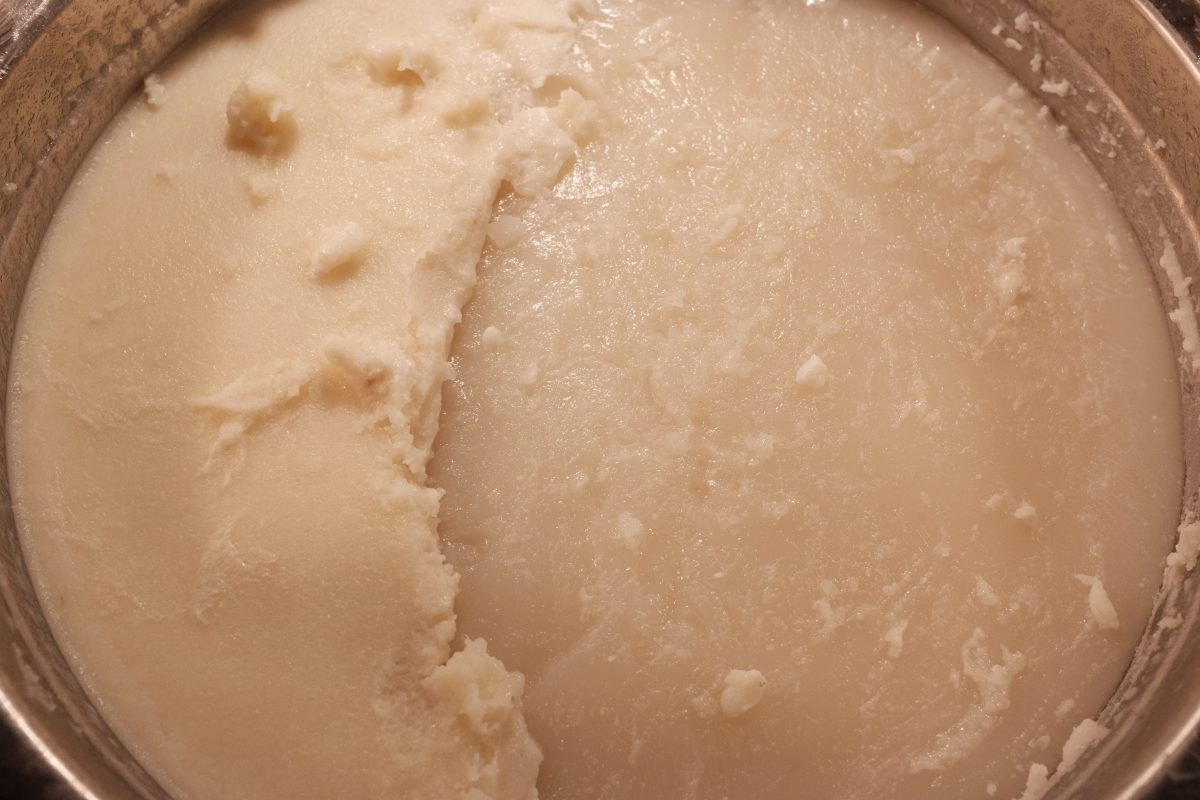
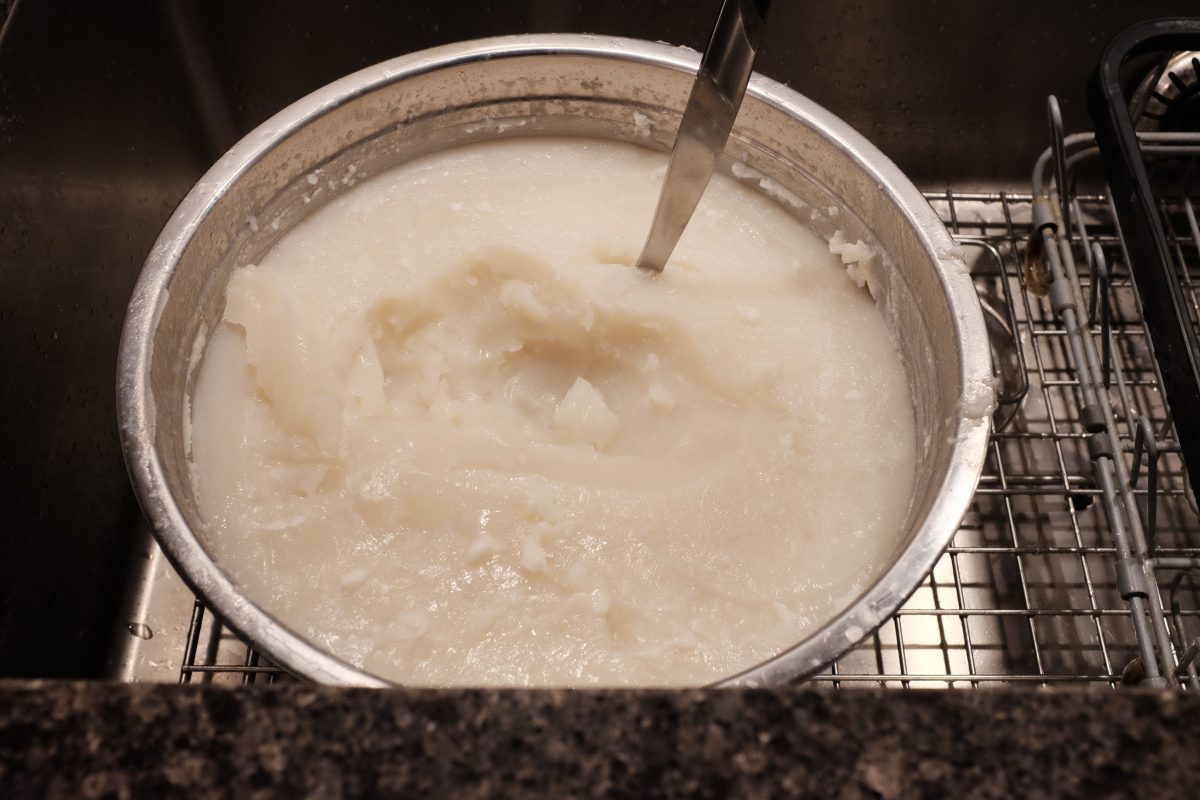
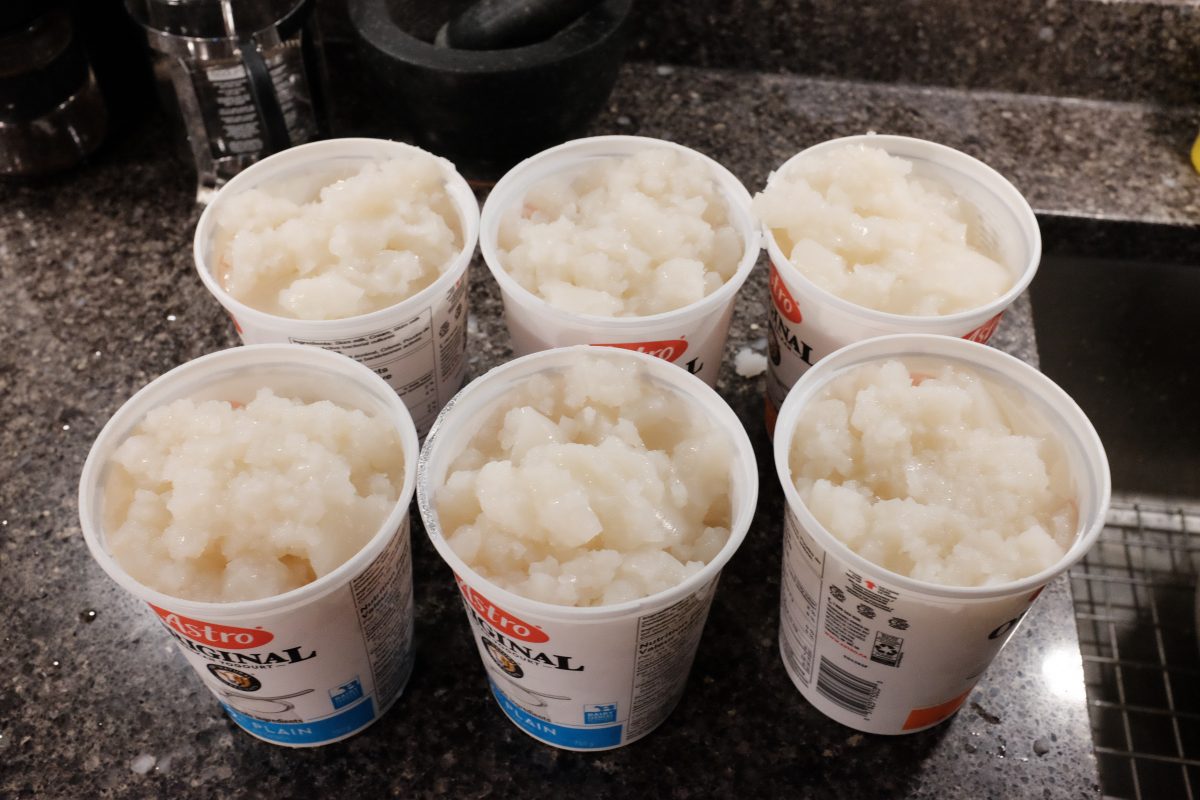
What to do with your bone broth (stock)
This is the essential milky base for Korean soups like seolleongtang (click here for recipe), doganitang or mandu guk. However, you can also use it as a base for almost any soup where you want good body and deep beef flavour. You can even drink it as is or add just a bit of cooked rice and chopped green onion for the simplest, easiest to digest, healthy and protein rich meal.
If you have any questions or comments or if I spelled Seolleongtang wrong, please let me know in the space below.
Jeow Bong
What is it?
Jeow bong (or jaew bong) is a Lao chili paste used as a dip or seasoning. It is powerful and complex: full of strong aromatics and potent citrus and fruit flavours, all tied together with fermented fish sauce.
One summer at the restaurant we had a food runner who’s mom was from Laos. We became pretty good friends and her family ended up visiting for a meal a few times. I had fun preparing interesting veggie dishes (off menu) for her vegetarian dad and sister.
Afterwards, on more than one occasion, her mom sent me homemade Lao beef jerky and other little snacks. One time I even got a full dinner-set of larp, sticky rice, sides and, of course, jeow bong! This was my first experience with Lao food and I was hooked.
Sometime before our food runner left to go to university, she brought me my own bamboo sticky rice steamer and pot set with a couple of little rice baskets. This was such a thoughtful gift and I use them often. Thanks Tounie, Émilie and famille Desrosiers!
Jeow bong recipe:
First let me say that although I am a professional chef, I am no expert at Lao cooking. I have learned to make a few dishes because I like them so much but I am still learning. When I looked around the internet for recipes, I found many different recipes for jeow bong. I pulled from a few of them, combining ingredients that I can easily get in my neighbourhood. Many recipes include pig skin as an ingredient but I left it out of this recipe only because I didn’t have time to pick it up. This recipe turned out very well without it but next time I may try with pork included.
Ingredients
- 10 cloves garlic
- 4 medium shallots
- around 25 grams fresh galangal (one thumb-size chunk)
- 20 grams dried chilis
- 60ml (1/4 cup) of water
- olive oil for frying (1-2 tablespoons)
- 30ml (2 tablespoons) fish sauce
- 6 kaffir lime leaves
- 25 grams tamarind paste (a little less than 2 tablespoons)
- 1 teaspoon MSG or Aji-no-moto (same thing, different name)
- 1 tablespoon palm sugar (or use regular white sugar)
Process





















Now what?
Store the paste in an air-tight container in the refrigerator.
You can use your jeow bong as a dip for meats or veggies or mix it into stir fried dishes. Or, try swiping a little onto a ball of warm sticky rice and popping it into your mouth. This is my favourite way to eat it.
Go easy with this stuff. It is surprisingly powerful!
If you have any comments or questions, please feel free to leave them below.
Thanks for reading : )
Cold Chickpea Salad
This is a recipe for a cold chickpea salad base. You can eat it just as it is here. It is delicious. But, you can also add just about anything you like to make the recipe suit your personal tastes. If you want to eat it over a few days, it is easy to add different ingredients to change it up. The ingredients I am including in this basic version can sit for a few days in the oil and vinegar dressing without degrading.
When I was little, especially in summer, there was always some kind of homemade cold salad in the fridge. Potato salad, pasta salad, egg salad… My new-Canadian parents refused to use air conditioning (or the dishwasher haha) so it was always nice to have something ice cold to snack on in the hot and humid weather! This recipe is the latest variation and I ate it at mom’s house recently.
Chickpeas are a great source of cheap protein, fibre, vitamins and minerals. And they taste great!
Ingredients:
- 400gr (2 cups) dry chickpeas
- 1/2 red onion small dice
- 1 red pepper small dice
- 3 green onions (scallions) sliced
- 1 carrot
- 2 cloves of garlic minced
- 2 Tablespoons hot chillies in oil (or chopped fresh chillies)
- 2 Tablespoons diced dill pickles
- 90-100ml (6 tablespoons) olive oil
- 45-50ml (3 tablespoons) vinegar
- 1-2 teaspoons salt
- 1-2 teaspoons black pepper
- 3 teaspoons ground cumin (optional)
I am using dry chickpeas because I like the flavour and texture. Soaking and cooking them is very easy but it takes a little more time. Feel free to substitute an equal amount of canned chickpeas. Just be sure to rinse them thoroughly in cold water to remove all the slippery brine.
Use a good extra virgin olive oil. I have used apple cider vinegar in this recipe but any good vinegar works. As for the chillies, I am using delicious chopped red chillies in olive oil which I recently found at a local Italian grocery. You can substitute with any fresh chopped chilli or leave them out if you don’t like the heat.
Process
Before anything else, we need to rehydrate (soak) the dry chickpeas.












Variations
As I mentioned at the start, I keep this basic recipe limited to the veggies that will be able to sit in the oil and vinegar for a few days without spoiling. Feel free to add anything you like to this starting recipe just before eating.
Some other things I have used:
- blanched or raw asparagus
- corn
- zucchini
- celery
- chopped kimchi
- diced sour apple
- parmesan cheese
- any and all fresh herbs
- crispy diced bacon
- tobasco, cholula or any other hot sauce
This kind of a salad is a good match for any picnic foods and especially grilled meats. And, although it is a cold salad, there is no reason why you couldn’t heat it up in a pan and serve it hot as well. As a warm dish, I think it would work perfectly under a piece of grilled fish.
Hope you enjoy. If you have any questions or comments or interesting variations, please leave them below. I am always happy to hear from you.
Bossam Leftovers: Pork and Vegetable Udon
Bossam Part 2:
Earlier I put up a recipe for a simple bossam. Towards the end, I mentioned that if you go easy on the salt in the braising liquid, you can use it to make another delicious pork dish. This is what I have done with the leftover braising liquid from that recipe: Pork and Vegetable Udon. This recipe made one huge portion but could very easily make 2 portions by adding more noodles.
Ingredients:
- Leftover braising liquid from Bossam recipe
- Leftover pork meat (if any) thin slices
- 1/2 onion sliced thin (the other half of the onion from the Bossam recipe)
- 3 cloves garlic sliced thin
- 2 green onions/scallions chopped
- 1 fresh green chilli pepper sliced into thin rounds
- 1/2 zucchini sliced thin
- 1/2 package of enoki mushrooms
- 1 cup green cabbage sliced thin
- 1 or 2 portions frozen udon noodles
I am using vegetables that I have in my refrigerator at the moment. You can substitute just about any vegetable you would normally put in a soup. You can use different mushrooms too. Different noodles could work as well. I like these Udon noodles. I usually find them at the neighbourhood Asian grocery store in the freezer section. They are convenient because they are frozen in single portions. If you don’t have leftover pork meat, don’t worry. The braising liquid has plenty of delicious pork flavour on it’s own. Sub in some extra mushrooms. I had enokis on hand but sliced king oyster mushrooms are even better!
Process









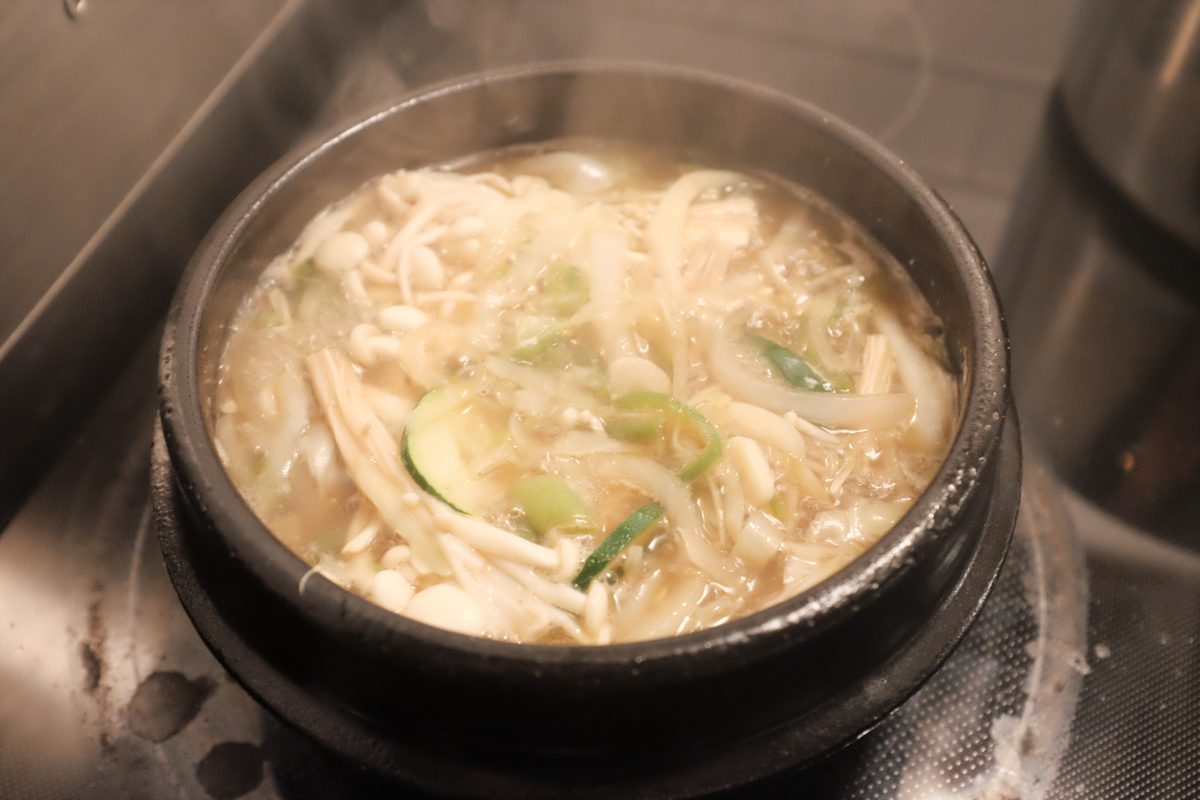


This took almost no time at all…
I think this probably took around 15 minutes to make. The leftover braising liquid from the bossam recipe is a perfect, rich and complex broth to cook vegetables and noodles in. This was a delicious meal that used up every last leftover from the previous night.
If you have any questions, comments or other ideas please leave them below. I always look forward to hearing from you.
Bossam Braised Pork Belly
This is a very basic version of bossam. The main event here is the meat. Fresh pork belly is braised in a liquid made with strong aromatics to flavour the meat and to soften some of the gamey aroma of the pork.
It can be served with kimchi and various sides, wrapped in a leaf of cabbage, perilla or lettuce.
There are a couple of good recipes here and here which include all the components for a more traditional Korean preparation with pickled Napa cabbage leaves and spicy shredded radish. This is a delicious way to eat it but I am going to do something a little different with things I already have in the refrigerator.
Ingredients for Braised Pork
- 1 kg (around 2.5lb) pork belly
- 1 small chunk (25gr) fresh ginger sliced
- 12 garlic cloves roughly chopped
- 1/2 onion
- 2 green onions roughly chopped
- 30ml / 2 tablespoons doenjang
- 15ml / 1 tablespoon instant coffee
- 1 tablespoon whole black peppercorns
- 1.5 litres / 6 cups water
Other Ingredients:
Once the pork is done, you will need something leafy to wrap it in. You may also want to add other fillings to your pork wraps. This can be anything from kimchi to fresh crunchy veggies. Sometimes I even like a little bit of nice mustard in them. This time around, I will use:
- red leaf lettuce, washed, dried and separated into leaves
- perilla leaf (kkaennip) washed and dried
- napa cabbage kimchi
- Korean radish kimchi or (kkakdugi)
- pan fried anchovies with peanuts (myeolchi bokkeum)
Process










Serving
Serve the pork slices with sides of your choice and leaves to wrap it with.


What about the leftover braising liquid?
Store any leftover meat in the braising liquid. Reheat it covered in the liquid as well.
The first time I made this, I noticed that the leftover braising liquid is actually very tasty. You can’t really notice the coffee as a distinct flavour. The liquid is just a warm and delicious pork and doenjang flavour. The only problem is that it is a little too salty.
The next time I made it, I decided to remove extra salt from the recipe, using doenjang only as the main seasoning. The meat is still delicious and can be salted a little after cooking if you think it needs it. But, keep in mind, you are also eating this with kimchi or maybe salted shrimp or other well seasoned add ons so very salty meat is not so necessary.
Once you reduce the salt, you are left with a delicious pork soup base. When the meal is done, I usually strain out all the solids and refrigerate it. The next day I combine it with shredded cabbage, the other half of the onion, mushrooms and frozen udon noodles, a little of the leftover pork and chopped scallions. It is surprisingly delicious! Find that recipe here.
If you have any questions or comments, please leave them below. Look forward to hearing from you.
Beef Bone Broth Version 1: Low and Slow
Broth vs Stock
I am calling this a “Beef Bone Broth” only because it seems to be the name that everyone is using these days. It makes a perfect base liquid for any number of soup or sauce recipes although it also has many other uses.
In professional cooking, a “broth” is a usually a lighter, thinner, and often salted liquid made by boiling vegetables and/or meat for a relatively short time. A “stock”, in contrast, is made from bones and their connective tissue, simmered for a very long time, sometimes with vegetables and aromatics, usually without salt. A broth is a thin and flavourful liquid while a stock is a thick, gelatinous and relatively flavourless liquid (until it is seasoned).
So..as you will see, what we are making here is nothing like a broth. It is a very simple beef stock.
Long, Low and Slow vs Hard and Fast
This recipe is for a long, low and slow method that cooks until the bones have nothing left to give. The end result is a mostly clear, slightly brown stock. It is thick and gelatinous, even slightly sticky. If you added mirepoix (say onions, celery, carrot) to this later in the process, you would end up with something like a Western white veal/beef stock.
The second one (click here for other version) is a hard boil and relatively fast stock (for beef bones). It will still take several hours but, it will result in a milky white broth with a nutty flavour and slightly thinner consistency. This is what you will often see in Seolleongtang or Mandu Guk (dumpling soup) in Korean restaurants.
Ingredients
You can make this as large or small as you like. I have made a recipe that fits into my biggest stock pot which holds around 12 litres / 3 gallons. Just make sure that the pot is big enough to keep bones submerged plus a little water on top.
- 4 kg / 8lb cut beef hip bones (this is usually a mix of marrow bones and knuckle bones)
- 1.5 kg / 3lb cut cow foot
- fresh cold water to cover them
My local Korean grocer keeps bags of cut beef bones in the freezer section all the time. And, there is a butcher near me that usually has frozen whole cow feet as well. Any butcher shop should be able to get you beef hip bones for stock. The cow foot is optional but it is made of of mostly connective tissue and this will add body and richness to your finished stock. If you can’t get cow foot, just omit or replace with regular hip bones.
Process
Wash and Soak






Initial Boil (blanching)





Simmering the stock





32 hours later….





Cooling and Storage

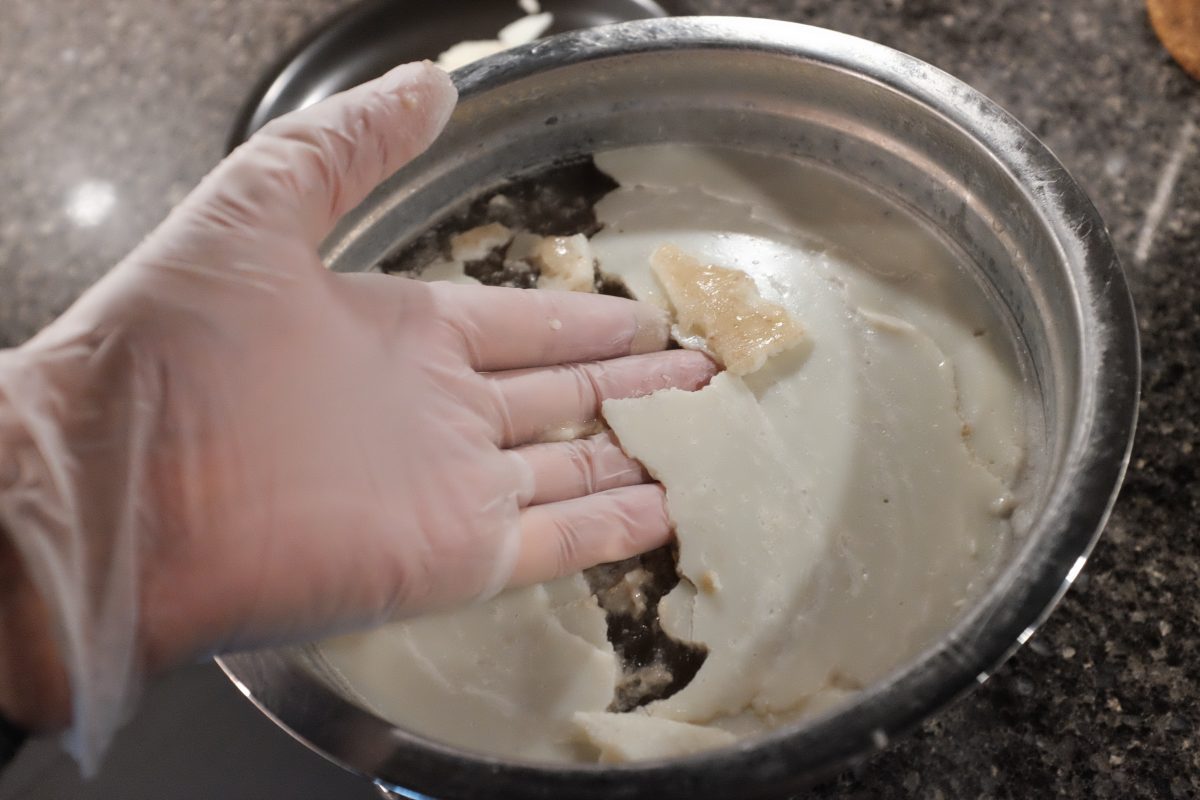



How to use your Beef Bone Broth
Simmer any combination of meat/vegetables/mushrooms in it for a delicious soup. Add your favourite noodles to it. Or, you can simply warm it up and add rice and seasoning. You can even drink it as is for a deeply nutritious and filling liquid snack.
This beef bone broth (stock) is a liquid rich in body and texture that is mostly neutral in flavour…a base for almost anything you can imagine. Soup, stew, sauce, smoothie…anything goes. If you have any recipe that has water as an ingredient, replace it with this stock to improve the flavour and the nutritional value. As I cook with this new stock, I will post up ideas as I make them.
Beef and Radish Soup: Muguk
Korean beef and radish soup, or sogogi muguk, is a flavourful and nutritious soup which is easy to make quickly. There are only a handful of ingredients and everything is cooked in one pot.
Ingredients
- 150gr (5-6oz) beef brisket point sliced thinly against the grain
- 250gr (8oz) Korean radish
- 15ml (1 tablespoon) sesame oil
- 5 or 6 cloves garlic sliced thin or minced
- 15ml (1 tablespoon) Korean soup soy sauce (gukgangjang)
- 2 or 3 green onions (scallions)
- 750ml (3cups) water approximately
- salt and pepper
I used beef brisket in this recipe because I can get it easily and I like that it is lean and tender at the same time. If you can’t get brisket, you can use almost any other good cut of beef. Lean cuts from the round will be a little chewier but still delicious: cut them thin. If you want to put premium steak cuts in here, go right ahead. I have even made this with ground beef in a pinch.
Don’t use regular soy sauce. Korean gukganjang or soup soy sauce can be found at any Korean grocer. Regular soy sauce is a poor substitute. If you can’t find soup soy sauce, substitute with a good quality fish sauce.
The meat to radish proportion can vary. This one I am making has a pretty generous amount of meat. Feel free to use a little less or, even more if you want to load up on protein.
Process










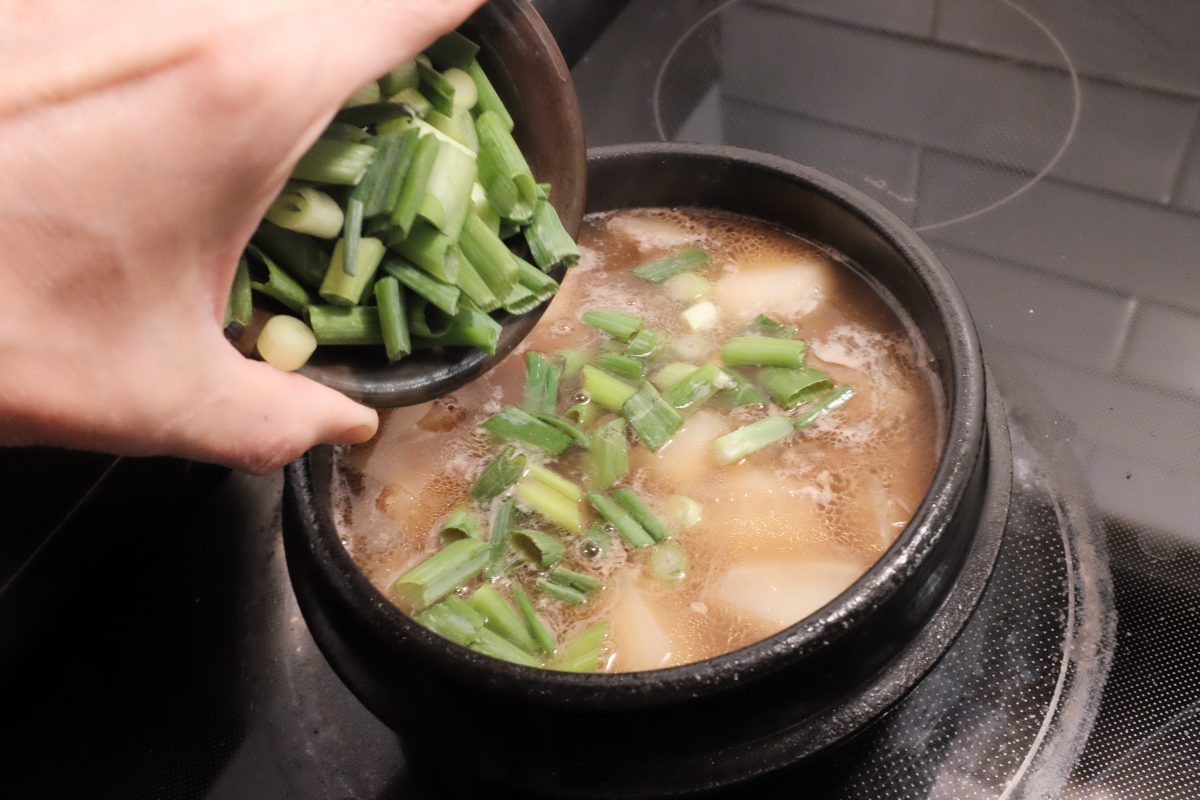

I like to eat this with a bowl of rice and a couple of sides. Today I am having home made kimchi and a cucumber salad. I made kkakdugi yesterday but it is not quite ready yet. Otherwise I would eat it with this dish : )
This recipe will make enough for two medium portions or one very large portion.
If you have any questions or comments, please leave them below. I love to hear from you.